Äîêóìåíòàöèÿ è îïèñàíèÿ www.docs.chipfind.ru
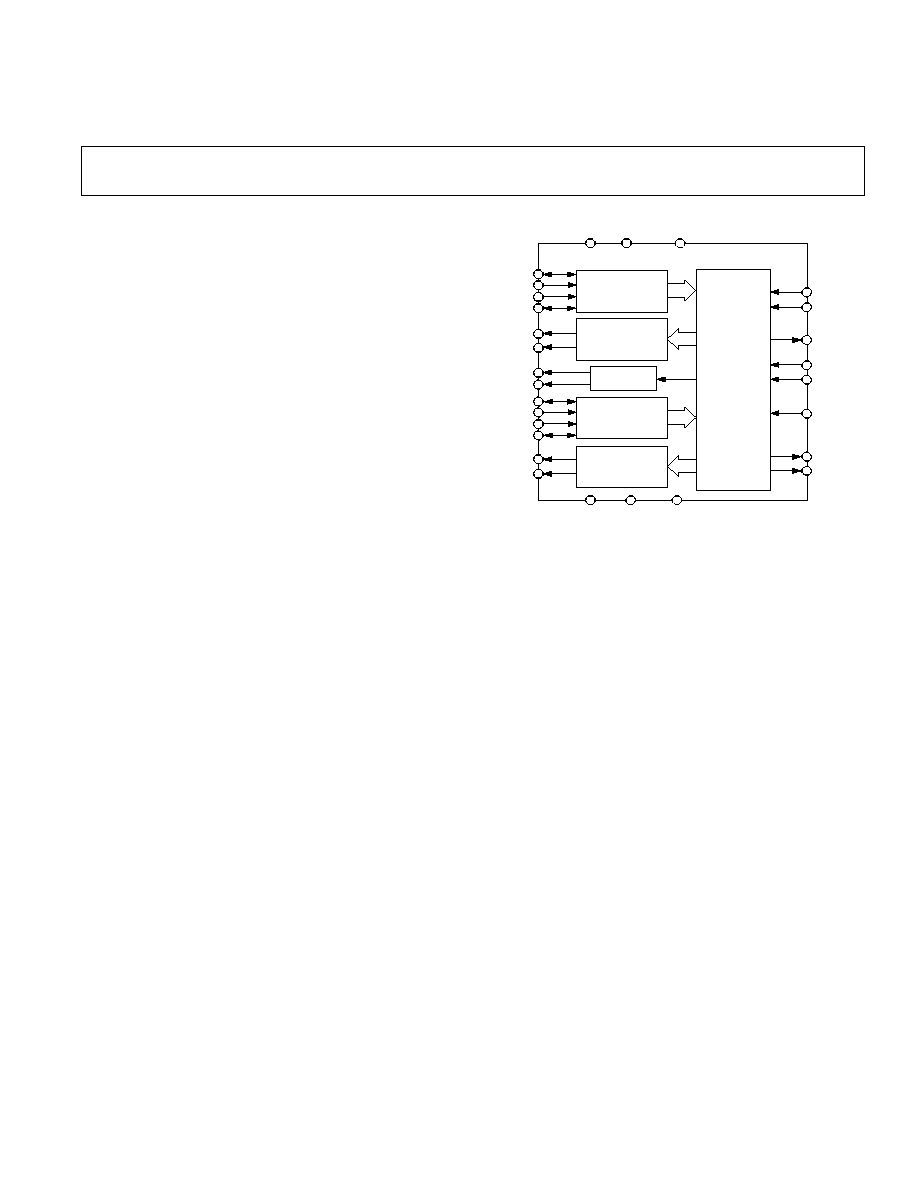
REV. B
Information furnished by Analog Devices is believed to be accurate and
reliable. However, no responsibility is assumed by Analog Devices for its
use, nor for any infringements of patents or other rights of third parties
which may result from its use. No license is granted by implication or
otherwise under any patent or patent rights of Analog Devices.
AD73322
One Technology Way, P.O. Box 9106, Norwood, MA 02062-9106, U.S.A.
Tel: 781/329-4700
World Wide Web Site: http://www.analog.com
Fax: 781/326-8703
© Analog Devices, Inc., 2000
a
Low Cost, Low Power CMOS
General-Purpose Dual Analog Front End
FEATURES
Two 16-Bit A/D Converters
Two 16-Bit D/A Converters
Programmable Input/Output Sample Rates
78 dB ADC SNR
77 dB DAC SNR
64 kS/s Maximum Sample Rate
90 dB Crosstalk
Low Group Delay (25
s Typ per ADC Channel,
50 s Typ per DAC Channel)
Programmable Input/Output Gain
Flexible Serial Port which Allows Up to Four Dual
Codecs to be Connected in Cascade Giving Eight
I/O Channels
Single (+2.7 V to +5.5 V) Supply Operation
73 mW Typ Power Consumption at 3.0 V
On-Chip Reference
28-Lead SOIC and 44-Lead LQFP Packages
APPLICATIONS
General Purpose Analog I/O
Speech Processing
Cordless and Personal Communications
Telephony
Active Control of Sound and Vibration
Data Communications
Wireless Local Loop
FUNCTIONAL BLOCK DIAGRAM
GENERAL DESCRIPTION
The AD73322 is a dual front-end processor for general-purpose
applications including speech and telephony. It features two
16-bit A/D conversion channels and two 16-bit D/A conversion
channels. Each channel provides 77 dB signal-to-noise ratio
over a voiceband signal bandwidth. It also features an input-to-
output gain network in both the analog and digital domains.
This is featured on both codecs and can be used for impedance
matching or scaling when interfacing to Subscriber Line Inter-
face Circuits (SLICs).
The AD73322 is particularly suitable for a variety of applica-
tions in the speech and telephony area, including low bit rate,
high quality compression, speech enhancement, recognition, and
synthesis. The low group delay characteristic of the part makes
it suitable for single or multichannel active control applications.
The A/D and D/A conversion channels feature programmable
input/output gains with ranges of 38 dB and 21 dB respectively.
An on-chip reference voltage is included to allow single-supply
operation. This reference is programmable to accommodate
either 3 V or 5 V operation.
The sampling rate of the codecs is programmable with four
separate settings, offering 64 kHz, 32 kHz, 16 kHz and 8 kHz
sampling rates (from a master clock of 16.384 MHz).
A serial port (SPORT) allows easy interfacing of single or cas-
caded devices to industry standard DSP engines. The SPORT
transfer rate is programmable to allow interfacing to both fast
and slow DSP engines.
The AD73322 is available in 28-lead SOIC and 44-lead LQFP
packages.
REFCAP
SDOFS
ADC CHANNEL 1
REFERENCE
DAC CHANNEL 1
ADC CHANNEL 2
DAC CHANNEL 2
SPORT
AVDD1 AVDD2
DVDD
REFOUT
VFBP1
VINP1
VINN1
VFBN1
VOUTP1
VOUTN1
VFBP2
VINP2
VINN2
VFBN2
VOUTP2
VOUTN2
AGND1
AGND2
DGND
SDO
MCLK
RESET
SE
SCLK
SDIFS
SDI
AD73322
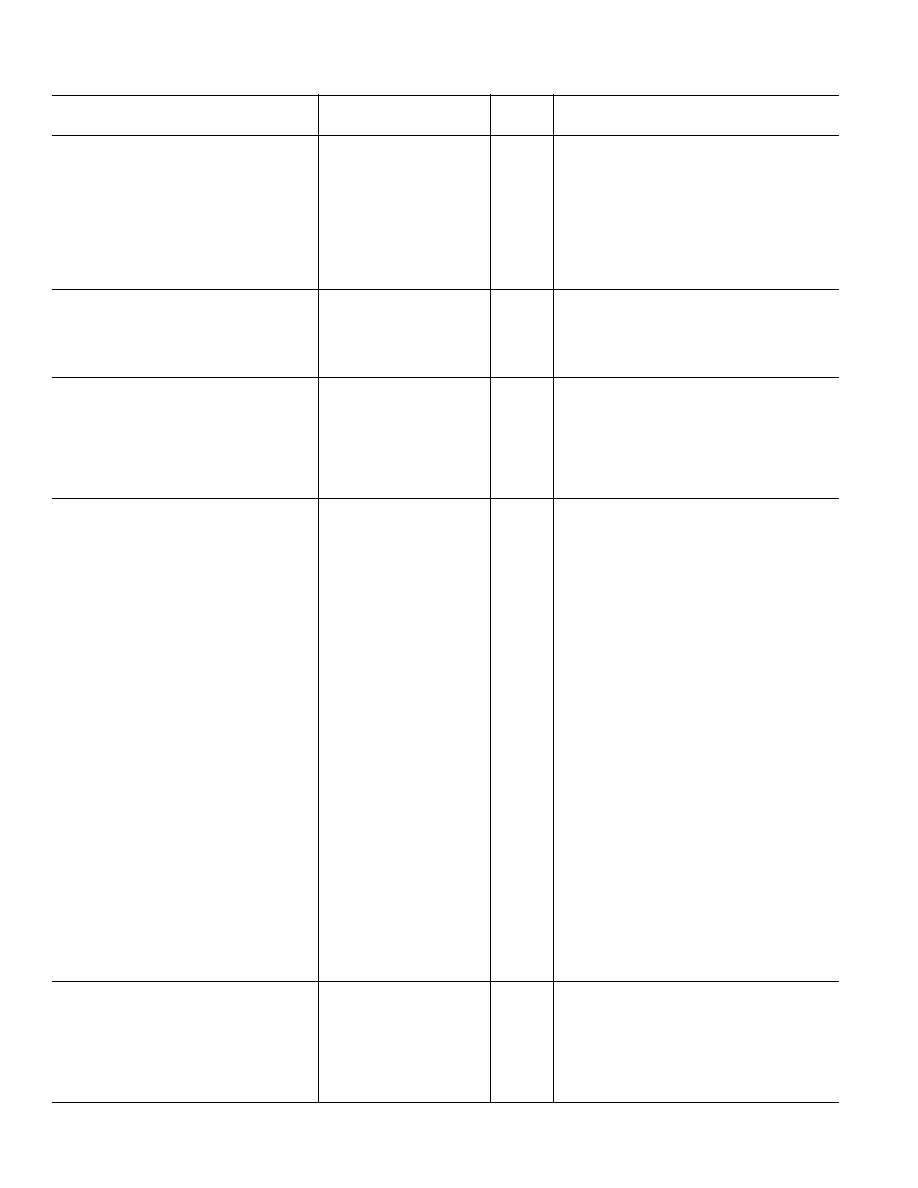
2
REV. B
AD73322SPECIFICATIONS
1
AD73322A
Parameter
Min
Typ
Max
Units
Test Conditions/Comments
REFERENCE
5VEN = 0
REFCAP
Absolute Voltage, VREFCAP
1.08
1.2
1.32
V
REFCAP TC
50
ppm/
°
C 0.1
µ
F Capacitor Required from
REFOUT
REFCAP to AGND2
Typical Output Impedance
130
Absolute Voltage, V
REFOUT
1.08
1.2
1.32
V
Unloaded
Minimum Load Resistance
1
k
Maximum Load Capacitance
100
pF
INPUT AMPLIFIER
Offset
±
1.0
mV
Maximum Output Swing
1.578
V
Max Output Swing = (1.578/1.2)
×
VREFCAP
Feedback Resistance
50
f
C
= 32 kHz
Feedback Capacitance
100
pF
ANALOG GAIN TAP
Gain at Maximum Setting
+1
Gain at Minimum Setting
1
Gain Resolution
5
Bits
Gain Step Size = 0.0625
Gain Accuracy
±
1.0
%
Output Unloaded
Settling Time
1.0
µ
s
Tap Gain Change of FS to +FS
Delay
0.5
µ
s
ADC SPECIFICATIONS
5VEN = 0
Maximum Input Range at VIN
2, 3
1.578
V p-p
Measured Differentially
2.85
dBm
Max Input = (1.578/1.2)
×
VREFCAP
Nominal Reference Level at VIN
1.0954
V p-p
Measured Differentially
(0 dBm0)
6.02
dBm
Absolute Gain
PGA = 0 dB
0.5
0.4
+1.2
dB
1.0 kHz, 0 dBm0
PGA = 38 dB
1.5
0.7
+0.1
dB
1.0 kHz, 0 dBm0
Gain Tracking Error
±
0.1
dB
1.0 kHz, +3 dBm0 to 50 dBm0
Signal to (Noise + Distortion)
Refer to Figure 5
PGA = 0 dB
72
78
dB
300 Hz to 3400 Hz; f
SAMP
= 64 kHz
78
dB
300 Hz to 3400 Hz; f
SAMP
= 8 kHz
55
57
dB
0 Hz to f
SAMP
/2; f
SAMP
= 64 kHz
PGA = 38 dB
52
56
dB
300 Hz to 3400 Hz; f
SAMP
= 64 kHz
Total Harmonic Distortion
PGA = 0 dB
84
73
dB
300 Hz to 3400 Hz; f
SAMP
= 64 kHz
PGA = 38 dB
70
60
dB
300 Hz to 3400 Hz; f
SAMP
= 64 kHz
Intermodulation Distortion
65
dB
PGA = 0 dB
Idle Channel Noise
71
dBm0
PGA = 0 dB
Crosstalk
ADC-to-DAC
100
dB
ADC Input Signal Level: 1.0 kHz, 0 dBm0
DAC Input at Idle
ADC-to-ADC
100
dB
ADC1 Input Signal Level: 1.0 kHz, 0 dBm0
ADC2 Input at Idle. Input Amplifiers Bypassed
70
dB
Input Amplifiers Included in Input Channel
DC Offset
30
+10
+45
mV
PGA = 0 dB
Power Supply Rejection
65
dB
Input Signal Level at AVDD and DVDD
Pins: 1.0 kHz, 100 mV p-p Sine Wave
Group Delay
4, 5
25
µ
s
Input Resistance at PGA
2, 4, 6
20
k
Input Amplifiers Bypassed
DIGITAL GAIN TAP
Gain at Maximum Setting
+1
Gain at Minimum Setting
1
Gain Resolution
16
Bits
Tested to 5 MSBs of Settings
Delay
25
µ
s
Includes DAC Delay
Settling Time
100
µ
s
Tap Gain Change from FS to +FS; Includes
DAC Settling Time
(AVDD = +3 V 10%; DVDD = +3 V 10%; DGND = AGND = 0 V, f
DMCLK
=
16.384 MHz, f
SAMP
= 64 kHz; T
A
= T
MIN
to T
MAX
, unless otherwise noted)
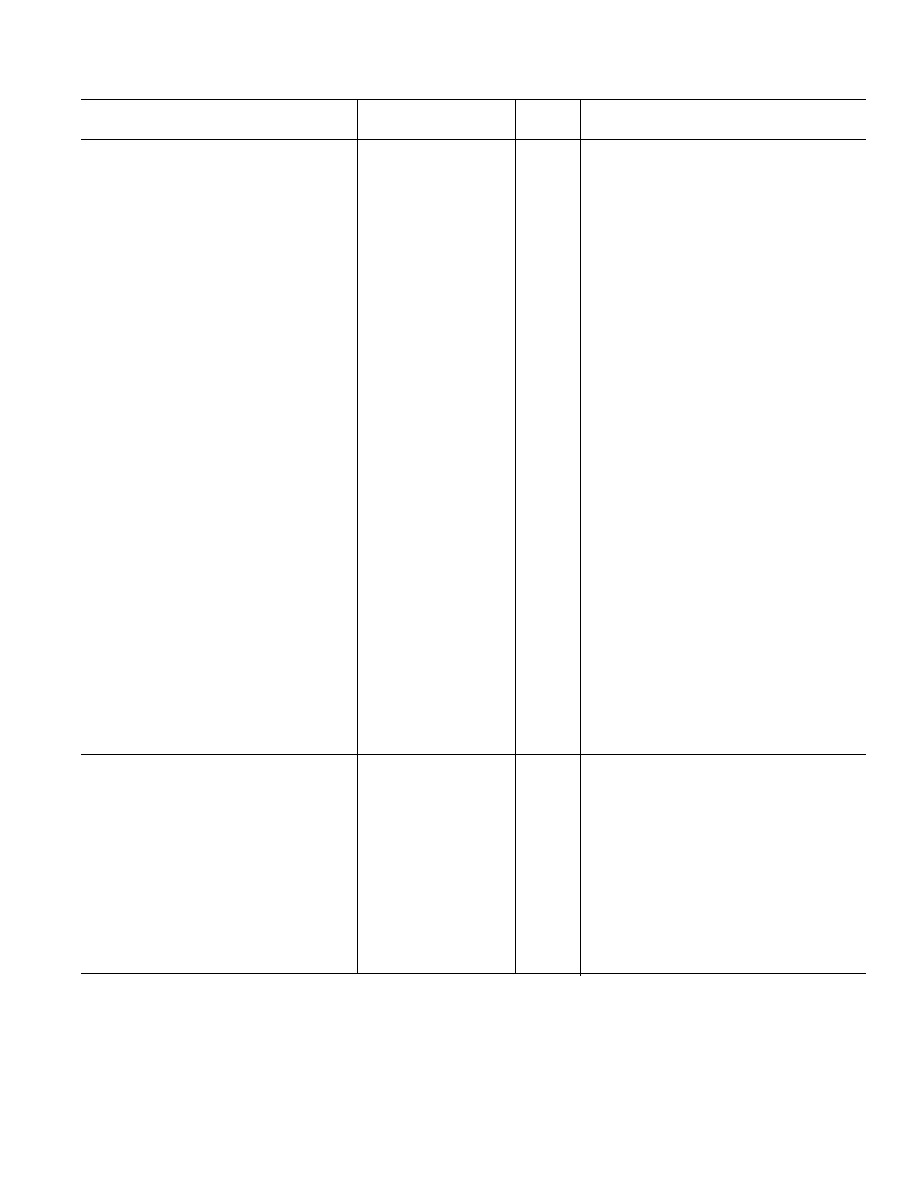
3
REV. B
AD73322
AD73322A
Parameter
Min
Typ
Max
Units
Test Conditions/Comments
DAC SPECIFICATIONS
5VEN = 0
Maximum Voltage Output Swing
2
Single-Ended
1.578
V p-p
PGA = 6 dB
2.85
dBm
Max Output = (1.578/1.2)
×
VREFCAP
Differential
3.156
V p-p
PGA = 6 dB
3.17
dBm
Max Output = 2
×
([1.578/1.2]
×
VREFCAP)
Nominal Voltage Output Swing (0 dBm0)
Single-Ended
1.0954
V p-p
PGA = 6 dB
6.02
dBm
Differential
2.1909
V p-p
PGA = 6 dB
0
dBm
Output Bias Voltage
1.2
V
REFOUT Unloaded
Absolute Gain
0.8
+0.4
+1.2
dB
1.0 kHz, 0 dBm0; Unloaded
Gain Tracking Error
±
0.1
dB
1.0 kHz, +3 dBm0 to 50 dBm0
Signal to (Noise + Distortion) at 0 dBm0
Refer to Figure 6; AVDD = 3.0 V
±
5%
PGA = 6 dB
62.5
77
dB
300 Hz to 3400 Hz; f
SAMP
= 64 kHz
Total Harmonic Distortion at 0 dBm0
AVDD = 3.00 V
±
5%
PGA = 6 dB
80
62.5
dB
300 Hz to 3400 Hz; f
SAMP
= 64 kHz
Intermodulation Distortion
85
dB
PGA = 0 dB
Idle Channel Noise
85
dBm0
PGA = 0 dB
Crosstalk
DAC-to-ADC
90
dB
ADC Input Signal Level: AGND; DAC
Output Signal Level: 1.0 kHz, 0 dBm0
Input Amplifiers Bypassed
77
dB
Input Amplifiers Included in Input Channel
DAC-to-DAC
100
dB
DAC1 Output Signal Level: AGND; DAC2
Output Signal Level: 1.0 kHz, 0 dBm0
Power Supply Rejection
65
dB
Input Signal Level at AVDD and DVDD
Pins: 1.0 kHz, 100 mV p-p Sine Wave
Group Delay
4, 5
25
µ
s
Interpolator Bypassed
50
µ
s
Output DC Offset
2, 7
25
+12
+40
mV
Minimum Load Resistance, R
L
2, 8
Single-Ended
4
150
Differential
150
Maximum Load Capacitance, C
L
2, 8
Single-Ended
500
pF
Differential
100
pF
FREQUENCY RESPONSE
(ADC and DAC)
9
Typical Output
Frequency (Normalized to FS)
0
0
dB
0.03125
0.1
dB
0.0625
0.25
dB
0.125
0.6
dB
0.1875
1.4
dB
0.25
2.8
dB
0.3125
4.5
dB
0.375
7.0
dB
0.4375
9.5
dB
> 0.5
< 12.5
dB
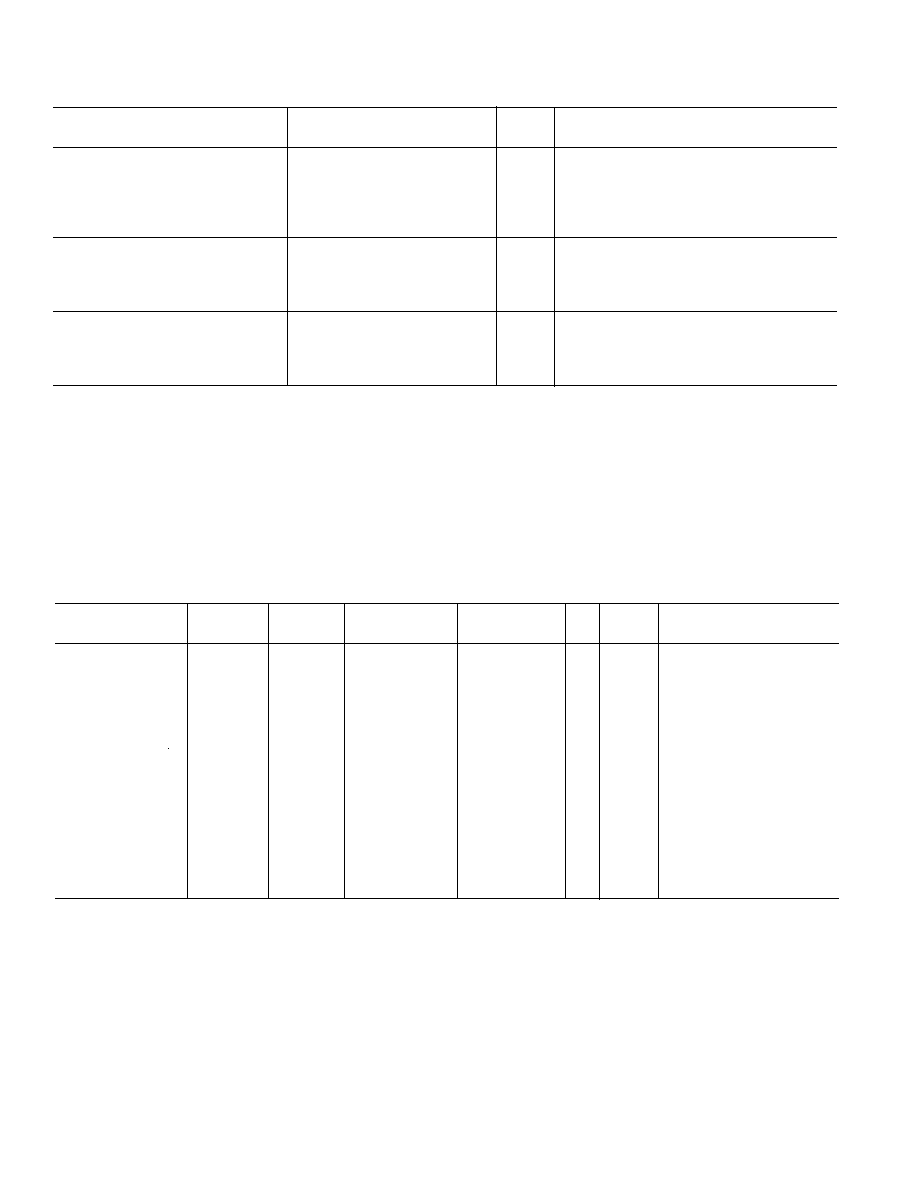
AD73322
4
REV. B
Table I. Current Summary (AVDD = DVDD = +3.3 V)
Analog
Digital
Total Current
Total Current
MCLK
Conditions
Current
Current
(Typ)
(Max)
SE
ON
Comments
ADCs On Only
7
4.5
11.5
13
1
YES
REFOUT Disabled
DACs On Only
15.5
4.5
20
23
1
YES
REFOUT Disabled
ADCs and DACs On
19.5
5
24.5
28
1
YES
REFOUT Disabled
ADCs and DACs
and Input Amps On
25
5
30
34
1
YES
REFOUT Disabled
ADCs and DACs
and AGT On
24
5
29
32.5
1
YES
REFOUT Disabled
All Sections On
32
5
37
42
1
YES
REFCAP On Only
0.8
0
0.8
1.25
0
NO
REFOUT Disabled
REFCAP and
REFOUT On Only
3.5
0
3.5
4.5
0
NO
All Sections Off
0
1.5
1.5
1.9
0
YES
MCLK Active Levels Equal to
0 V and DVDD
All Sections Off
0.00
10
µ
A
10
µ
A
40
µ
A
0
NO
Digital Inputs Static and Equal
to 0 V or DVDD
The above values are in mA and are typical values unless otherwise noted.
AD73322A
Parameter
Min
Typ
Max
Units
Test Conditions/Comments
LOGIC INPUTS
V
INH
, Input High Voltage
DVDD 0.8
DVDD V
V
INL
, Input Low Voltage
0
0.8
V
I
IH
, Input Current
10
+10
µ
A
C
IN
, Input Capacitance
10
pF
LOGIC OUTPUT
V
OH
, Output High Voltage
DVDD 0.4
DVDD V
|IOUT|
100
µ
A
V
OL
, Output Low Voltage
0
0.4
V
|IOUT|
100
µ
A
Three-State Leakage Current
10
+10
µ
A
POWER SUPPLIES
AVDD1, AVDD2
2.7
3.3
V
DVDD
2.7
3.3
V
I
DD
10
See Table I
NOTES
1
Operating temperature range is as follows: 40
°
C to +85
°
C. Therefore, T
MIN
= 40
°
C and T
MAX
= +85
°
C.
2
Test conditions: Input PGA set for 0 dB gain, Output PGA set for 6 dB gain, no load on analog outputs (unless otherwise noted).
3
At input to sigma-delta modulator of ADC.
4
Guaranteed by design.
5
Overall group delay will be affected by the sample rate and the external digital filtering.
6
The ADC's input impedance is inversely proportional to DMCLK and is approximated by: (3.3
×
10
11
)/DMCLK.
7
Between VOUTP1 and VOUTN1 or between VOUTP2 and VOUTN2.
8
At VOUT output.
9
Frequency responses of ADC and DAC measured with input at audio reference level (the input level that produces an output level of 10 dBm0), with 38 dB pream-
plifier bypassed and input gain of 0 dB.
10
Test Conditions: no load on digital inputs, analog inputs ac coupled to ground, no load on analog outputs.
Specifications subject to change without notice.
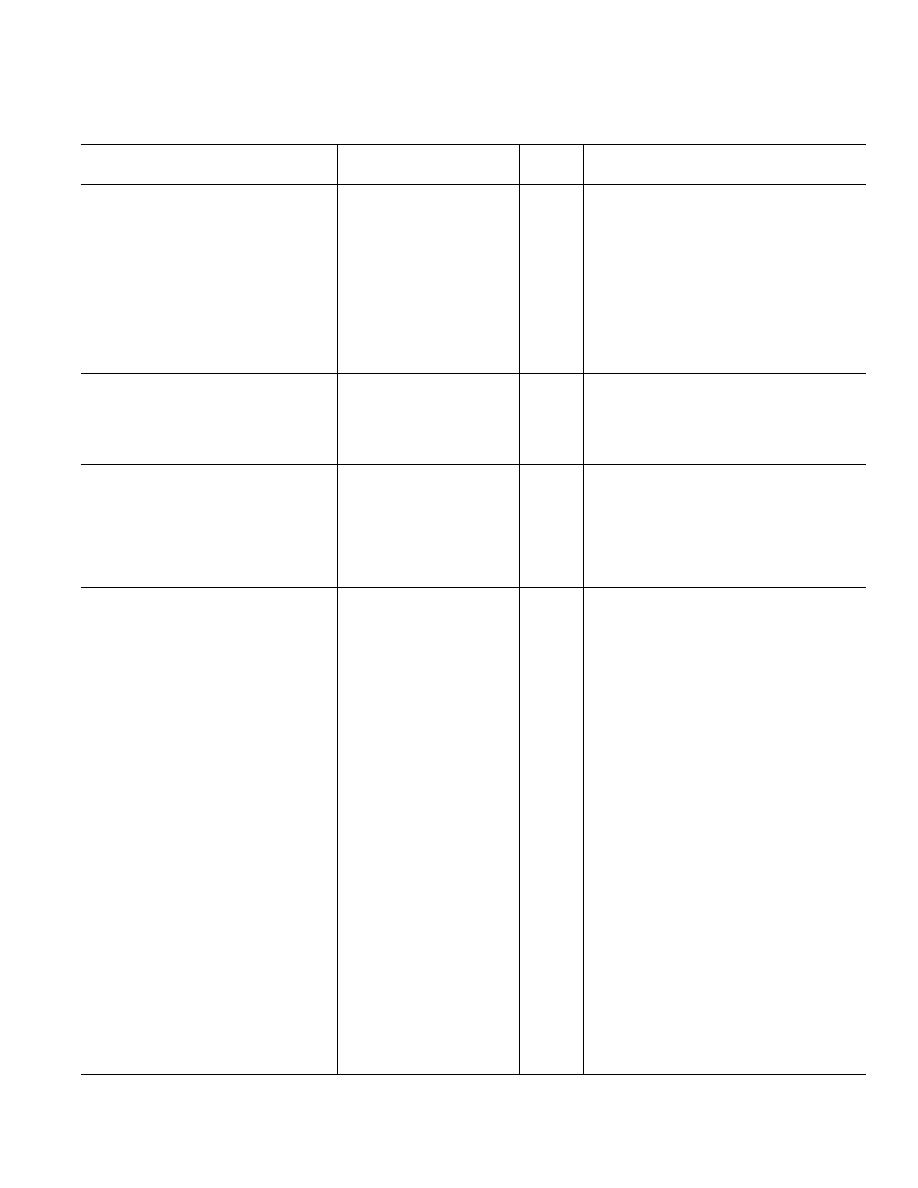
5
REV. B
AD73322
SPECIFICATIONS
1
AD73322A
Parameter
Min
Typ
Max
Units
Test Conditions/Comments
REFERENCE
REFCAP
Absolute Voltage, VREFCAP
1.2
V
5VEN = 0
2.4
V
5VEN = 1
REFCAP TC
50
ppm/
°
C
0.1
µ
F Capacitor Required from
REFOUT
REFCAP to AGND2
Typical Output Impedance
130
Absolute Voltage, VREFOUT
1.2
V
5VEN = 0, Unloaded
2.4
V
5VEN = 1, Unloaded
Minimum Load Resistance
2
k
5VEN = 1
Maximum Load Capacitance
100
pF
INPUT AMPLIFIER
Offset
±
1.0
mV
Maximum Output Swing
3.156
V
Max Output Swing = (3.156/2.4)
×
VREFCAP
Feedback Resistance
50
k
f
C
= 32 kHz
Feedback Capacitance
100
pF
ANALOG GAIN TAP
Gain at Maximum Setting
+1
Gain at Minimum Setting
1
Gain Resolution
5
Bits
Gain Step Size = 0.0625
Gain Accuracy
±
1
%
Output Unloaded
Settling Time
1.0
µ
s
Tap Gain Change of FS to +FS
Delay
0.5
µ
s
ADC SPECIFICATIONS
5VEN = 1
Maximum Input Range at VIN
2, 3
3.156
V p-p
Measured Differentially
3.17
dBm
Max Input Swing = (3.156/2.4)
×
VREFCAP
Nominal Reference Level at VIN
2.1908
V p-p
Measured Differentially
(0 dBm0)
0
dBm
Absolute Gain
PGA = 0 dB
0.4
dB
1.0 kHz, 0 dBm0
PGA = 38 dB
0.7
dB
1.0 kHz, 0 dBm0
Gain Tracking Error
±
0.1
dB
1.0 kHz, +3 dBm0 to 50 dBm0
Signal to (Noise + Distortion)
Refer to Figure 7
PGA = 0 dB
78
dB
300 Hz to 3400 Hz; f
SAMP
= 64 kHz
78
dB
300 Hz to 3400 Hz; f
SAMP
= 8 kHz
57
dB
0 Hz to f
SAMP
/2; f
SAMP
= 64 kHz
PGA = 38 dB
56
dB
300 Hz to 3400 Hz; f
SAMP
= 64 kHz
Total Harmonic Distortion
PGA = 0 dB
84
dB
300 Hz to 3400 Hz; f
SAMP
= 64 kHz
PGA = 38 dB
70
dB
300 Hz to 3400 Hz; f
SAMP
= 64 kHz
Intermodulation Distortion
65
dB
PGA = 0 dB
Idle Channel Noise
71
dBm0
PGA = 0 dB
Crosstalk
ADC-to-DAC
100
dB
ADC Input Signal Level: 1.0 kHz, 0 dBm0
DAC Input at Idle
ADC-to-ADC
100
dB
ADC1 Input Signal Level: 1.0 kHz, 0 dBm0
ADC2 Input at Idle. Input Amplifiers Bypassed
70
dB
Input Amplifiers Included in Channel
DC Offset
+10
mV
PGA = 0 dB
Power Supply Rejection
65
dB
Input Signal Level at AVDD and DVDD
Pins: 1.0 kHz, 100 mV p-p Sine Wave
Group Delay
4, 5
25
µ
s
64 kHz Output Sample Rate
Input Resistance at PGA
2,
4, 6
20
k
Input Amplifiers Bypassed
(AVDD = +5 V 10%; DVDD = +5 V 10%; DGND = AGND = 0 V, f
DMCLK
= 16.384 MHz, f
SAMP
= 64 kHz;
T
A
= T
MIN
to T
MAX
, unless otherwise noted)
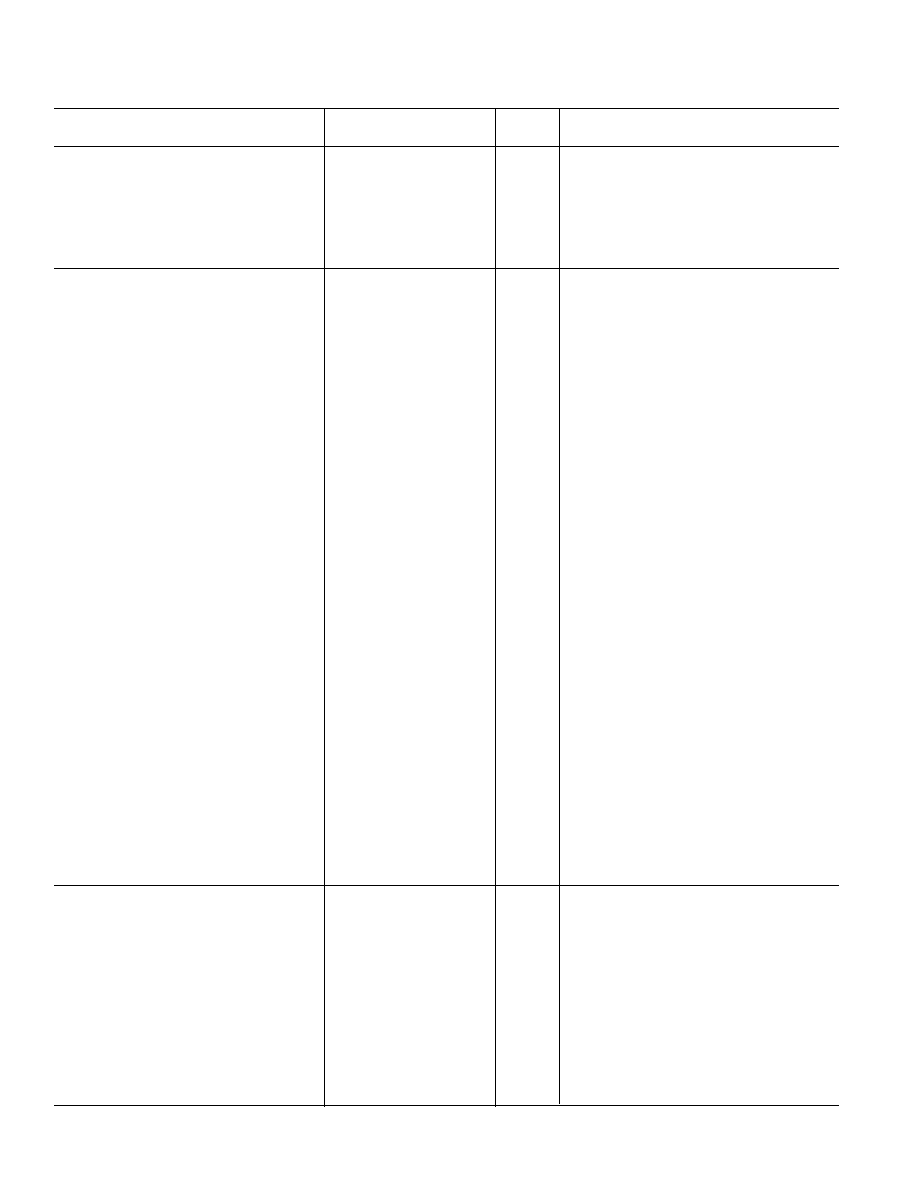
AD73322
6
REV. B
AD73322A
P
arameter
Min
Typ
Max
Units
Test Conditions/Comments
DIGITAL GAIN TAP
Gain at Maximum Setting
+1
V
Gain at Minimum Setting
1
V
Gain Resolution
16
Bits
Tested to 5 MSBs of Settings
Delay
25
µ
s
Includes DAC Delay
Settling Time
100
µ
s
Tap Gain Change from FS to +FS; Includes
DAC Settling Time
DAC SPECIFICATIONS
5VEN = 1
Maximum Voltage Output Swing
2
Single-Ended
3.156
V p-p
PGA = 6 dB
3.17
dBm
Max Output = (3.156/2.4)
×
VREFCAP
Differential
6.312
V p-p
PGA = 6 dB
9.19
dBm
Max Output = 2
×
([3.156/2.4]
×
VREFCAP)
Nominal Voltage Output Swing (0 dBm0)
Single-Ended
2.1908
V p-p
PGA = 6 dB
0
dBm
Differential
4.3918
V p-p
PGA = 6 dB
6.02
dBm
Output Bias Voltage
2.4
V
REFOUT Unloaded
Absolute Gain
+0.4
dB
1.0 kHz, 0 dBm0; Unloaded
Gain Tracking Error
±
0.1
dB
1.0 kHz, +3 dBm0 to 50 dBm0
Signal to (Noise + Distortion) at 0 dBm0
Refer to Figure 8
PGA = 6 dB
77
dB
300 Hz to 3400 Hz; f
SAMP
= 64 kHz
Total Harmonic Distortion at 0 dBm0
PGA = 6 dB
80
dB
300 Hz to 3400 Hz; f
SAMP
= 64 kHz
Intermodulation Distortion
85
dB
PGA = 0 dB
Idle Channel Noise
85
dBm0
PGA = 0 dB
Crosstalk
DAC-to-ADC
90
dB
ADC Input Signal Level: AGND; DAC
Output Signal Level: 1.0 kHz, 0 dBm0;
Input Amplifiers Bypassed
77
dB
Input Amplifiers Included In Input Channel
DAC-to-DAC
100
dB
DAC1 Output Signal Level: AGND; DAC2
Output Signal Level: 1.0 kHz, 0 dBm0
Power Supply Rejection
65
dB
Input Signal Level at AVDD and DVDD
Pins: 1.0 kHz, 100 mV p-p Sine Wave
Group Delay
4, 5
25
µ
s
Interpolator Bypassed
50
µ
s
Output DC Offset
2, 7
+12
mV
Minimum Load Resistance, R
L
2, 8
Single-Ended
150
Differential
150
Maximum Load Capacitance, C
L
2, 8
Single-Ended
500
pF
Differential
100
pF
FREQUENCY RESPONSE
(ADC and DAC)
9
Typical Output
Frequency (Normalized to FS)
0
0
dB
0.03125
0.1
dB
0.0625
0.25
dB
0.125
0.6
dB
0.1875
1.4
dB
0.25
2.8
dB
0.3125
4.5
dB
0.375
7.0
dB
0.4375
9.5
dB
> 0.5
< 12.5
dB
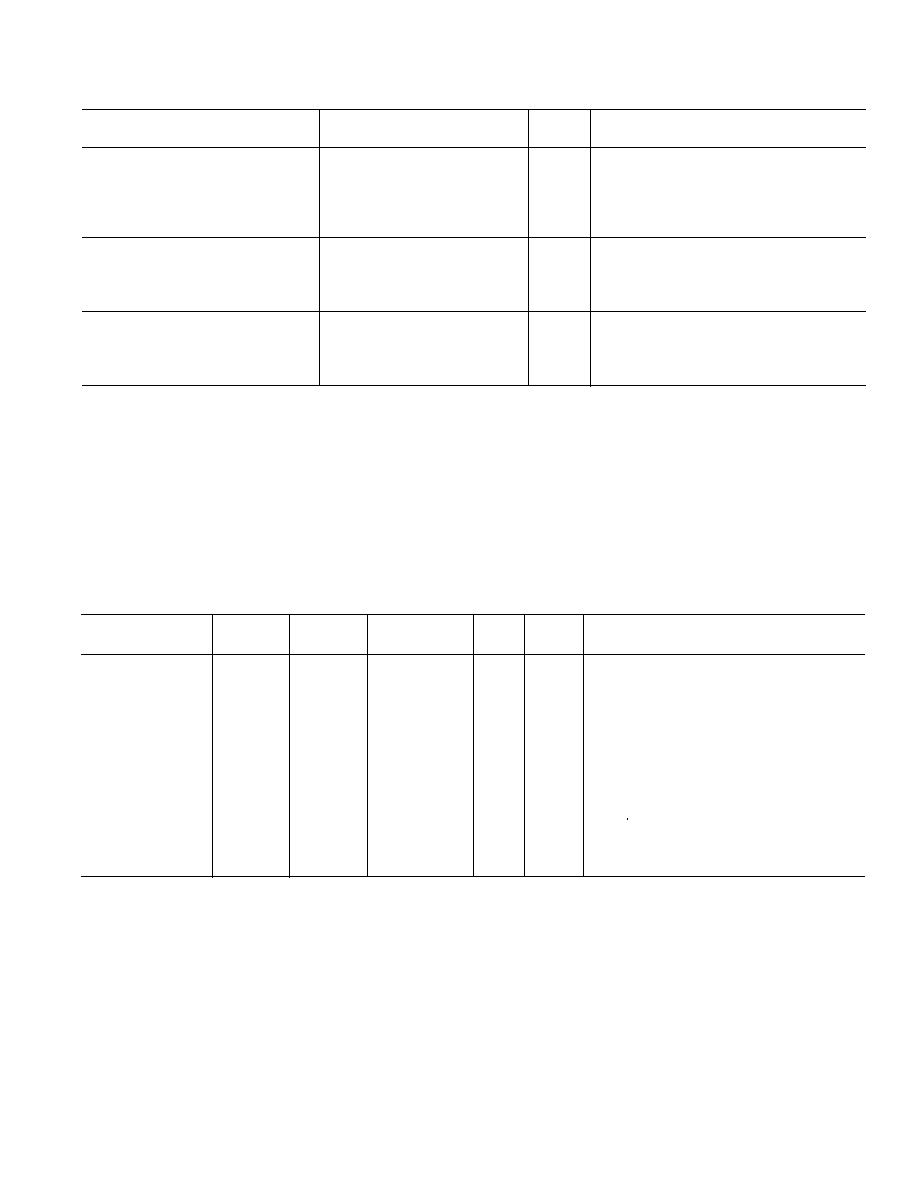
7
REV. B
AD73322
AD73322A
Parameter
Min
Typ
Max
Units
Test Conditions/Comments
LOGIC INPUTS
V
INH
, Input High Voltage
DVDD 0.8
DVDD
V
V
INL
, Input Low Voltage
0
0.8
V
I
IH
, Input Current
±
0.5
µ
A
C
IN
, Input Capacitance
10
pF
LOGIC OUTPUT
V
OH
, Output High Voltage
DVDD 0.4
DVDD
V
|I
OUT
|
100
µ
A
V
OL
, Output Low Voltage
0
0.4
V
|I
OUT
|
100
µ
A
Three-State Leakage Current
±
0.3
µ
A
POWER SUPPLIES
AVDD1, AVDD2
4.5
5.5
V
DVDD
4.5
5.5
V
I
DD
10
See Table II
NOTES
1
Operating temperature range is as follows: 40
°
C to +85
°
C. Therefore, T
MIN
= 40
°
C and T
MAX
= +85
°
C.
2
Test conditions: Input PGA set for 0 dB gain, Output PGA set for 6 dB gain, no load on analog outputs (unless otherwise stated).
3
At input to sigma-delta modulator of ADC.
4
Guaranteed by design.
5
Overall group delay will be affected by the sample rate and the external digital filtering.
6
The ADC's input impedance is inversely proportional to DMCLK and is approximated by: (3.3
×
10
11
)/DMCLK.
7
Between VOUTP and VOUTN.
8
At VOUT output.
9
Frequency responses of ADC and DAC measured with input at audio reference level (the input level that produces an output level of 10 dBm0), with 38 dB
preamplifier bypassed and input gain of 0 dB.
10
Test conditions: no load on digital inputs, analog inputs ac coupled to ground, no load on analog outputs.
Specifications subject to change without notice.
Table II. Current Summary (AVDD = DVDD = +5.5 V)
Analog
Digital
Total Current
MCLK
Conditions
Current
Current
(Typ)
SE
ON
Comments
ADCs On Only
7.5
9
16.5
1
YES
REFOUT Disabled
DACs On Only
16
9
25
1
YES
REFOUT Disabled
ADC and DAC On
20.5
10
30.5
1
YES
REFOUT Disabled
ADCs and DACs
and Input Amps On
27
10
37
1
YES
REFOUT Disabled
ADCs and DACs
and AGT On
25
10
35
1
YES
REFOUT Disabled
All Sections On
35
10
45
1
YES
REFCAP On Only
0.8
0
0.8
0
NO
REFOUT Disabled
REFCAP and
REFOUT On Only
3.5
0
3.5
0
NO
All Sections Off
0
3
3
0
YES
MCLK Active Levels Equal to 0 V and DVDD
All Sections Off
0
10
µ
A
10
µ
A
0
NO
Digital Inputs Static and Equal to 0 V or DVDD
The above values are in mA and are typical values unless otherwise noted.
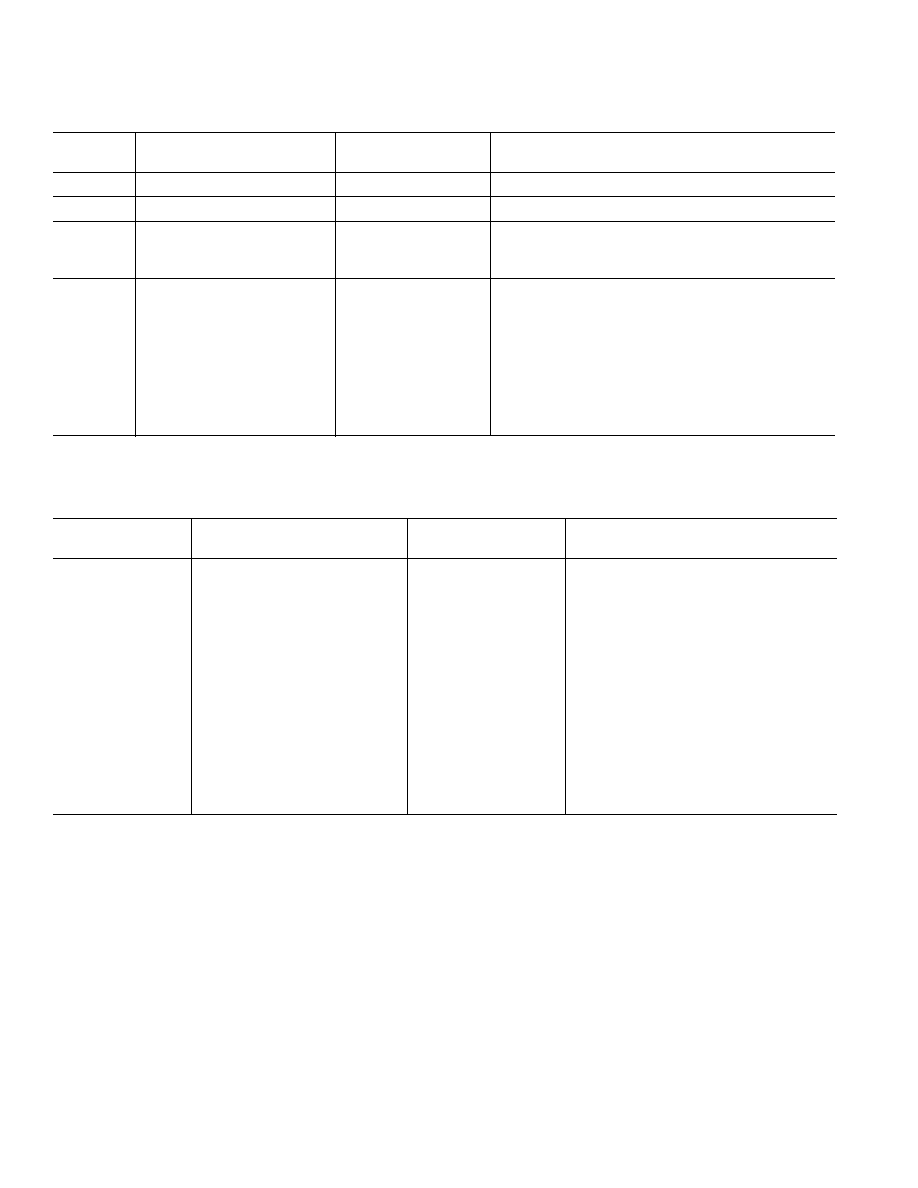
AD73322
8
REV. B
Table III. Signal Ranges
3 V Power Supply
5 V Power Supply
5VEN = 0
5VEN = 0
5VEN = 1
VREFCAP
1.2 V
±
10%
1.2 V
2.4 V
VREFOUT
1.2 V
±
10%
1.2 V
2.4 V
ADC
Maximum Input Range
at V
IN
1.578 V p-p
1.578 V p-p
3.156 V p-p
Nominal Reference Level
1.0954 V p-p
1.0954 V p-p
2.1908 V p-p
DAC
Maximum Voltage
Output Swing
Single-Ended
1.578 V p-p
1.578 V p-p
3.156 V p-p
Differential
3.156 V p-p
3.156 V p-p
6.312 V p-p
Nominal Voltage
Output Swing
Single-Ended
1.0954 V p-p
1.0954 V p-p
2.1908 V p-p
Differential
2.1909 V p-p
2.1909 V p-p
4.3818 V p-p
Output Bias Voltage
VREFOUT
VREFOUT
VREFOUT
TIMING CHARACTERISTICS
Limit at
Parameter
T
A
= 40 C to +85 C
Units
Description
Clock Signals
See Figure 1
t
1
61
ns min
MCLK Period
t
2
24.4
ns min
MCLK Width High
t
3
24.4
ns min
MCLK Width Low
Serial Port
See Figures 3 and 4
t
4
t
1
ns min
SCLK Period
t
5
0.4
×
t
1
ns min
SCLK Width High
t
6
0.4
×
t
1
ns min
SCLK Width Low
t
7
20
ns min
SDI/SDIFS Setup Before SCLK Low
t
8
0
ns min
SDI/SDIFS Hold After SCLK Low
t
9
10
ns max
SDOFS Delay from SCLK High
t
10
10
ns min
SDOFS Hold After SCLK High
t
11
10
ns min
SDO Hold After SCLK High
t
12
10
ns max
SDO Delay from SCLK High
t
13
30
ns max
SCLK Delay from MCLK
Specifications subject to change without notice.
(AVDD = +3 V 10%; DVDD = +3 V 10%; AGND = DGND = 0 V; T
A
= T
MlN
to T
MAX
, unless
otherwise noted)
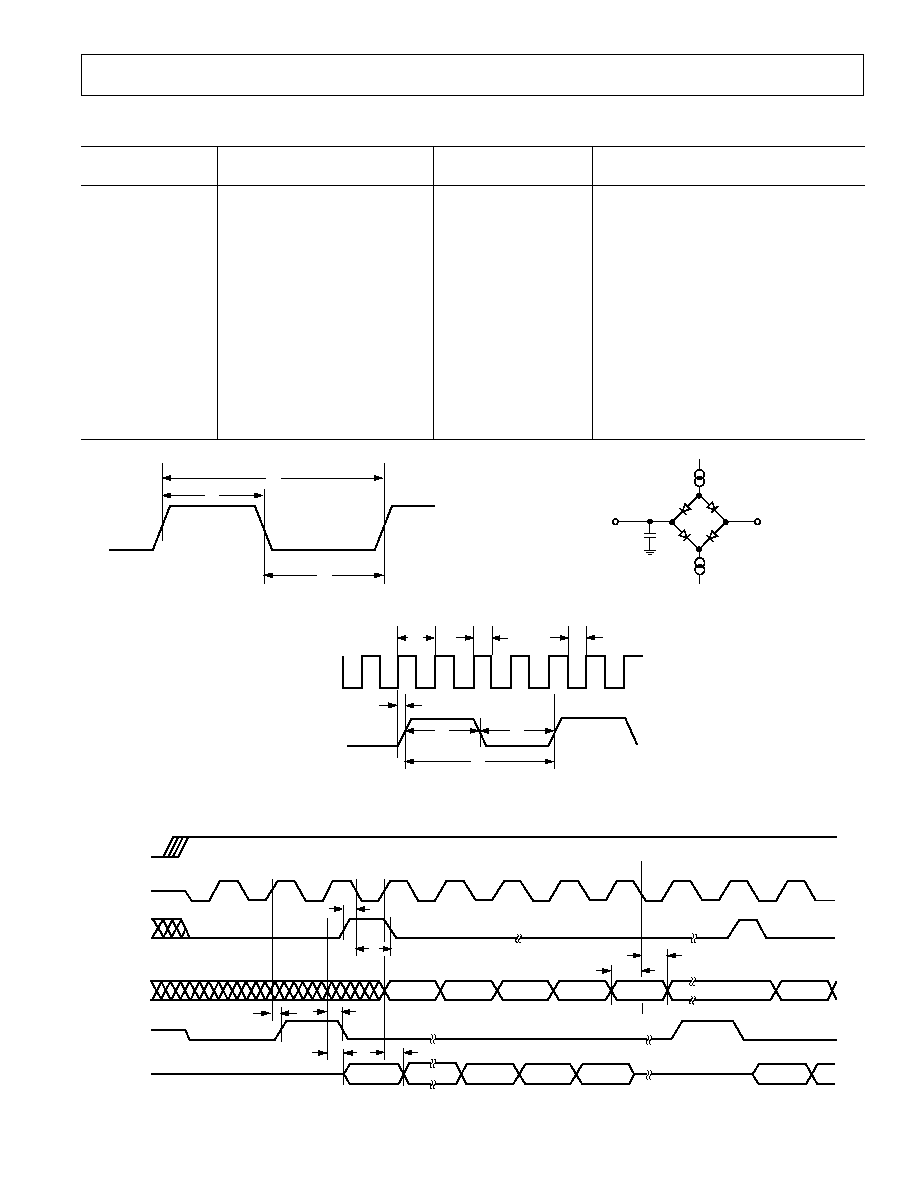
AD73322
9
REV. B
TIMING CHARACTERISTICS
Limit at
Parameter
T
A
= 40 C to +85 C
Units
Description
Clock Signals
See Figure 1
t
1
61
ns min
MCLK Period
t
2
24.4
ns min
MCLK Width High
t
3
24.4
ns min
MCLK Width Low
Serial Port
See Figures 3 and 4
t
4
t
1
ns min
SCLK Period
t
5
0.4
×
t
1
ns min
SCLK Width High
t
6
0.4
×
t
1
ns min
SCLK Width Low
t
7
20
ns typ
SDI/SDIFS Setup Before SCLK Low
t
8
0
ns typ
SDI/SDIFS Hold After SCLK Low
t
9
10
ns typ
SDOFS Delay from SCLK High
t
10
10
ns typ
SDOFS Hold After SCLK High
t
11
10
ns typ
SDO Hold After SCLK High
t
12
10
ns typ
SDO Delay from SCLK High
t
13
30
ns typ
SCLK Delay from MCLK
Specifications subject to change without notice.
(AVDD = +5 V 10%; DVDD = +5 V 10%; AGND = DGND = 0 V; T
A
= T
MlN
to T
MAX
, unless
otherwise noted)
t
3
t
2
t
1
Figure 1. MCLK Timing
t
11
t
7
t
9
t
10
t
7
t
8
t
8
SE (I)
SCLK (O)
SDIFS (I)
SDI (I)
SDOFS (O)
SDO (O)
THREE-
STATE
THREE-
STATE
THREE-
STATE
D15
D2
D1
D0
D14
D15
D0
D1
D14
D15
D15
t
12
Figure 4. Serial Port (SPORT)
t
3
t
1
t
2
t
13
* SCLK IS INDIVIDUALLY PROGRAMMABLE
IN FREQUENCY (MCLK/4 SHOWN HERE).
t
4
t
5
t
6
MCLK
SCLK*
Figure 3. SCLK Timing
TO OUTPUT
PIN
+2.1V
100 A
100 A
I
OL
I
OH
C
L
15pF
Figure 2. Load Circuit for Timing Specifications
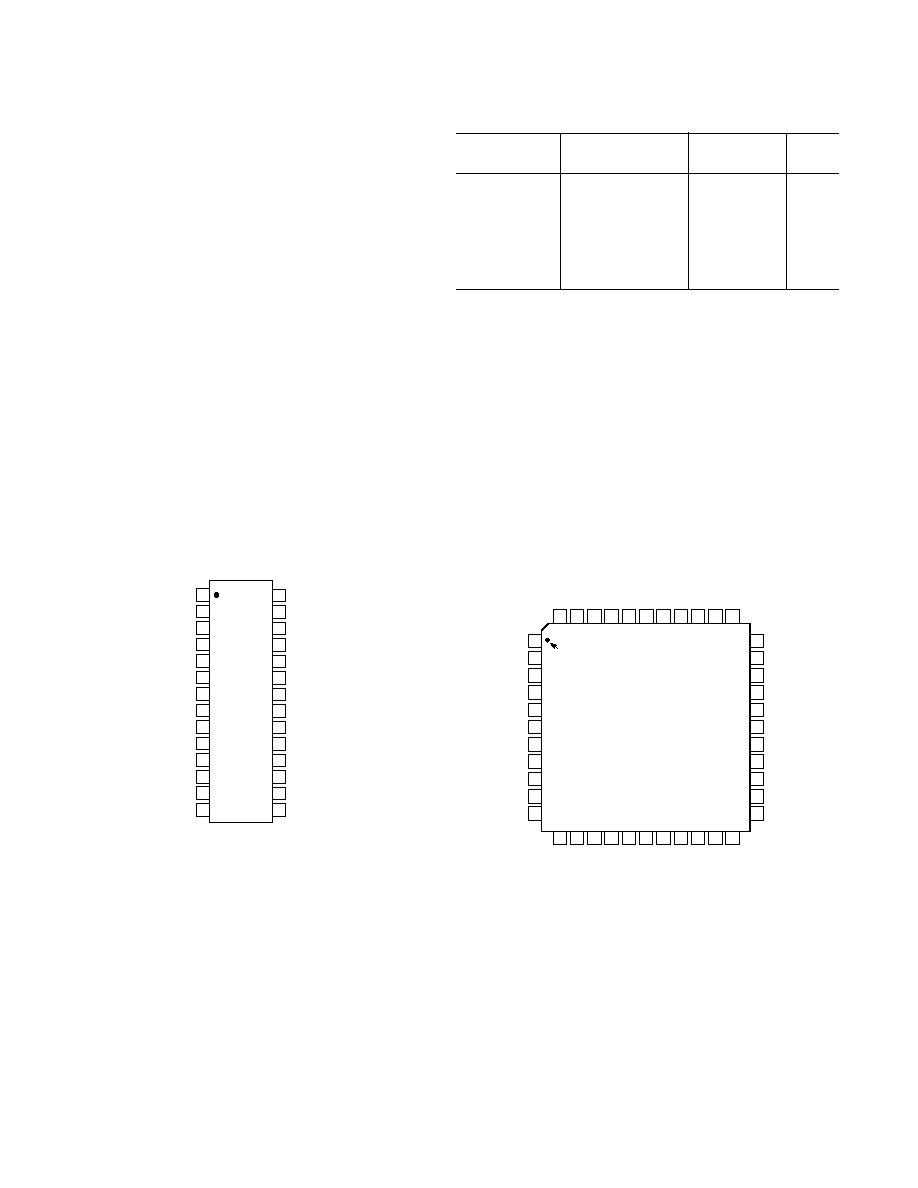
AD73322
10
REV. B
ABSOLUTE MAXIMUM RATINGS*
(T
A
= +25
°
C unless otherwise noted)
AVDD, DVDD to GND . . . . . . . . . . . . . . . . . 0.3 V to +7 V
AGND to DGND . . . . . . . . . . . . . . . . . . . . 0.3 V to +0.3 V
Digital I/O Voltage to DGND . . . . . 0.3 V to DVDD + 0.3 V
Analog I/O Voltage to AGND . . . . . 0.3 V to AVDD + 0.3 V
Operating Temperature Range
Industrial (A Version) . . . . . . . . . . . . . . . 40
°
C to +85
°
C
Storage Temperature Range . . . . . . . . . . . . 65
°
C to +150
°
C
Maximum Junction Temperature . . . . . . . . . . . . . . . +150
°
C
SOIC,
JA
Thermal Impedance . . . . . . . . . . . . . . . 71.4
°
C/W
Lead Temperature, Soldering
Vapor Phase (60 sec) . . . . . . . . . . . . . . . . . . . . . . . +215
°
C
Infrared (15 sec) . . . . . . . . . . . . . . . . . . . . . . . . . . . +220
°
C
LQFP,
JA
Thermal Impedance . . . . . . . . . . . . . . . 53.2
°
C/W
Lead Temperature, Soldering
Vapor Phase (60 sec) . . . . . . . . . . . . . . . . . . . . . . . +215
°
C
Infrared (15 sec) . . . . . . . . . . . . . . . . . . . . . . . . . . . +220
°
C
*Stresses above those listed under Absolute Maximum Ratings may cause perma-
nent damage to the device. This is a stress rating only; functional operation of the
device at these or any other conditions above those listed in the operational
sections of this specification is not implied. Exposure to absolute maximum rating
conditions for extended periods may affect device reliability.
ORDERING GUIDE
Temperature
Package
Package
Model
Range
Descriptions
Options
AD73322AR
40
°
C to +85
°
C
Wide Body SOIC
R-28
AD73322AST
40
°
C to +85
°
C
Plastic Thin Quad ST-44A
Flatpack (LQFP)
EVAL-AD73322EB
Evaluation Board
1
+EZ-KIT Lite Upgrade
2
EVAL-AD73322EZ
Evaluation Board
1
+EZ-KIT Lite
3
NOTES
1
The AD73322 evaluation board features a selectable number of codecs in
cascade (from 1 to 4). It can be interfaced to an ADSP-2181 EZ-KIT Lite or to
a Texas Instruments EVM kit.
2
The upgrade consists of a connector that is used to connect the EZ-KIT to the
AD73322 evaluation board. This option is intended for owners of the EZ-KIT
Lite.
3
The EZ-KIT Lite has been modified to allow it to interface with the AD73322
evaluation board. This option is intended for users who do not already have an
EZ-KIT Lite.
PIN CONFIGURATIONS
28-Lead Wide Body SOIC
(R-28)
TOP VIEW
(Not to Scale)
28
27
26
25
24
23
22
21
20
19
18
17
16
15
1
2
3
4
5
6
7
8
9
10
11
12
13
14
AD73322
SDO
MCLK
SCLK
RESET
DVDD
DGND
AGND2
VINP1
VFBP1
VINN1
VFBN1
AVDD2
REFCAP
REFOUT
SDOFS
SDIFS
SDI
SE
AGND1
AVDD1
VOUTP2
VFBN2
VINN2
VFBP2
VINP2
VOUTN2
VOUTP1
VOUTN1
44-Lead Plastic Thin Quad Flatpack (LQFP)
(ST-44A)
3
4
5
6
7
1
2
10
11
8
9
40 39 38
41
42
43
44
36 35 34
37
29
30
31
32
33
27
28
25
26
23
24
PIN 1
IDENTIFIER
TOP VIEW
(Not to Scale)
12 13
14 15 16 17 18 19 20 21 22
NC
VOUTN1
VOUTP1
NC
VOUTN2
VOUTP2
NC
AD73322
REFOUT
REFCAP
AVDD2
AVDD2
AGND2
AGND2
AGND2
NC = NO CONNECT
AGND2
DGND
DGND
DVDD
AVDD1
SDI
NC
AVDD1
SDIFS
AGND1
AGND1
NC
VFBN1
NC
RESET
VFBP1
VINN2
VFBP2
VINP2
NC
VINP1
SCLK
MCLK
SDO
VINN1
NC
SDOFS
VFBN2
SE
NC
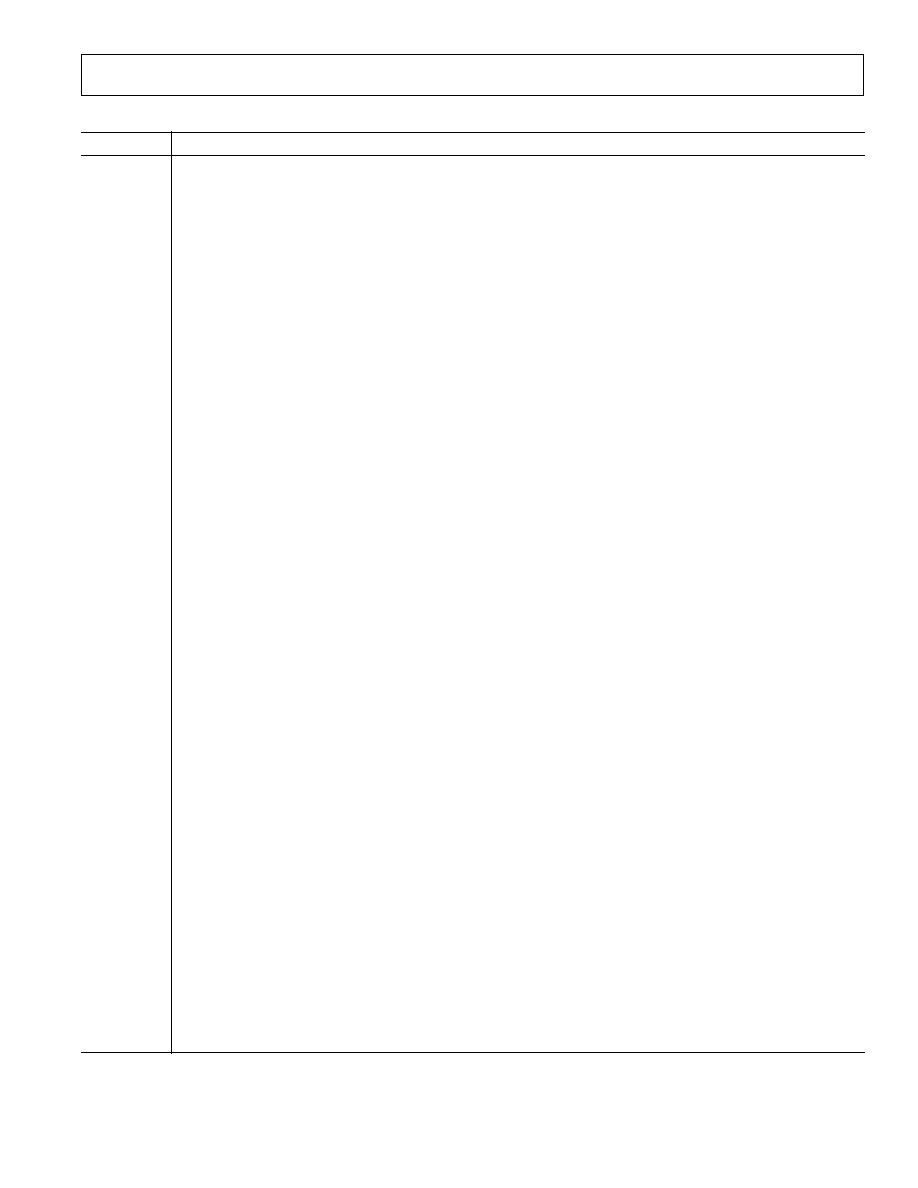
AD73322
11
REV. B
PIN FUNCTION DESCRIPTIONS
Mnemonic
Function
VINP1
Analog Input to the inverting input amplifier on Channel 1's positive input.
VFBP1
Feedback Connection from the output of the inverting amplifier on Channel 1's positive input. When the input
amplifiers are bypassed, this pin allows direct access to the positive input of Channel 1's sigma-delta modulator.
VINN1
Analog Input to the inverting input amplifier on Channel 1's negative input.
VFBN1
Feedback connection from the output of the inverting amplifier on Channel 1's negative input. When the input
amplifiers are bypassed, this pin allows direct access to the negative input of Channel 1's sigma-delta modulator.
REFOUT
Buffered Reference Output, which has a nominal value of 1.2 V or 2.4 V, the value being dependent on the status
of Bit 5VEN (CRC:7). As the reference is common to the two codec units, the reference value is set by the wired
OR of the CRC:7 bits in Control Register C of each channel.
REFCAP
A bypass capacitor to AGND2 of 0.1
µ
F is required for the on-chip reference. The capacitor should be fixed to this
pin.
AVDD2
Analog Power Supply Connection.
AGND2
Analog Ground/Substrate Connection2.
DGND
Digital Ground/Substrate Connection.
DVDD
Digital Power Supply Connection.
RESET
Active Low Reset Signal. This input resets the entire chip, resetting the control registers and clearing the digital
circuitry.
SCLK
Serial Clock Output whose rate determines the serial transfer rate to/from the codec. It is used to clock data or
control information to and from the serial port (SPORT). The frequency of SCLK is equal to the frequency of the
master clock (MCLK) divided by an integer number--this integer number being the product of the external mas-
ter clock rate divider and the serial clock rate divider.
MCLK
Master Clock Input. MCLK is driven from an external clock signal.
SDO
Serial Data Output. Both data and control information may be output on this pin and are clocked on the positive
edge of SCLK. SDO is in three-state when no information is being transmitted and when SE is low.
SDOFS
Framing Signal Output for SDO Serial Transfers. The frame sync is one bit wide and is active one SCLK period
before the first bit (MSB) of each output word. SDOFS is referenced to the positive edge of SCLK. SDOFS is in
three-state when SE is low.
SDIFS
Framing Signal Input for SDI Serial Transfers. The frame sync is one bit wide and is valid one SCLK period be-
fore the first bit (MSB) of each input word. SDIFS is sampled on the negative edge of SCLK and is ignored when
SE is low.
SDI
Serial Data Input. Both data and control information may be input on this pin and are clocked on the negative
edge of SCLK. SDI is ignored when SE is low.
SE
SPORT Enable. Asynchronous input enable pin for the SPORT. When SE is set low by the DSP, the output pins
of the SPORT are three-stated and the input pins are ignored. SCLK is also disabled internally in order to decrease
power dissipation. When SE is brought high, the control and data registers of the SPORT are at their original
values (before SE was brought low); however, the timing counters and other internal registers are at their reset
values.
AGND1
Analog Ground/Substrate Connection.
AVDD1
Analog Power Supply Connection.
VOUTP2
Analog Output from the Positive Terminal of Output Channel 2.
VOUTN2
Analog Output from the Negative Terminal of Output Channel 2.
VOUTP1
Analog Output from the Positive Terminal of Output Channel 1.
VOUTN1
Analog Output from the Negative Terminal of Output Channel 1.
VINP2
Analog Input to the inverting input amplifier on Channel 2's positive input.
VFBP2
Feedback connection from the output of the inverting amplifier on Channel 2's positive input. When the input
amplifiers are bypassed, this pin allows direct access to the positive input of Channel 2's sigma-delta modulator.
VINN2
Analog Input to the inverting input amplifier on Channel 2's negative input.
VFBN2
Feedback connection from the output of the inverting amplifier on Channel 2's negative input. When the input
amplifiers are bypassed, this pin allows direct access to the negative input of Channel 2's sigma-delta modulator.

AD73322
12
REV. B
TERMINOLOGY
Absolute Gain
Absolute gain is a measure of converter gain for a known signal.
Absolute gain is measured (differentially) with a 1 kHz sine
wave at 0 dBm0 for the DAC and with a 1 kHz sine wave at
0 dBm0 for the ADC. The absolute gain specification is used for
gain tracking error specification.
Crosstalk
Crosstalk is due to coupling of signals from a given channel to
an adjacent channel. It is defined as the ratio of the amplitude of
the coupled signal to the amplitude of the input signal. Crosstalk
is expressed in dB.
Gain Tracking Error
Gain tracking error measures changes in converter output for
different signal levels relative to an absolute signal level. The
absolute signal level is 0 dBm0 (equal to absolute gain) at 1 kHz
for the DAC and 0 dBm0 (equal to absolute gain) at 1 kHz for
the ADC. Gain tracking error at 0 dBm0 (ADC) and 0 dBm0
(DAC) is 0 dB by definition.
Group Delay
Group Delay is defined as the derivative of radian phase with
respect to radian frequency, dø(f)/df. Group delay is a measure
of average delay of a system as a function of frequency. A linear
system with a constant group delay has a linear phase response.
The deviation of group delay from a constant indicates the
degree of nonlinear phase response of the system.
Idle Channel Noise
Idle channel noise is defined as the total signal energy measured
at the output of the device when the input is grounded (mea-
sured in the frequency range 300 Hz3400 Hz).
Intermodulation Distortion
With inputs consisting of sine waves at two frequencies, fa and
fb, any active device with nonlinearities will create distortion
products at sum and difference frequencies of mfa
±
nfb where
m, n = 0, 1, 2, 3, etc. Intermodulation terms are those for which
neither m nor n is equal to zero. For final testing, the second
order terms include (fa + fb) and (fa fb), while the third order
terms include (2fa + fb), (2fa fb), (fa + 2fb) and (fa 2fb).
Power Supply Rejection
Power supply rejection measures the susceptibility of a device to
noise on the power supply. Power supply rejection is measured
by modulating the power supply with a sine wave and measuring
the noise at the output (relative to 0 dB).
Sample Rate
The sample rate is the rate at which the ADC updates its output
register and the DAC updates its output from its input register.
The sample rate can be chosen from a list of four that are fixed
relative to the DMCLK. Sample rate is set by programming bits
DIR0-1 in Control Register B of each channel.
SNR+THD
Signal-to-noise ratio plus total harmonic distortion is defined to
be the ratio of the rms value of the measured input signal to the
rms sum of all other spectral components in the frequency range
300 Hz3400 Hz, including harmonics but excluding dc.
ABBREVIATIONS
ADC
Analog-to-Digital Converter.
AFE
Analog Front End.
AGT
Analog Gain Tap.
ALB
Analog Loop-Back.
BW
Bandwidth.
CRx
A Control Register where x is a placeholder for an
alphabetic character (AE). There are five read/
write control registers on the AD73322--desig-
nated CRA through CRE.
CRx:n
A bit position, where n is a placeholder for a nu-
meric character (07), within a control register,
where x is a placeholder for an alphabetic charac-
ter (AE). Position 7 represents the MSB and
Position 0 represents the LSB.
DAC
Digital-to-Analog Converter.
DGT
Digital Gain Tap.
DLB
Digital Loop-Back.
DMCLK
Device (Internal) Master Clock. This is the inter-
nal master clock resulting from the external master
clock (MCLK) being divided by the on-chip mas-
ter clock divider.
FS
Full Scale.
FSLB
Frame Sync Loop-Back--where the SDOFS of
the final device in a cascade is connected to the
RFS and TFS of the DSP and the SDIFS of
first device in the cascade. Data input and out-
put occur simultaneously. In the case of Non-
FSLB, SDOFS and SDO are connected to the
Rx Port of the DSP while SDIFS and SDI are
connected to the Tx Port.
PGA
Programmable Gain Amplifier.
SC
Switched Capacitor.
SLB
Sport Loop-Back
SNR
Signal-to-Noise Ratio.
SPORT
Serial Port.
THD
Total Harmonic Distortion.
VBW
Voice Bandwidth.
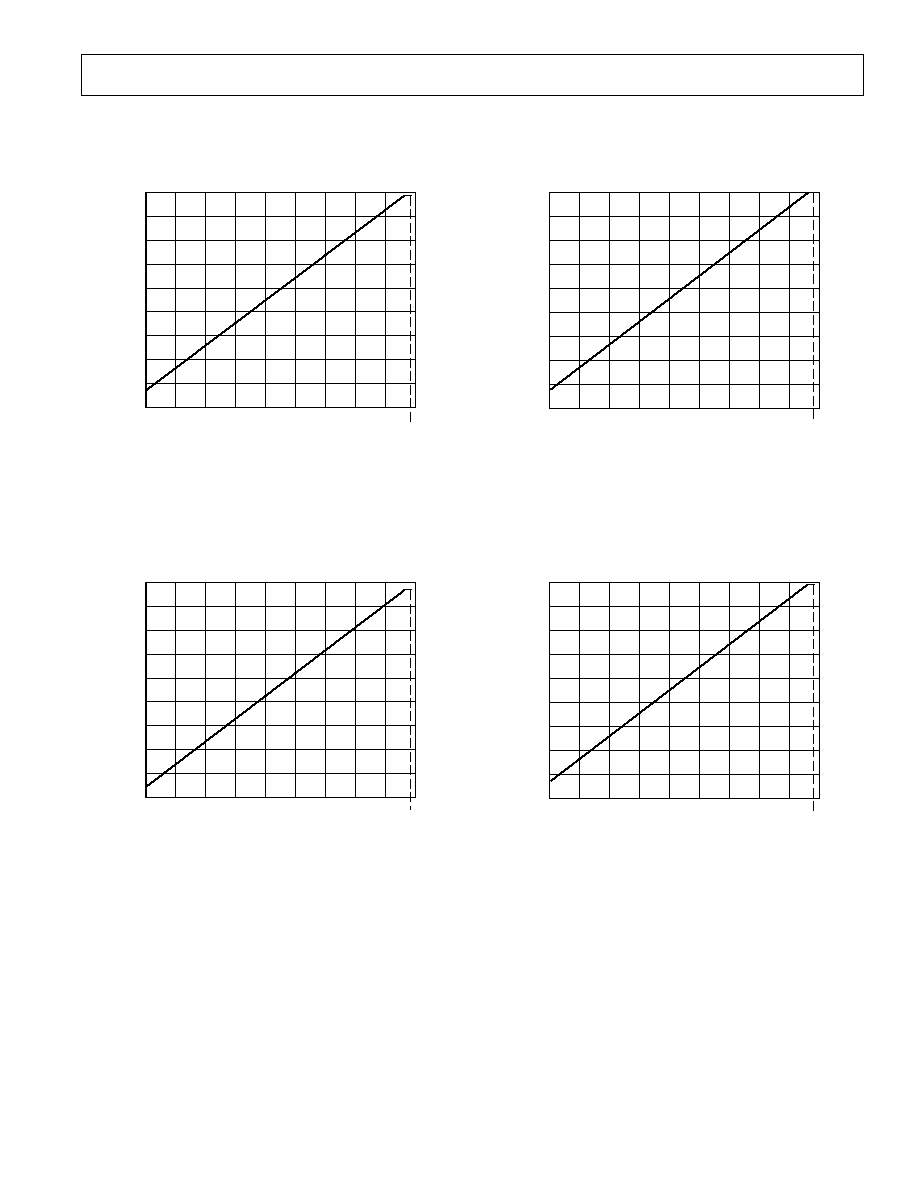
AD73322
13
REV. B
V
IN
dBm0
85
5
75
65
55
45
35
25
15
5
80
70
10
S/(N+D) dB
30
20
10
0
50
40
60
3.17
Figure 5. S/(N+D) vs. V
IN
(ADC @ 3 V) over Voiceband
Bandwidth (300 Hz3.4 kHz)
V
IN
dBm0
85
5
75
65
55
45
35
25
15
5
80
70
10
S/(N+D) dB
30
20
10
0
50
40
60
3.17
Figure 6. S/(N+D) vs. V
IN
(DAC @ 3 V) over Voiceband
Bandwidth (300 Hz3.4 kHz)
V
IN
dBm0
85
5
75
65
55
45
35
25
15
5
80
70
10
S/(N+D) dB
30
20
10
0
50
40
60
3.17
Figure 7. S/(N+D) vs. V
IN
(ADC @ 5 V) over Voiceband
Bandwidth (300 Hz3.4 kHz)
V
IN
dBm0
85
5
75
65
55
45
35
25
15
5
80
70
10
S/(N+D) dB
30
20
10
0
50
40
60
3.17
Figure 8. S/(N+D) vs. V
IN
(DAC @ 5 V) over Voiceband
Bandwidth (300 Hz3.4 kHz)
Typical Performance Characteristics
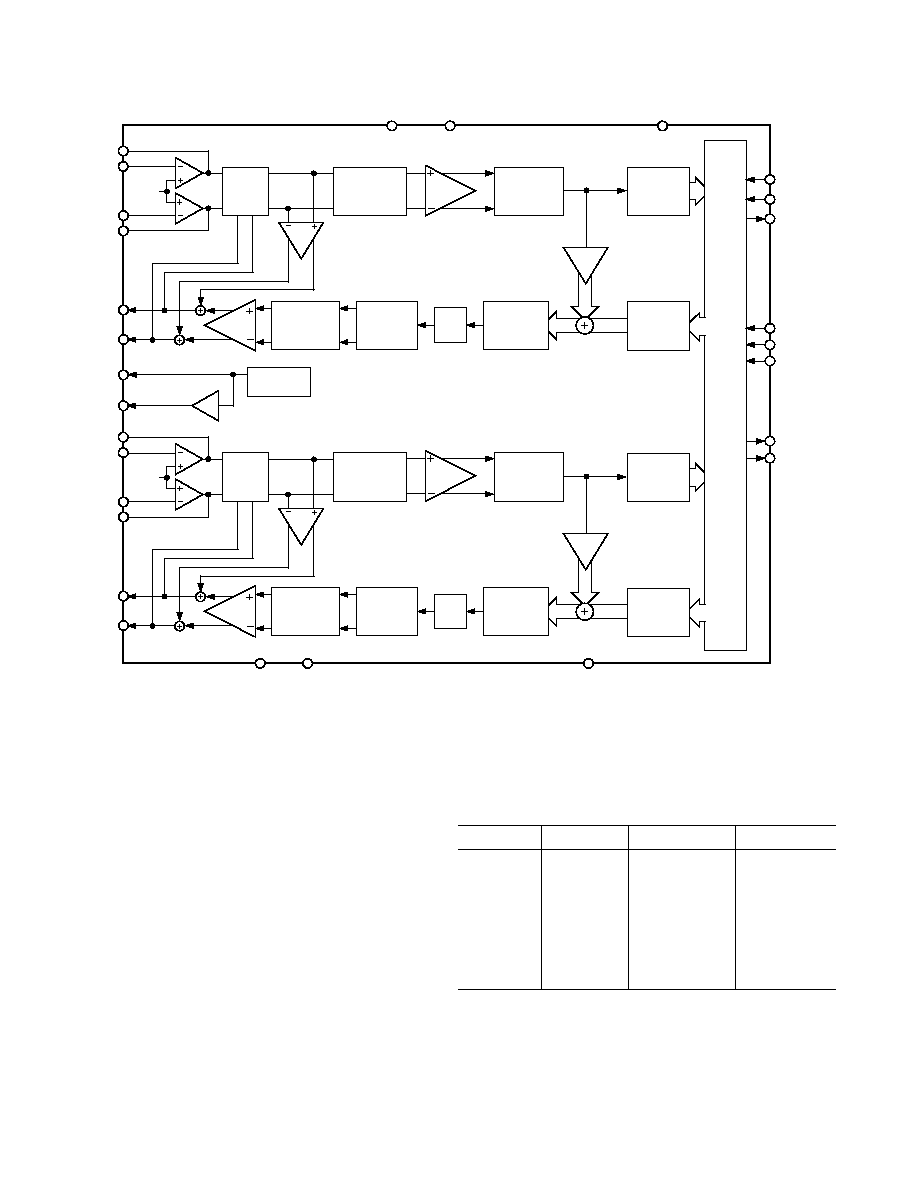
AD73322
14
REV. B
GAIN
1
INVERT
SINGLE-ENDED
ENABLE
0/38dB
PGA
DECIMATOR
SERIAL
I/O
PORT
+6/15dB
PGA
CONTINUOUS
TIME
LOW-PASS
FILTER
1-BIT
DAC
SWITCHED
CAPACITOR
LOW-PASS
FILTER
DIGITAL
SIGMA-
DELTA
MODULATOR
GAIN
1
INTER-
POLATOR
V
REF
VFBN1
VINN1
VINP1
VFBP1
VOUTP1
VOUTN1
REFCAP
REFOUT
DECIMATOR
+6/15dB
CONTINUOUS
TIME
LOW-PASS
FILTER
1-BIT
DAC
SWITCHED
CAPACITOR
LOW-PASS
FILTER
DIGITAL
SIGMA-
DELTA
MODULATOR
GAIN
1
INTER-
POLATOR
V
REF
VFBN2
VINN2
VINP2
VFBP2
VOUTP2
VOUTN2
AD73322
AGND1
AGND2
DGND
SDOFS
SDO
MCLK
SE
RESET
SCLK
SDIFS
SDI
DVDD
AVDD2
AVDD1
REFERENCE
PGA
ANALOG
SIGMA-DELTA
MODULATOR
ANALOG
LOOP
BACK
GAIN
1
INVERT
SINGLE-ENDED
ENABLE
0/38dB
PGA
ANALOG
SIGMA-DELTA
MODULATOR
ANALOG
LOOP
BACK
Figure 9. Functional Block Diagram
FUNCTIONAL DESCRIPTION
Encoder Channels
Both encoder channels consist of a pair of inverting op amps
with feedback connections that can be bypassed if required, a
switched capacitor PGA and a sigma-delta analog-to-digital
converter (ADC). An on-board digital filter, which forms part of
the sigma-delta ADC, also performs critical system-level filter-
ing. Due to the high level of oversampling, the input antialias
requirements are reduced such that a simple single pole RC
stage is sufficient to give adequate attenuation in the band of
interest.
Programmable Gain Amplifier
Each encoder section's analog front end comprises a switched
capacitor PGA, which also forms part of the sigma-delta modu-
lator. The SC sampling frequency is DMCLK/8. The PGA,
whose programmable gain settings are shown in Table IV, may
be used to increase the signal level applied to the ADC from low
output sources such as microphones, and can be used to avoid
placing external amplifiers in the circuit. The input signal level
to the sigma-delta modulator should not exceed the maximum
input voltage permitted.
The PGA gain is set by bits IGS0, IGS1 and IGS2 (CRD:02)
in control register D.
Table IV. PGA Settings for the Encoder Channel
IGS2
IGS1
IGS0
Gain (dB)
0
0
0
0
0
0
1
6
0
1
0
12
0
1
1
18
1
0
0
20
1
0
1
26
1
1
0
32
1
1
1
38
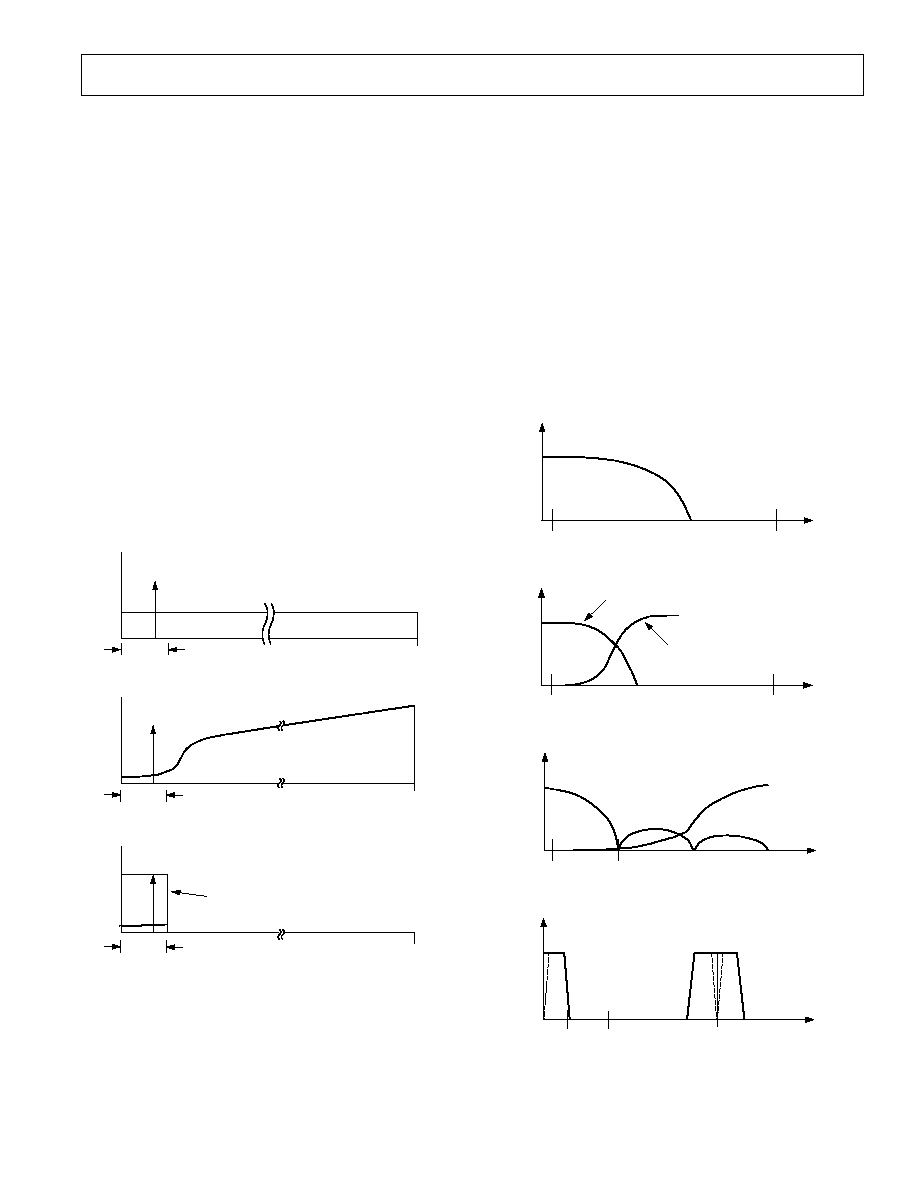
AD73322
15
REV. B
ADC
Both ADCs consist of an analog sigma-delta modulator and a
digital antialiasing decimation filter. The sigma-delta modu-
lator noise-shapes the signal and produces 1-bit samples at a
DMCLK/8 rate. This bitstream, representing the analog input
signal, is input to the antialiasing decimation filter. The decimation
filter reduces the sample rate and increases the resolution.
Analog Sigma-Delta Modulator
The AD73322's input channels employ a sigma-delta conver-
sion technique, which provides a high resolution 16-bit output
with system filtering being implemented on-chip.
Sigma-delta converters employ a technique known as over-
sampling, where the sampling rate is many times the highest
frequency of interest. In the case of the AD73322, the initial
sampling rate of the sigma-delta modulator is DMCLK/8. The
main effect of oversampling is that the quantization noise is
spread over a very wide bandwidth, up to F
S
/2 = DMCLK/16
(Figure 10a). This means that the noise in the band of interest is
much reduced. Another complementary feature of sigma-delta
converters is the use of a technique called noise-shaping. This
technique has the effect of pushing the noise from the band of
interest to an out-of-band position (Figure 10b). The combi-
nation of these techniques, followed by the application of a
digital filter, sufficiently reduces the noise in band to ensure
good dynamic performance from the part (Figure 10c).
BAND
OF
INTEREST
F
S
/2
DMCLK/16
F
S
/2
DMCLK/16
F
S
/2
DMCLK/16
DIGITAL FILTER
NOISE SHAPING
BAND
OF
INTEREST
BAND
OF
INTEREST
a.
b.
c.
Figure 10. Sigma-Delta Noise Reduction
Figure 11 shows the various stages of filtering that are employed
in a typical AD73322 application. In Figure 11a we see the
transfer function of the external analog antialias filter. Even
though it is a single RC pole, its cutoff frequency is sufficiently
far away from the initial sampling frequency (DMCLK/8) that it
takes care of any signals that could be aliased by the sampling
frequency. This also shows the major difference between the
initial oversampling rate and the bandwidth of interest. In Fig-
ure 11b, the signal and noise-shaping responses of the sigma-
delta modulator are shown. The signal response provides further
rejection of any high frequency signals while the noise-shaping
will push the inherent quantization noise to an out-of-band
position. The detail of Figure 11c shows the response of the
digital decimation filter (Sinc-cubed response) with nulls every
multiple of DMCLK/256, which corresponds to the decimation
filter update rate for a 64 kHz sampling. The nulls of the Sinc3
response correspond with multiples of the chosen sampling
frequency. The final detail in Figure 11d shows the application
of a final antialias filter in the DSP engine. This has the advan-
tage of being implemented according to the user's requirements
and available MIPS. The filtering in Figures 11a through 11c is
implemented in the AD73322.
F
B
= 4kHz
F
SINIT
= DMCLK/8
a. Analog Antialias Filter Transfer Function
F
B
= 4kHz
F
SINIT
= DMCLK/8
NOISE TRANSFER FUNCTION
SIGNAL TRANSFER FUNCTION
b. Analog Sigma-Delta Modulator Transfer Function
F
B
= 4kHz
F
SINTER
= DMCLK/256
c. Digital Decimator Transfer Function
F
B
= 4kHz
F
SINTER
= DMCLK/256
F
SFINAL
= 8kHz
d. Final Filter LPF (HPF) Transfer Function
Figure 11. ADC Frequency Responses
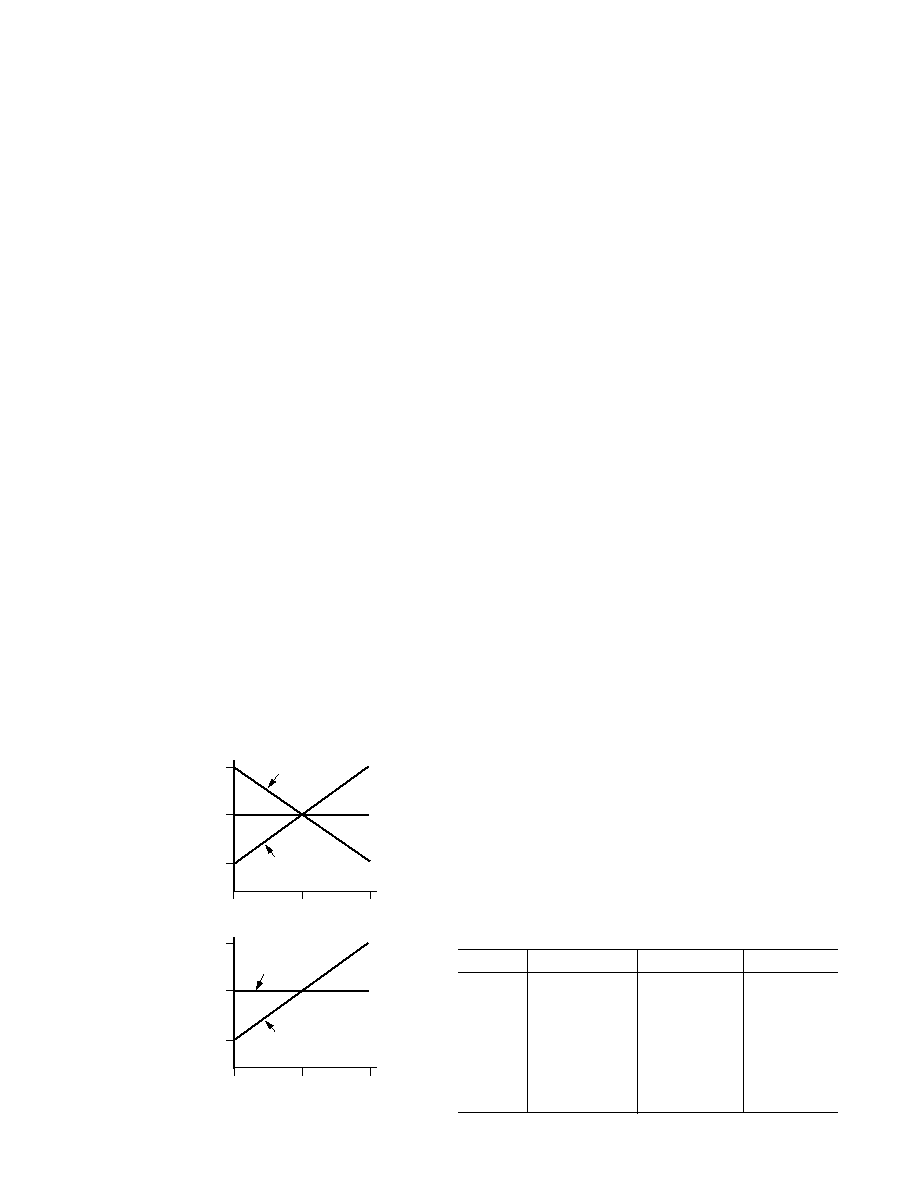
AD73322
16
REV. B
Decimation Filter
The digital filter used in the AD73322 carries out two important
functions. Firstly, it removes the out-of-band quantization
noise, which is shaped by the analog modulator and secondly, it
decimates the high frequency bit-stream to a lower rate 16-bit
word.
The antialiasing decimation filter is a sinc-cubed digital filter
that reduces the sampling rate from DMCLK/8 to DMCLK/256,
and increases the resolution from a single bit to 15 bits or greater
(depending on chosen sampling rate). Its Z transform is given
as:
[(1 Z
N
)/(1 Z
1
)]
3
where N is set by the sampling rate (N = 32 @ 64 kHz sampling
. . . N = 256 @ 8 kHz sampling). Thus when the sampling rate
is 64 kHz, a minimal group delay of 25
µ
s can be achieved.
Word growth in the decimator is determined by the sampling
rate. At 64 kHz sampling, where the oversampling ratio between
sigma-delta modulator and decimator output equals 32, there
are five bits per stage of the three-stage Sinc3 filter. Due to
symmetry within the sigma-delta modulator, the LSB will al-
ways be a zero; therefore, the 16-bit ADC output word will have
2 LSBs equal to zero, one due to the sigma-delta symmetry and
the other being a padding zero to make up the 16-bit word. At
lower sampling rates, decimator word growth will be greater
than the 16-bit sample word, therefore truncation occurs in
transferring the decimator output as the ADC word. For example,
at 8 kHz sampling, word growth reaches 24 bits due to the OSR
of 256 between sigma-delta modulator and decimator output.
This yields eight bits per stage of the three-stage Sinc3 filter.
ADC Coding
The ADC coding scheme is in twos complement format (see
Figure 12). The output words are formed by the decimation
filter, which grows the word length from the single-bit output of
the sigma-delta modulator to a word length of up to 24 bits
(depending on decimation rate chosen), which is the final out-
put of the ADC block. In Data Mode this value is truncated to
16 bits for output on the Serial Data Output (SDO) pin.
V
REF
+ (V
REF
0.32875)
V
REF
V
REF
(V
REF
0.32875)
10...00
00...00
01...11
ADC CODE DIFFERENTIAL
ANALOG
INPUT
V
INN
V
INP
V
REF
+ (V
REF
0.6575)
V
REF
(V
REF
0.6575)
10...00
00...00
01...11
ADC CODE SINGLE-ENDED
ANALOG
INPUT
V
INP
V
INN
Figure 12. ADC Transfer Function
In mixed Control/Data Mode, the resolution is fixed at 15 bits,
with the MSB of the 16-bit transfer being used as a flag bit to
indicate either control or data in the frame.
Decoder Channel
The decoder channels consist of digital interpolators, digital
sigma-delta modulators, single-bit digital-to-analog converters
(DAC), analog smoothing filters and programmable gain ampli-
fiers with differential outputs.
DAC Coding
The DAC coding scheme is in twos complement format with
0x7FFF being full-scale positive and 0x8000 being full-scale
negative.
Interpolation Filter
The anti-imaging interpolation filter is a sinc-cubed digital filter
that up-samples the 16-bit input words from the input sample
rate to a rate of DMCLK/8, while filtering to attenuate images
produced by the interpolation process. Its Z transform is given as:
[(1 Z
N
)/(1 Z
1
)]
3
where N is determined by the sampling rate (N = 32 @
64 kHz . . . N = 256 @ 8 kHz). The DAC receives 16-bit
samples from the host DSP processor at the programmed
sample rate of DMCLK/N. If the host processor fails to write a
new value to the serial port, the existing (previous) data is read
again. The data stream is filtered by the anti-imaging interpola-
tion filter, but there is an option to bypass the interpolator for
the minimum group delay configuration by setting the IBYP bit
(CRE:5) of Control register E. The interpolation filter has the
same characteristics as the ADC's antialiasing decimation filter.
The output of the interpolation filter is fed to the DAC's digital
sigma-delta modulator, which converts the 16-bit data to 1-bit
samples at a rate of DMCLK/8. The modulator noise-shapes
the signal so that errors inherent to the process are minimized in
the passband of the converter. The bit-stream output of the
sigma-delta modulator is fed to the single-bit DAC where it is
converted to an analog voltage.
Analog Smoothing Filter and PGA
The output of the single-bit DAC is sampled at DMCLK/8,
therefore it is necessary to filter the output to reconstruct the
low frequency signal. The decoder's analog smoothing filter
consists of a continuous-time filter preceded by a third-order
switched-capacitor filter. The continuous-time filter forms part
of the output programmable gain amplifier (PGA). The PGA
can be used to adjust the output signal level from 15 dB to
+6 dB in 3 dB steps, as shown in Table V. The PGA gain is
set by bits OGS0, OGS1 and OGS2 (CRD:4-6) in Control
Register D.
Table V. PGA Settings for the Decoder Channel
OGS2
OGS1
OGS0
Gain (dB)
0
0
0
+6
0
0
1
+3
0
1
0
0
0
1
1
3
1
0
0
6
1
0
1
9
1
1
0
12
1
1
1
15
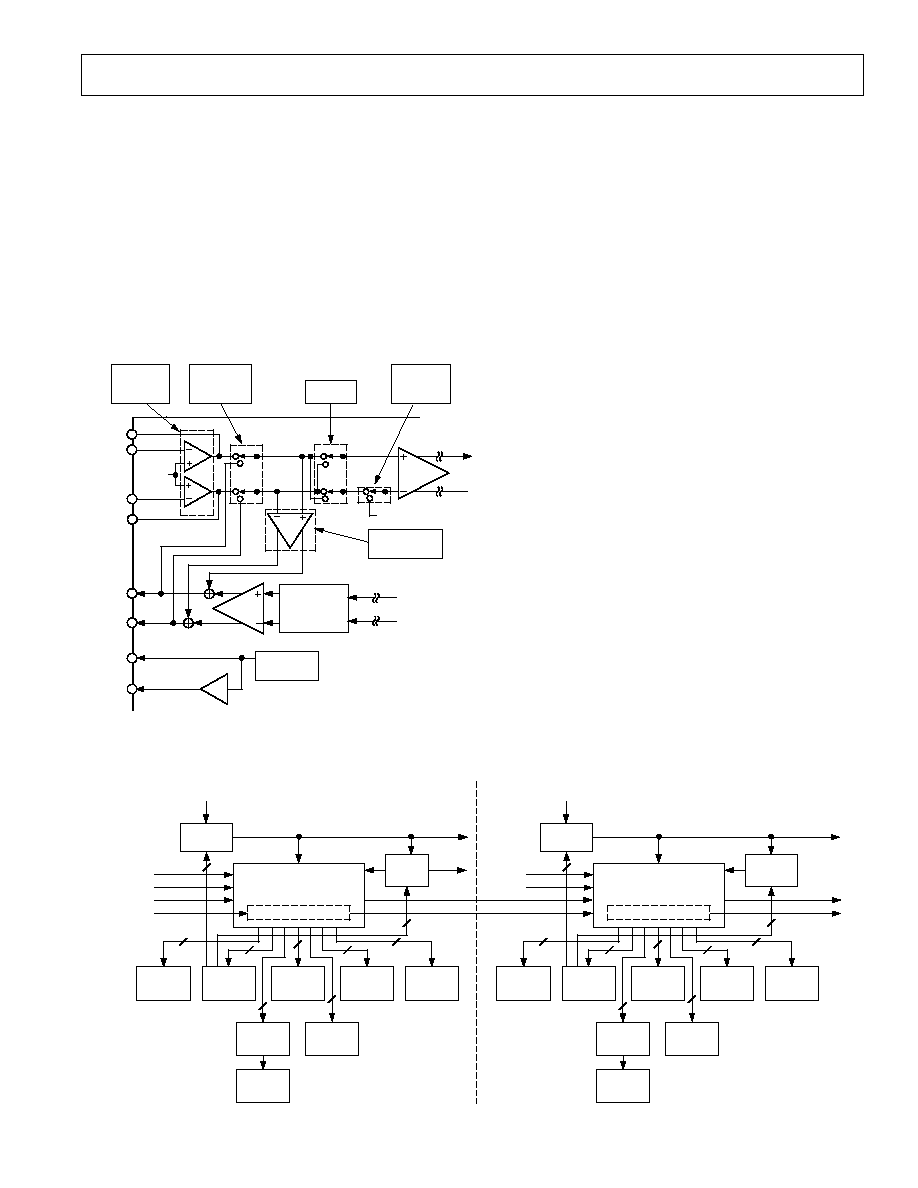
AD73322
17
REV. B
MCLK
DIVIDER
MCLK
EXTERNAL
SE
RESET
SDIFS
SDI
SERIAL PORT 1
(SPORT 1)
SERIAL REGISTER 1
SCLK
DIVIDER
SCLK
CONTROL
REGISTER
1B
CONTROL
REGISTER
1C
CONTROL
REGISTER
1D
CONTROL
REGISTER
1E
CONTROL
REGISTER
1A
CONTROL
REGISTER
1G
CONTROL
REGISTER
1F
CONTROL
REGISTER
1H
3
8
8
8
8
8
16
8
2
DMCLK INTERNAL
MCLK
DIVIDER
MCLK
EXTERNAL
SE
RESET
SDIFS2
SDI2
SERIAL PORT 2
(SPORT 2)
SERIAL REGISTER 2
SCLK
DIVIDER
CONTROL
REGISTER
2B
CONTROL
REGISTER
2C
CONTROL
REGISTER
2D
CONTROL
REGISTER
2E
CONTROL
REGISTER
2A
CONTROL
REGISTER
2G
CONTROL
REGISTER
2F
CONTROL
REGISTER
2H
3
8
8
8
8
8
16
8
2
DMCLK INTERNAL
SDOFS
SDO
SDOFS1
SDO1
Figure 14. SPORT Block Diagram
Differential Output Amplifiers
The decoder has a differential analog output pair (VOUTP and
VOUTN). The output channel can be muted by setting the
MUTE bit (CRD:7) in Control Register D. The output signal is
dc-biased to the codec's on-chip voltage reference.
Voltage Reference
The AD73322 reference, REFCAP, is a bandgap reference that
provides a low noise, temperature-compensated reference to the
DAC and ADC. A buffered version of the reference is also made
available on the REFOUT pin and can be used to bias other
external analog circuitry. The reference has a default nominal
value of 1.2 V, but can be set to a nominal value of 2.4 V by
setting the 5VEN bit (CRC:7) of CRC. The 5 V mode is gener-
ally only usable when AV
DD
= 5 V.
INVERTING
OP AMPS
ANALOG
LOOP-BACK
SELECT
INVERT
SINGLE-
ENDED
ENABLE
GAIN
1
+6/15dB
PGA
CONTINUOUS
TIME
LOW-PASS
FILTER
V
REF
VINN1
VINP1
VFBP1
VOUTP1
VOUTN1
REFCAP
REFOUT
REFERENCE
AD73322
V
REF
VFBN1
ANALOG GAIN
TAP
0/38dB
PGA
Figure 13. Analog Input/Output Section
The reference output (REFOUT) can be enabled for biasing
external circuitry by setting the RU bit (CRC:6) of CRC.
Analog and Digital Gain Taps
The AD73322 features analog and digital feedback paths be-
tween input and output. The amount of feedback is determined
by the gain setting which is programmed in the control registers.
This feature can typically be used for balancing the effective
impedance between input and output when used in Subscriber
Line Interface Circuit (SLIC) interfacing.
Analog Gain Tap
The analog gain tap is configured as a programmable differential
amplifier whose input is taken from the ADC's input signal path.
The output of the analog gain tap is summed with the output of
the DAC. The gain is programmable using Control Register F
(CRF:0-4) to achieve a gain of 1 to +1 in 32 steps with muting
being achieved through a separate control setting (Control Regis-
ter F Bit 7). The gain increment per step is 0.0625. The AGT is
enabled by powering-up the AGT control bit in the power con-
trol register (CRC:1). When this bit is set (=1) CRF becomes an
AGT control register with CRF:0-4 holding the AGT coeffi-
cient, CRF:5 becomes an AGT enable and CRF:7 becomes an
AGT mute control bit. Control bit CRF:5 connects/disconnects
the AGT output to the summer block at the output of the DAC
section while control bit CRF:7 overrides the gain tap setting
with a mute, (zero gain) setting. Table VI shows the gain versus
digital setting for the AGT.
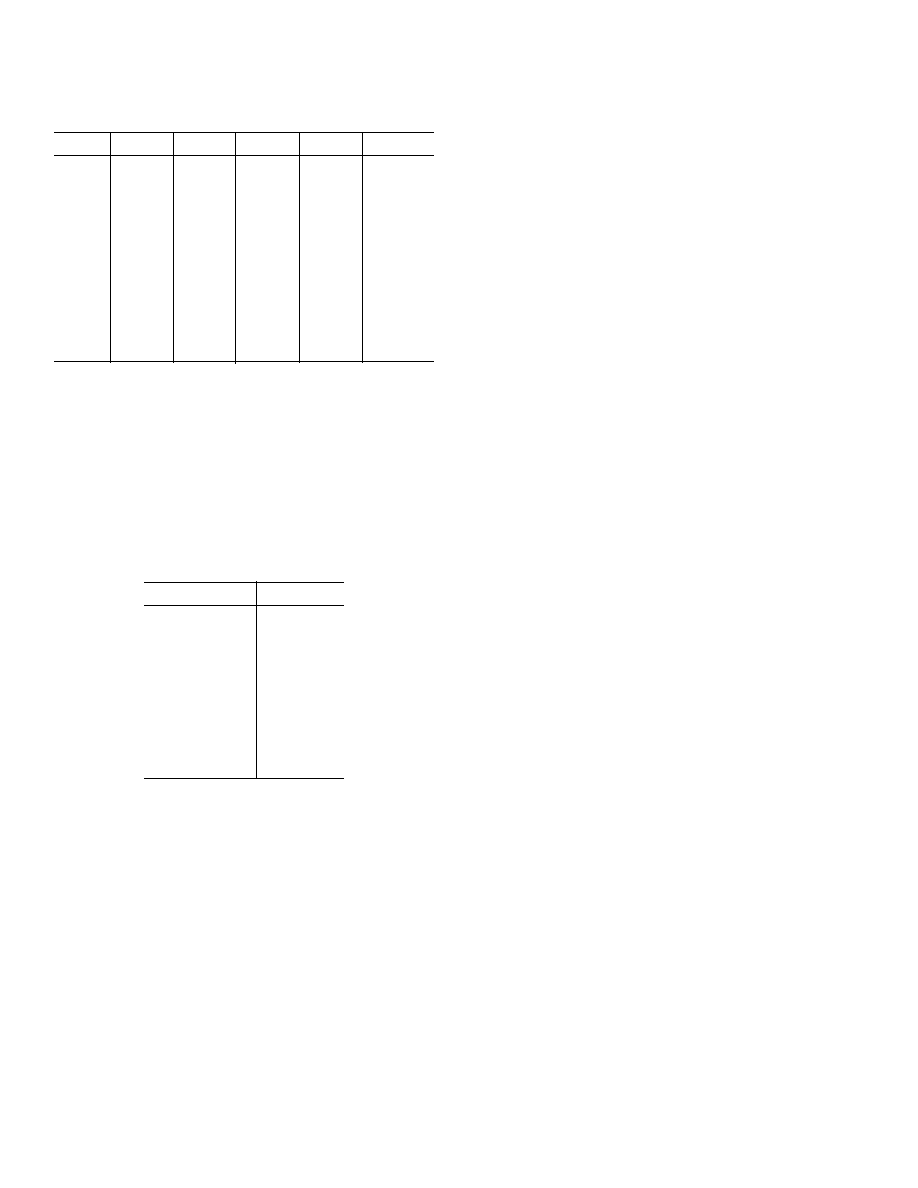
AD73322
18
REV. B
Table VI. Analog Gain Tap Settings*
AGTC4 AGTC3 AGTC2
AGTC1
AGTC0 Gain (dB)
0
0
0
0
0
+1.00
0
0
0
0
1
+0.9375
0
0
0
1
0
+0.875
0
0
0
1
1
+0.8125
0
0
1
0
0
+0.75
0
1
1
1
1
+0.0625
1
0
0
0
0
0.0625
1
1
1
0
1
0.875
1
1
1
1
0
0.9375
1
1
1
1
1
1.00
*AGT and DGT weights are given for the case of VFBNx (connected to the
sigma-delta modulator's positive input) being at a higher potential than VFBPx
(connected to the sigma-delta modulator's negative input).
Digital Gain Tap
The digital gain tap features a programmable gain block whose
input is taken from the bitstream output of the ADC's sigma-
delta modulator. This single bit input (1 or 0) is used to add or
subtract a programmable value, which is the digital gain tap setting,
to the output of the DAC section's interpolator. The program-
mable setting has 16-bit resolution and is programmed using the
settings in Control Registers G and H. (See Table VII).
Table VII. Digital Gain Tap Settings*
DGT150 (Hex)
Gain
0x8000
1.00
0x9000
0.875
0xA000
0.75
0xC000
0.5
0xE000
0.25
0x0000
0.00
0x2000
+0.25
0x4000
+0.05
0x6000
+0.75
0x7FFF
+0.99999
*AGT and DGT weights are given for the case of VFBNx (connected to the
sigma-delta modulator's positive input) being at a higher potential than VFBPx
(connected to the sigma-delta modulator's negative input).
Serial Port (SPORT)
The codecs communicate with a host processor via the bidirec-
tional synchronous serial port (SPORT), which is compatible
with most modern DSPs. The SPORT is used to transmit and
receive digital data and control information. The dual codec is
implemented using two separate codec blocks that are internally
cascaded with serial port access to the input of Codec1 and the
output of Codec2. This allows other single or dual codec de-
vices to be cascaded together (up to a limit of eight codec units).
In both transmit and receive modes, data is transferred at the
serial clock (SCLK) rate with the MSB being transferred first.
Due to the fact that the SPORT of each codec block uses a com-
mon serial register for serial input and output, communications
between an AD73322 codec and a host processor (DSP engine)
must always be initiated by the codecs themselves. In this con-
figuration the codecs are described as being in Master mode.
This ensures that there is no collision between input data and
output samples.
SPORT Overview
The AD73322 SPORT is a flexible, full-duplex, synchronous
serial port whose protocol has been designed to allow up to four
AD73322 devices (or combinations of AD73322 dual codecs
and AD73311 single codecs up to eight codec blocks) to be con-
nected, in cascade, to a single DSP via a six-wire interface. It has a
very flexible architecture that can be configured by programming
two of the internal control registers in each codec block. The
AD73322 SPORT has three distinct modes of operation: Control
Mode, Data Mode and Mixed Control/Data Mode.
NOTE: As each codec has its own SPORT section, the register
settings in both SPORTs must be programmed. The registers
that control SPORT and sample rate operation (CRA and CRB)
must be programmed with the same values, otherwise incorrect
operation may occur.
In Control Mode (CRA:0 = 0), the device's internal configura-
tion can be programmed by writing to the eight internal control
registers. In this mode, control information can be written to or
read from the codec. In Data Mode (CRA:0 = 1), (CRA:1 = 0),
information sent to the device is used to update the decoder
section (DAC), while the encoder section (ADC) data is read
from the device. In this mode, only DAC and ADC data is
written to or read from the device. Mixed mode (CRA:0 = 1
and CRA:1 = 1) allows the user to choose whether the informa-
tion being sent to the device contains either control information
or DAC data. This is achieved by using the MSB of the 16-bit
frame as a flag bit. Mixed mode reduces the resolution to 15 bits
with the MSB being used to indicate whether the information in
the 16-bit frame is control information or DAC/ADC data.
The SPORT features a single 16-bit serial register that is used
for both input and output data transfers. As the input and out-
put data must share the same register, some precautions must be
observed. The primary precaution is that no information must
be written to the SPORT without reference to an output sample
event, which is when the serial register will be overwritten with
the latest ADC sample word. Once the SPORT starts to output
the latest ADC word, it is safe for the DSP to write new control
or data words to the codec. In certain configurations, data can
be written to the device to coincide with the output sample
being shifted out of the serial register--see section on interfac-
ing devices. The serial clock rate (CRB:23) defines how many
16-bit words can be written to a device before the next output
sample event will happen.
The SPORT block diagram shown in Figure 14 details the
blocks associated with Codecs 1 and 2, including the eight
control registers (AH), external MCLK to internal DMCLK
divider and serial clock divider. The divider rates are controlled
by the setting of Control Register B. The AD73322 features a
master clock divider that allows users the flexibility of dividing
externally available high frequency DSP or CPU clocks to gen-
erate a lower frequency master clock internally in the codec,
which may be more suitable for either serial transfer or sampling
rate requirements. The master clock divider has five divider
options (
÷
1 default condition,
÷
2,
÷
3,
÷
4,
÷
5) that are set by
loading the master clock divider field in Register B with the
appropriate code (see Table VIII). Once the internal device master
clock (DMCLK) has been set using the master clock divider, the
sample rate and serial clock settings are derived from DMCLK.
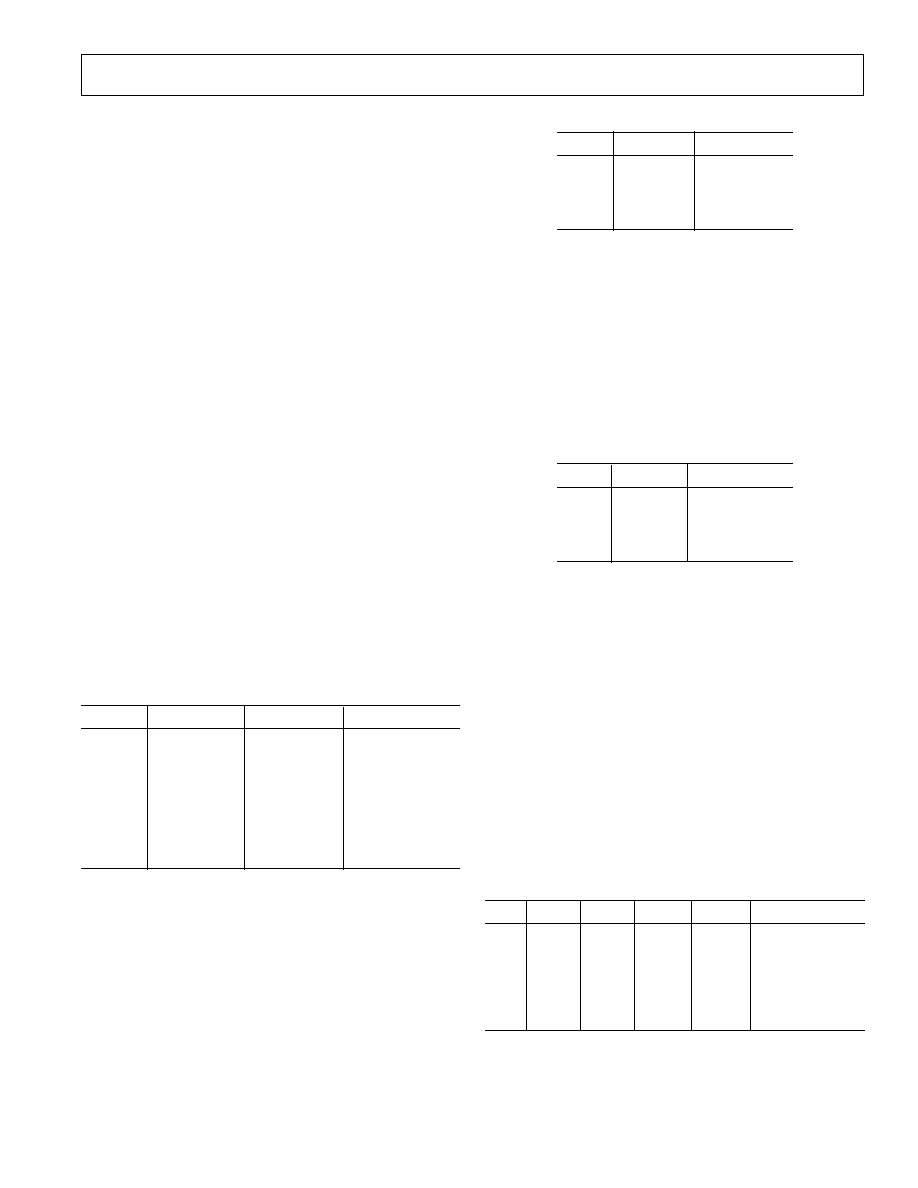
AD73322
19
REV. B
The SPORT can work at four different serial clock (SCLK)
rates: chosen from DMCLK, DMCLK/2, DMCLK/4 or
DMCLK/8, where DMCLK is the internal or device master
clock resulting from the external or pin master clock being
divided by the master clock divider.
SPORT Register Maps
There are two register banks for each codec in the AD73322:
the control register bank and the data register bank. The con-
trol register bank consists of eight read/write registers, each
eight bits wide. Table XII shows the control register map for
the AD73322. The first two control registers, CRA and CRB,
are reserved for controlling the SPORT. They hold settings for
parameters such as serial clock rate, internal master clock rate,
sample rate and device count. As both codecs are internally
cascaded, registers CRA and CRB on each codec must be pro-
grammed with the same setting to ensure correct operation (this
is shown in the programming examples). The other five regis-
ters; CRC through CRH are used to hold control settings for
the ADC, DAC, Reference, Power Control and Gain Tap
sections of the device. It is not necessary that the contents of
CRC through CRH on each codec be similar. Control regis-
ters are written to on the negative edge of SCLK. The data
register bank consists of two 16-bit registers that are the DAC
and ADC registers.
Master Clock Divider
The AD73322 features a programmable master clock divider
that allows the user to reduce an externally available master
clock, at pin MCLK, by one of the ratios 1, 2, 3, 4 or 5 to pro-
duce an internal master clock signal (DMCLK) that is used to
calculate the sampling and serial clock rates. The master clock
divider is programmable by setting CRB:4-6. Table VIII shows
the division ratio corresponding to the various bit settings. The
default divider ratio is divide-by-one.
Table VIII. DMCLK (Internal) Rate Divider Settings
MCD2
MCD1
MCD0
DMCLK Rate
0
0
0
MCLK
0
0
1
MCLK/2
0
1
0
MCLK/3
0
1
1
MCLK/4
1
0
0
MCLK/5
1
0
1
MCLK
1
1
0
MCLK
1
1
1
MCLK
Serial Clock Rate Divider
The AD73322 features a programmable serial clock divider that
allows users to match the serial clock (SCLK) rate of the data to
that of the DSP engine or host processor. The maximum SCLK
rate available is DMCLK and the other available rates are:
DMCLK/2, DMCLK/4 and DMCLK/8. The slowest rate
(DMCLK/8) is the default SCLK rate. The serial clock divider
is programmable by setting bits CRB:23. Table IX shows the
serial clock rate corresponding to the various bit settings.
Table IX. SCLK Rate Divider Settings
SCD1
SCD0
SCLK Rate
0
0
DMCLK/8
0
1
DMCLK/4
1
0
DMCLK/2
1
1
DMCLK
Sample Rate Divider
The AD73322 features a programmable sample rate divider that
allows users flexibility in matching the codec's ADC and DAC
sample rates (decimation/interpolation rates)to the needs of the
DSP software. The maximum sample rate available is DMCLK/
256, which offers the lowest conversion group delay, while the
other available rates are: DMCLK/512, DMCLK/1024 and
DMCLK/2048. The slowest rate (DMCLK/2048) is the default
sample rate. The sample rate divider is programmable by set-
ting bits CRB:0-1. Table X shows the sample rate correspond-
ing to the various bit settings.
Table X. Sample Rate Divider Settings
DIR1
DIR0
SCLK Rate
0
0
DMCLK/2048
0
1
DMCLK/1024
1
0
DMCLK/512
1
1
DMCLK/256
DAC Advance Register
The loading of the DAC is internally synchronized with the
unloading of the ADC data in each sampling interval. The de-
fault DAC load event happens one SCLK cycle before the
SDOFS flag is raised by the ADC data being ready. However,
this DAC load position can be advanced before this time by
modifying the contents of the DAC advance field in Control
Register E (CRE:04). The field is five bits wide, allowing 31
increments of weight 1/(F
S
×
32); see Table XI. The sample rate
F
S
is dependent on the setting of both the MCLK divider and
the Sample Rate divider; see Tables VIII and X. In certain cir-
cumstances this DAC update adjustment can reduce the group
delay when the ADC and DAC are used to process data in
series. Appendix C details how the DAC advance feature can be
used.
NOTE: The DAC advance register should not be changed while
the DAC section is powered up.
Table XI. DAC Timing Control
DA4
DA3
DA2
DA1
DA0
Time Advance
0
0
0
0
0
0 s
0
0
0
0
1
1/(F
S
×
32) s
0
0
0
1
0
2/(F
S
×
32) s
--
--
--
--
--
--
1
1
1
1
0
30/(F
S
×
32) s
1
1
1
1
1
31/(F
S
×
32) s
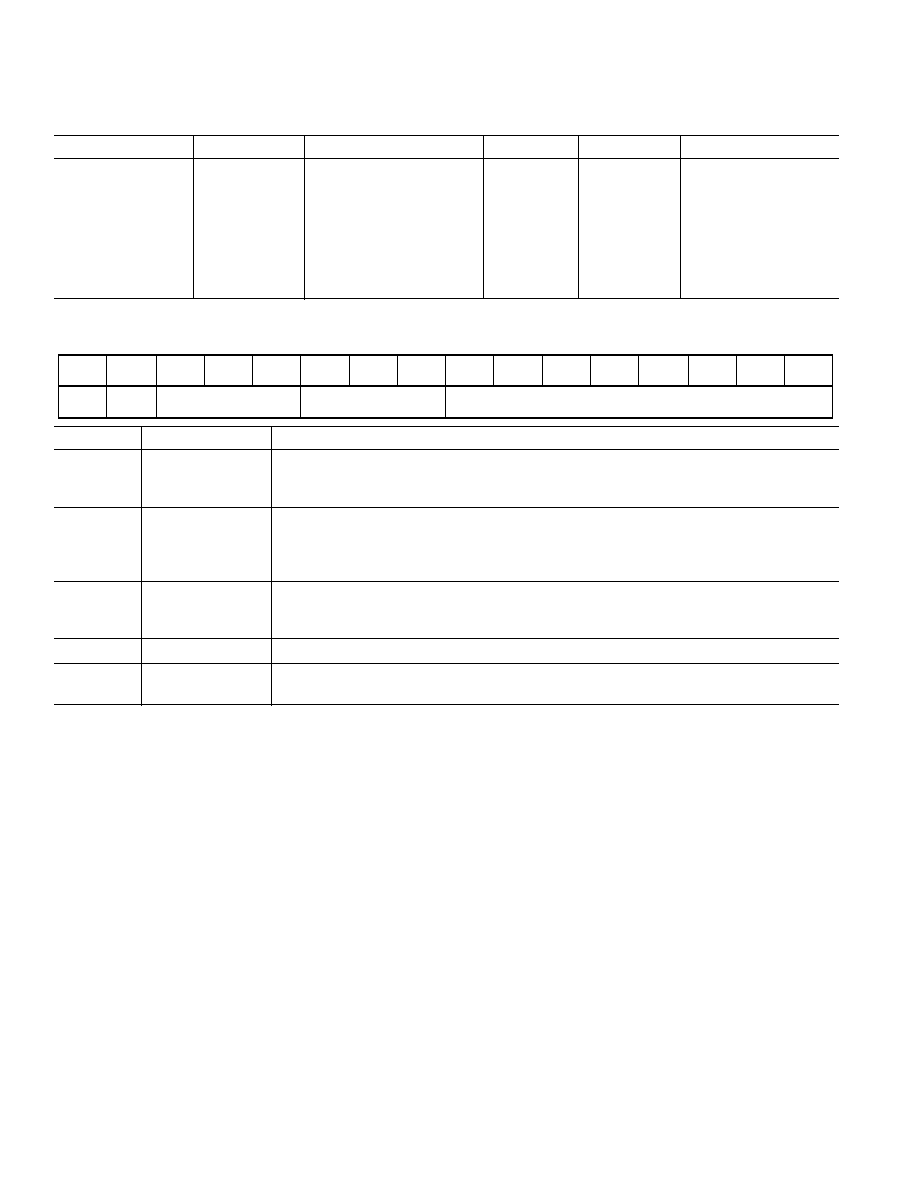
AD73322
20
REV. B
Table XII. Control Register Map
Address (Binary)
Name
Description
Type
Width
Reset Setting (Hex)
000
CRA
Control Register A
R/W
8
0x00
001
CRB
Control Register B
R/W
8
0x00
010
CRC
Control Register C
R/W
8
0x00
011
CRD
Control Register D
R/W
8
0x00
100
CRE
Control Register E
R/W
8
0x00
101
CRF
Control Register F
R/W
8
0x00
110
CRG
Control Register G
R/W
8
0x00
111
CRH
Control Register H
R/W
8
0x00
Table XIII. Control Word Description
15
14
13
12
11
10
9
8
7
6
5
4
3
2
1
0
C/D
R/W
Device Address
Register Address
Register Data
Control
Frame
Description
Bit 15
Control/Data
When set high, it signifies a control word in Program or Mixed Program/Data Modes. When
set low, it signifies a data word in Mixed Program/Data Mode or an invalid control word in
Program Mode.
Bit 14
Read/Write
When set low, it tells the device that the data field is to be written to the register selected by
the register field setting provided the address field is zero. When set high, it tells the device
that the selected register is to be written to the data field in the input serial register and that
the new control word is to be output from the device via the serial output.
Bits 1311
Device Address
This 3-bit field holds the address information. Only when this field is zero is a device se-
lected. If the address is not zero, it is decremented and the control word is passed out of
the device via the serial output.
Bits 108
Register Address
This 3-bit field is used to select one of the eight control registers on the AD73322.
Bits 70
Register Data
This 8-bit field holds the data that is to be written to or read from the selected register
provided the address field is zero.
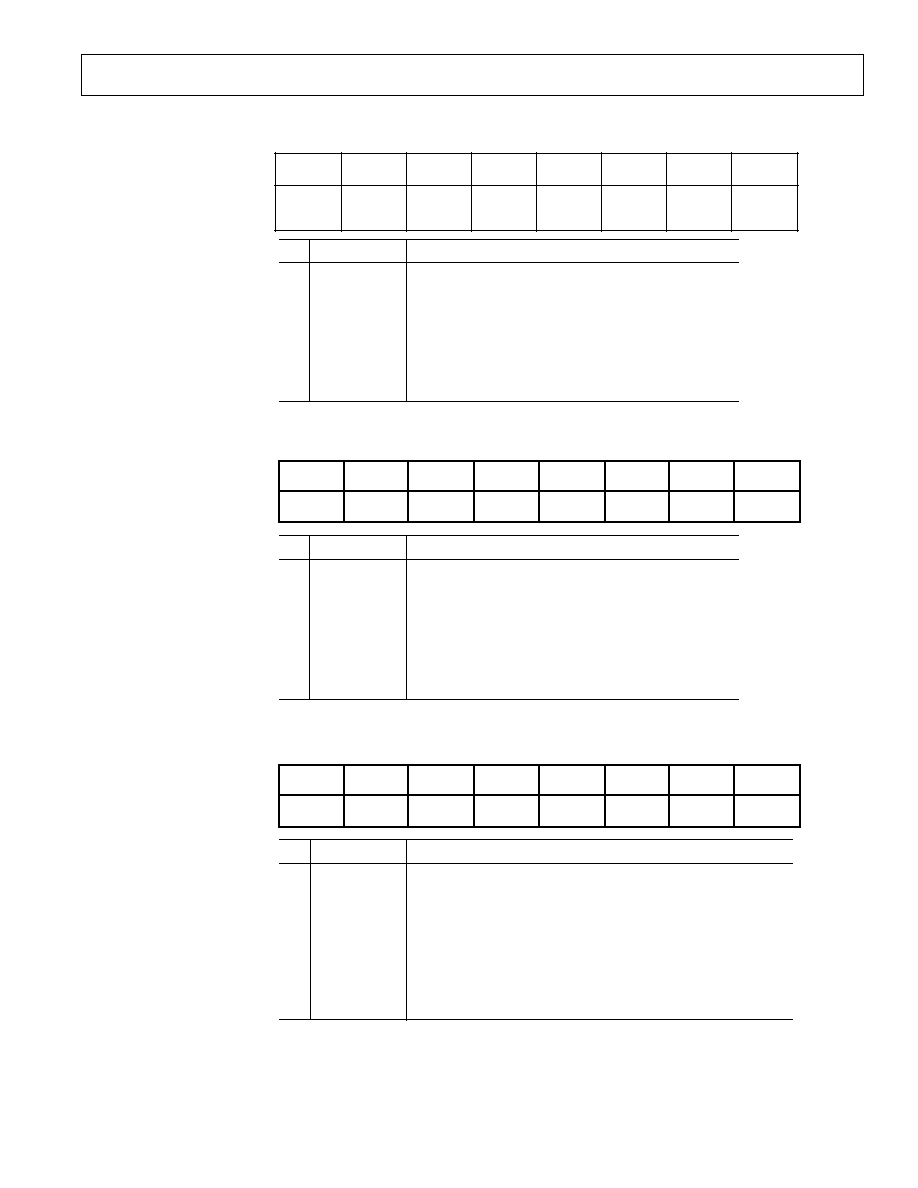
AD73322
21
REV. B
Table XIV. Control Register A Description
CONTROL REGISTER A
7
6
5
4
3
2
1
0
T
E
S
E
R
2
C
D
1
C
D
0
C
D
B
L
S
B
L
D
M
M
/
A
T
A
D
M
G
P
Bit
Name
Description
0
DATA/PGM
Operating Mode (0 = Program; 1 = Data Mode)
1
MM
Mixed Mode (0 = Off; 1 = Enabled)
2
DLB
Digital Loop-Back Mode (0 = Off; 1 = Enabled)
3
SLB
SPORT Loop-Back Mode (0 = Off; 1 = Enabled)
4
DC0
Device Count (Bit 0)
5
DC1
Device Count (Bit 1)
6
DC2
Device Count (Bit 2)
7
RESET
Software Reset (0 = Off; 1 = Initiates Reset)
Table XV. Control Register B Description
CONTROL REGISTER B
7
6
5
4
3
2
1
0
CEE
MCD2
MCD1
MCD0
SCD1
SCD0
DIR1
DIR0
Bit
Name
Description
0
DIR0
Decimation/Interpolation Rate (Bit 0)
1
DIR1
Decimation/Interpolation Rate (Bit 1)
2
SCD0
Serial Clock Divider (Bit 0)
3
SCD1
Serial Clock Divider (Bit 1)
4
MCD0
Master Clock Divider (Bit 0)
5
MCD1
Master Clock Divider (Bit 1)
6
MCD2
Master Clock Divider (Bit 2)
7
CEE
Control Echo Enable (0 = Off; 1 = Enabled)
Table XVI. Control Register C Description
CONTROL REGISTER C
7
6
5
4
3
2
1
0
5VEN
RU
PUREF
PUDAC
PUADC
PUIA
PUAGT
PU
Bit
Name
Description
0
PU
Power-Up Device (0 = Power-Down; 1 = Power On)
1
PUAGT
Analog Gain Tap Power (0 = Power-Down; 1 = Power On)
2
PUIA
Input Amplifier Power (0 = Power-Down; 1 = Power On)
3
PUADC
ADC Power (0 = Power-Down; 1 = Power On)
4
PUDAC
DAC Power (0 = Power-Down; 1 = Power On)
5
PUREF
REF Power (0 = Power-Down; 1 = Power On)
6
RU
REFOUT Use (0 = Disable REFOUT; 1 = Enable REFOUT)
7
5VEN
Enable 5 V Operating Mode (0 = Disable 5 V Mode;
1 = Enable 5 V Mode)
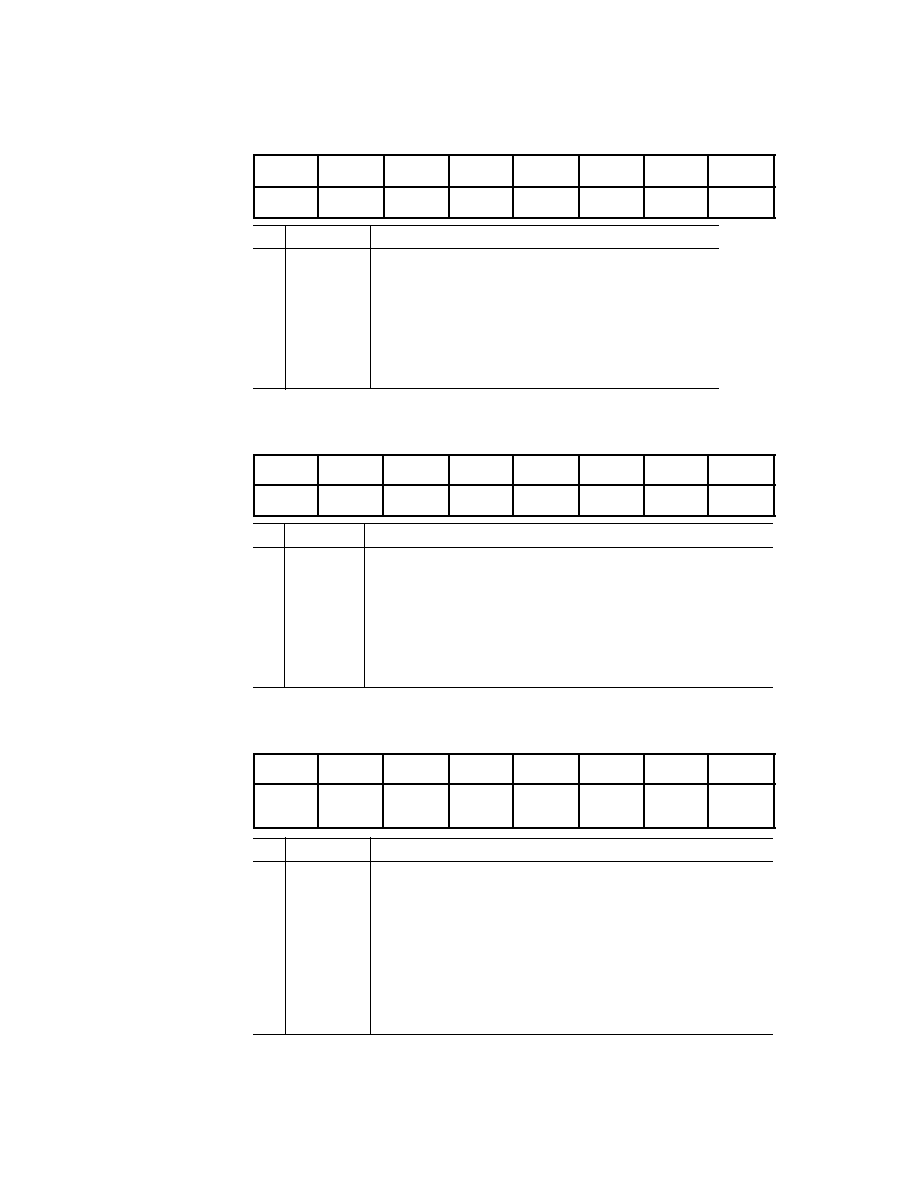
AD73322
22
REV. B
Table XVII. Control Register D Description
CONTROL REGISTER D
7
6
5
4
3
2
1
0
MUTE
OGS2
OGS1
OGS0
RMOD
IGS2
IGS1
IGS0
Bit
Name
Description
0
IGS0
Input Gain Select (Bit 0)
1
IGS1
Input Gain Select (Bit 1)
2
IGS2
Input Gain Select (Bit 2)
3
RMOD
Reset ADC Modulator (0 = Off; 1 = Reset Enabled)
4
OGS0
Output Gain Select (Bit 0)
5
OGS1
Output Gain Select (Bit 1)
6
OGS2
Output Gain Select (Bit 2)
7
MUTE
Output Mute (0 = Mute Off; 1 = Mute Enabled)
Table XVIII. Control Register E Description
CONTROL REGISTER E
7
6
5
4
3
2
1
0
--
DGTE
IBYP
DA4
DA3
DA2
DA1
DA0
Bit
Name
Description
0
DA0
DAC Advance Setting (Bit 0)
1
DA1
DAC Advance Setting (Bit 1)
2
DA2
DAC Advance Setting (Bit 2)
3
DA3
DAC Advance Setting (Bit 3)
4
DA4
DAC Advance Setting (Bit 4)
5
IBYP
Interpolator Bypass (0 = Bypass Disabled; 1 = Bypass Enabled)
6
DGTE
Digital Gain Tap Enable (0 = Disabled; 1 = Enabled)
7
--
Reserved (Program to 0)
Table XIX. Control Register F Description
CONTROL REGISTER F
7
6
5
4
3
2
1
0
ALB/
AGTM
INV
SEEN/
AGTE
AGTC4
AGTC3
AGTC2
AGTC1
AGTC0
Bit
Name
Description
0
AGTC0
Analog Gain Tap Coefficient (Bit 0)
1
AGTC1
Analog Gain Tap Coefficient (Bit 1)
2
AGTC2
Analog Gain Tap Coefficient (Bit 2)
3
AGTC3
Analog Gain Tap Coefficient (Bit 3)
4
AGTC4
Analog Gain Tap Coefficient (Bit 4)
5
SEEN/
Single-Ended Enable (0 = Disabled; 1 = Enabled)
AGTE
Analog Gain Tap Enable (0 = Disabled; 1 = Enabled)
6
INV
Input Invert (0 = Disabled; 1 = Enabled)
7
ALB/
Analog Loopback of Output to Input (0 = Disabled; 1 = Enabled)
AGTM
Analog Gain Tap Mute (0 = Off; 1 = Muted)
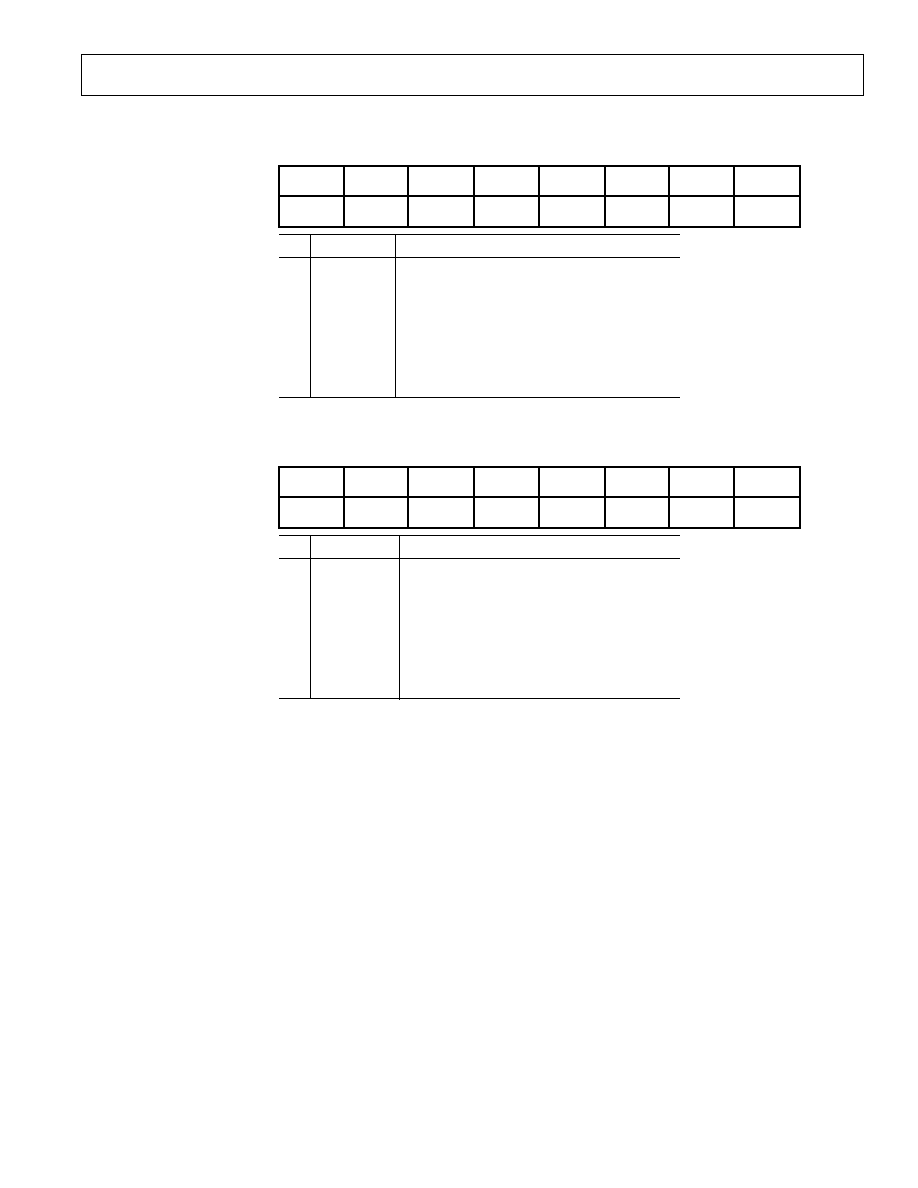
AD73322
23
REV. B
Table XX. Control Register G Description
CONTROL REGISTER G
7
6
5
4
3
2
1
0
DGTC7
DGTC6
DGTC5
DGTC4
DGTC3
DGTC2
DGTC1
DGTC0
Bit
Name
Description
0
DGTC0
Digital Gain Tap Coefficient (Bit 0)
1
DGTC1
Digital Gain Tap Coefficient (Bit 1)
2
DGTC2
Digital Gain Tap Coefficient (Bit 2)
3
DGTC3
Digital Gain Tap Coefficient (Bit 3)
4
DGTC4
Digital Gain Tap Coefficient (Bit 4)
5
DGTC5
Digital Gain Tap Coefficient (Bit 5)
6
DGTC6
Digital Gain Tap Coefficient (Bit 6)
7
DGTC7
Digital Gain Tap Coefficient (Bit 7)
Table XXI. Control Register H Description
CONTROL REGISTER H
7
6
5
4
3
2
1
0
DGTC15 DGTC14 DGTC13 DGTC12 DGTC11 DGTC10
DGTC9
DGTC8
Bit
Name
Description
0
DGTC8
Digital Gain Tap Coefficient (Bit 8)
1
DGTC9
Digital Gain Tap Coefficient (Bit 9)
2
DGTC10
Digital Gain Tap Coefficient (Bit 10)
3
DGTC11
Digital Gain Tap Coefficient (Bit 11)
4
DGTC12
Digital Gain Tap Coefficient (Bit 12)
5
DGTC13
Digital Gain Tap Coefficient (Bit 13)
6
DGTC14
Digital Gain Tap Coefficient (Bit 14)
7
DGTC15
Digital Gain Tap Coefficient (Bit 15)
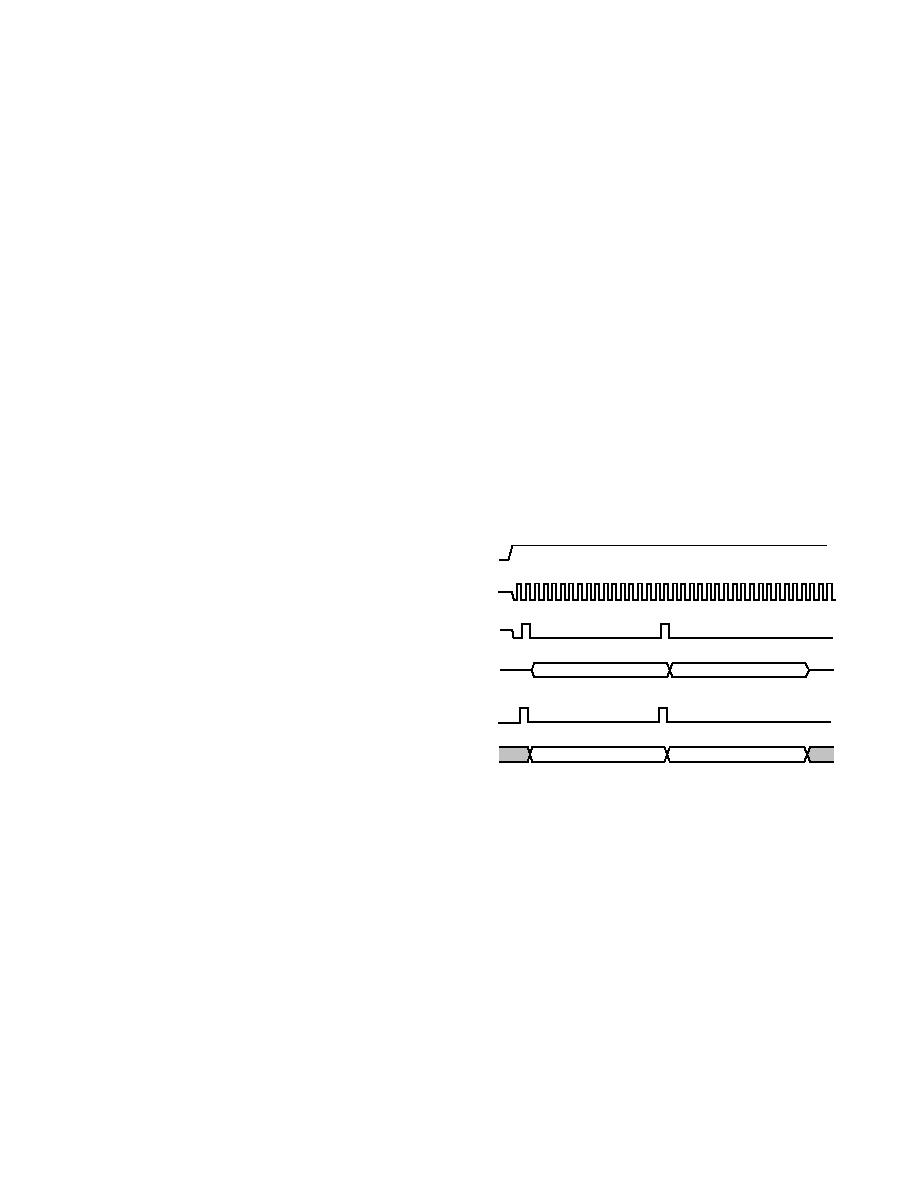
AD73322
24
REV. B
OPERATION
Resetting the AD73322
The RESET pin resets all the control registers. All registers are
reset to zero, indicating that the default SCLK rate (DMCLK/
8) and sample rate (DMCLK/2048) are at a minimum to ensure
that slow speed DSP engines can communicate effectively. As
well as resetting the control registers using the RESET pin, the
device can be reset using the RESET bit (CRA:7) in Control
Register A. Both hardware and software resets require four
DMCLK cycles. On reset, DATA/PGM (CRA:0) is set to 0
(default condition) thus enabling Program Mode. The reset
conditions ensure that the device must be programmed to the
correct settings after power-up or reset. Following a reset, the
SDOFS will be asserted 2048 DMCLK cycles after RESET
going high. The data that is output following reset and during
Program Mode is random and contains no valid information
until either data or mixed mode is set.
Power Management
The individual functional blocks of the AD73322 can be en-
abled separately by programming the power control register
CRC. It allows certain sections to be powered down if not re-
quired, which adds to the device's flexibility in that the user
need not incur the penalty of having to provide power for a
certain section if it is not necessary to their design. The power
control registers provide individual control settings for the major
functional blocks on each codec unit and also a global override
that allows all sections to be powered up by setting the bit.
Using this method the user could, for example, individually
enable a certain section, such as the reference (CRC:5), and
disable all others. The global power-up (CRC:0) can be used to
enable all sections, but if power-down is required using the
global control, the reference will still be enabled, in this case,
because its individual bit is set. Refer to Table XVI for details of
the settings of CRC.
NOTE: As both codec units share a common reference, the
reference control bits (CRC:5-7) in each SPORT are wire ORed
to allow either device to control the reference.
Operating Modes
There are three main modes of operation available on the AD73322;
Program, Data and Mixed Program/Data modes. Two other
operating modes are typically reserved as diagnostic modes:
Digital and SPORT Loop-Back. The device configuration--
register settings--can be changed only in Program and Mixed
Program/Data Modes. In all modes, transfers of information to
or from the device occur in 16-bit packets, therefore the DSP
engine's SPORT will be programmed for 16-bit transfers.
Program (Control) Mode
In Program Mode, CRA:0 = 0, the user writes to the control
registers to set up the device for desired operation--SPORT
operation, cascade length, power management, input/output
gain, etc. In this mode, the 16-bit information packet sent to the
device by the DSP engine is interpreted as a control word whose
format is shown in Table XIII. In this mode, the user must
address the device to be programmed using the address field of
the control word. This field is read by the device and if it is zero
(000 bin), the device recognizes the word as being addressed to
it. If the address field is not zero, it is then decremented and the
control word is passed out of the device--either to the next device
in a cascade or back to the DSP engine. This 3-bit address
format allows the user to uniquely address any one of up to
eight devices in a cascade; please note that this addressing
scheme is valid only in sending control information to the device
--a different format is used to send DAC data to the device(s).
As the AD73322 is a dual codec, it features two separate device
addresses for programming purposes. If the AD73322 is used in
a standalone configuration connected to a DSP, the two device
addresses correspond to 0 and 1. If, on the other hand, the
AD73322 is configured in a cascade of multiple, dual or single
codecs (AD73322 or AD73311), its device addresses corre-
spond with its hardwired position in the cascade.
Following reset, when the SE pin is enabled, the codec responds
by raising the SDOFS pin to indicate that an output sample
event has occurred. Control words can be written to the device
to coincide with the data being sent out of the SPORT, as
shown in Figure 15, or they can lag the output words by a time
interval that should not exceed the sample interval. After reset,
output frame sync pulses will occur at a slower default sample
rate, which is DMCLK/2048, until Control Register B is
programmed, after which the SDOFS pulses will be set ac-
cording to the contents of DIR0-1. This is to allow slow con-
troller devices to establish communication with the AD73322.
During Program Mode, the data output by the device is random
and should not be interpreted as ADC data.
SAMPLE WORD (DEVICE 2)
SE
SDOFS
SCLK
SDO
SDIFS
SDI
SAMPLE WORD (DEVICE 1)
CONTROL WORD (DEVICE 2)
CONTROL WORD (DEVICE 1)
Figure 15. Interface Signal Timing for Control Mode
Operation
Data Mode
Once the device has been configured by programming the cor-
rect settings to the various control registers, the device may exit
Program Mode and enter Data Mode. This is done by program-
ming the DATA/PGM (CRA:0) bit to a 1 and MM (CRA:1) to
0. Once the device is in Data Mode, the 16-bit input data frame
is now interpreted as DAC data rather than a control frame.
This data is therefore loaded directly to the DAC register. In
Data Mode, see Figure 16, as the entire input data frame con-
tains DAC data, the device relies on counting the number of
input frame syncs received at the SDIFS pin. When that num-
ber equals the device count stored in the device count field of
CRA, the device knows that the present data frame being re-
ceived is its own DAC update data. When the device is in nor-
mal Data Mode (i.e., mixed mode disabled), it must receive a
hardware reset to reprogram any of the control register settings.
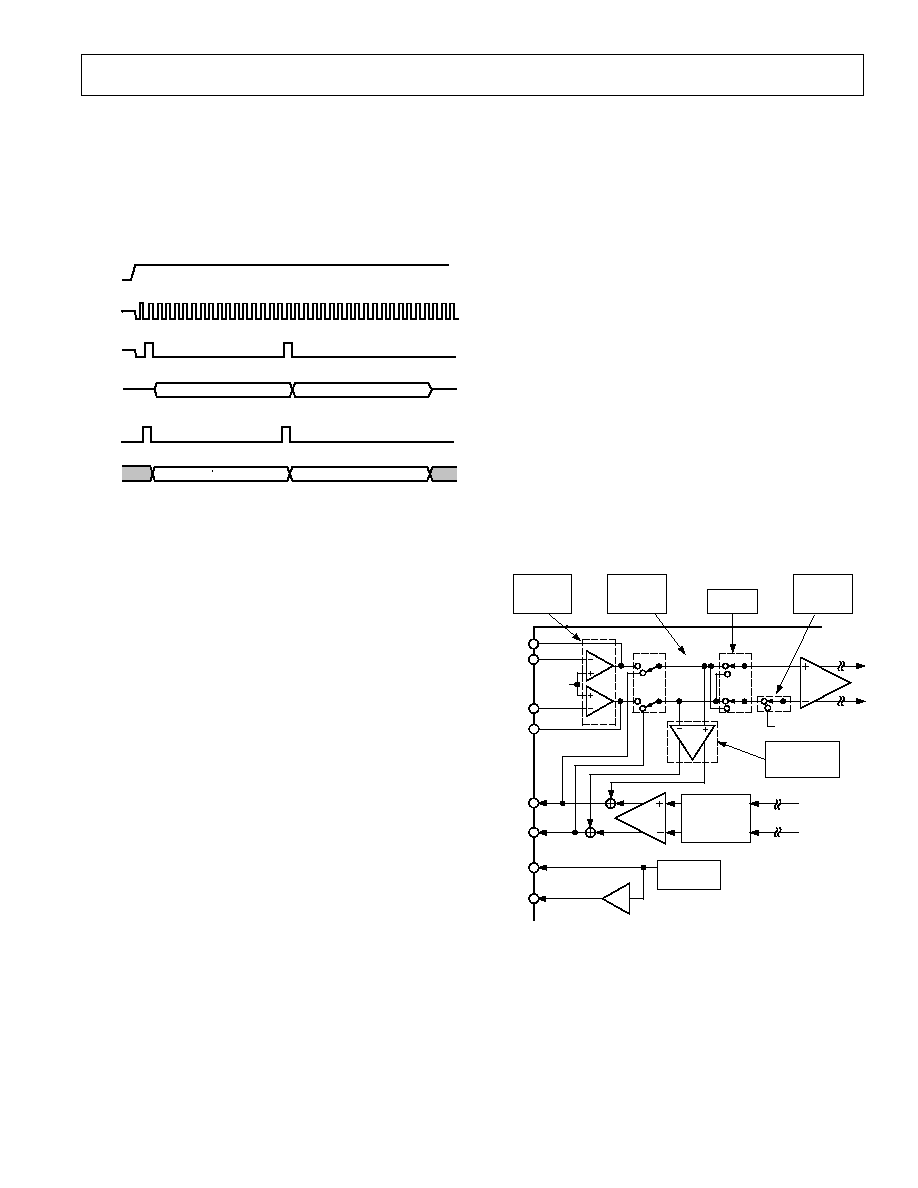
AD73322
25
REV. B
In a single AD73322 configuration, each 16-bit data frame sent
from the DSP to the device is interpreted as DAC data, but it is
necessary to send two DAC words per sample period in order to
ensure DAC update. Also, as the device count setting defaults
to 1, it must be set to 2 (001b) to ensure correct update of both
DACs on the AD73322.
Appendix B details the initialization and operation of an AD73322
in normal Data Mode.
SE
SDOFS
SCLK
SDO
SDIFS
SDI
ADC SAMPLE WORD (DEVICE 2)
ADC SAMPLE WORD (DEVICE 1)
DAC DATA WORD (DEVICE 2)
DAC DATA WORD (DEVICE 1)
Figure 16. Interface Signal Timing for Data Mode
Operation
Mixed Program/Data Mode
This mode allows the user to send control words to the device
along with the DAC data. This permits adaptive control of the
device whereby control of the input/output gains etc., can be
affected by interleaving control words along with the normal
flow of DAC data. The standard data frame remains 16 bits, but
now the MSB is used as a flag bit to indicate whether the re-
maining 15 bits of the frame represent DAC data or control
information. In the case of DAC data, the 15 bits are loaded
with MSB justification and LSB set to 0 to the DAC register.
Mixed mode is enabled by setting the MM bit (CRA:1) to 1 and
the DATA/PGM bit (CRA:0) to 1. In the case where control
setting changes will be required during normal operation, this
mode allows the ability to load both control and data informa-
tion with the slight inconvenience of formatting the data. Note
that the output samples from the ADC will also have the MSB
set to zero to indicate it is a data word.
Appendix C details the initialization and operation of an AD73322
operating in mixed mode. Note that it is not essential to load
the control registers in Program Mode before setting mixed
mode active. It is also possible to initiate mixed mode by pro-
gramming CRA with the first control word and then interleaving
control words with DAC data.
Digital Loop-Back
This mode can be used for diagnostic purposes and allows the
user to feed the ADC samples from the ADC register directly to
the DAC register. This forms a loop-back of the analog input to
the analog output by reconstructing the encoded signal using
the decoder channel. The serial interface will continue to work,
which allows the user to control gain settings, etc. Only when
DLB is enabled with mixed mode operation can the user disable
the DLB, otherwise the device must be reset.
SPORT Loop-Back
This mode allows the user to verify the DSP interfacing and
connection by writing words to the SPORT of the devices and
have them returned back unchanged after a delay of 16 SCLK
cycles. The frame sync and data word that are sent to the device
are returned via the output port. Again, SLB mode can only be
disabled when used in conjunction with mixed mode, otherwise
the device must be reset.
Analog Loop-Back
In Analog Loop-Back mode, the differential DAC output is
connected, via a loop-back switch, to the ADC input (see Figure
17). This mode allows the ADC channel to check functionality
of the DAC channel as the reconstructed output signal can be
monitored using the ADC as a sampler. Analog Loop-Back is
enabled by setting the ALB bit (CRF:7).
NOTE: Analog Loop-Back can only be enabled if the Analog
Gain Tap is powered down (CRC:1 = 0).
INVERTING
OP AMPS
ANALOG
LOOP-BACK
SELECT
INVERT
SINGLE-
ENDED
ENABLE
GAIN
1
+6/15dB
PGA
CONTINUOUS
TIME
LOW-PASS
FILTER
V
REF
VFBN1
VINN1
VINP1
VFBP1
VOUTP1
VOUTN1
REFCAP
REFOUT
REFERENCE
0/38dB
PGA
AD73322
V
REF
ANALOG GAIN
TAP POWERED
DOWN
Figure 17. Analog Loop-Back Connectivity
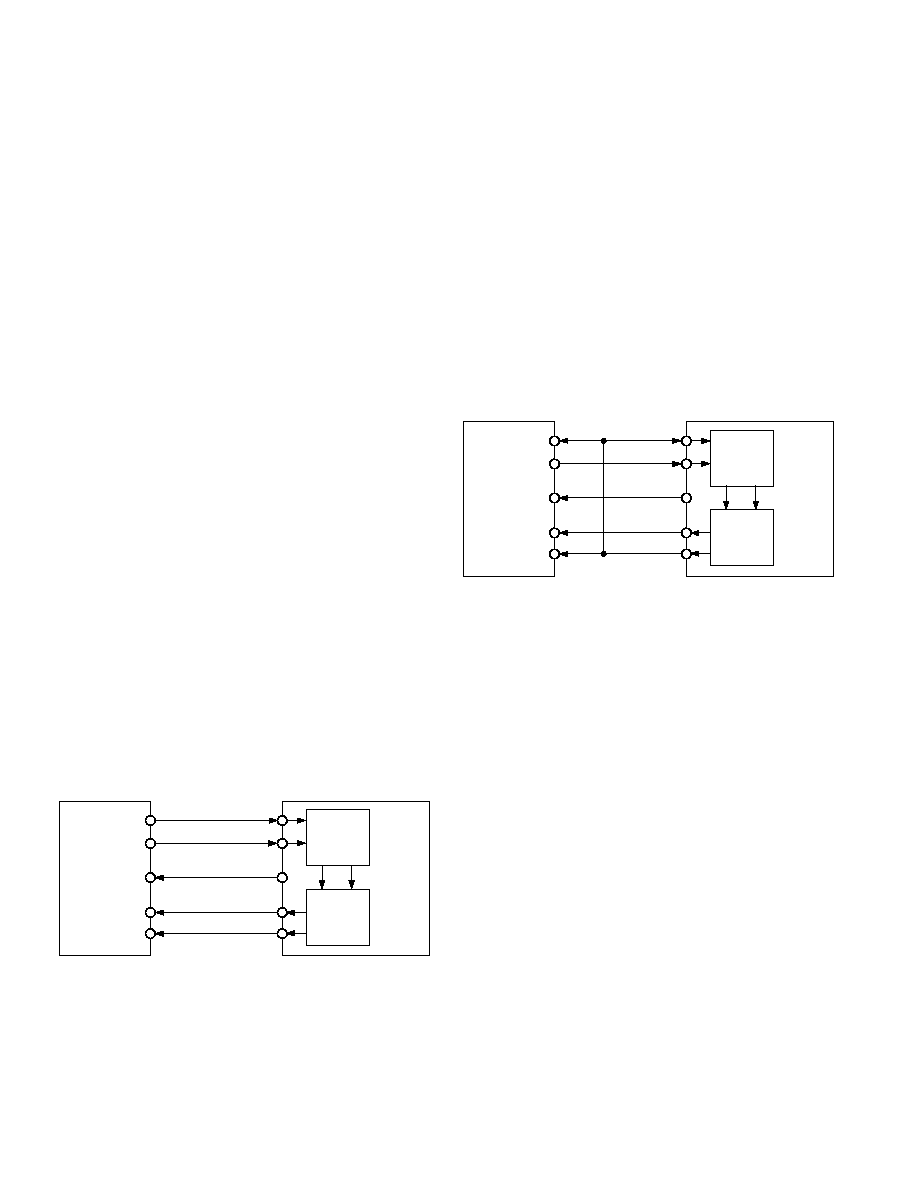
AD73322
26
REV. B
INTERFACING
The AD73322 can be interfaced to most modern DSP engines
using conventional serial port connections and an extra enable
control line. Both serial input and output data use an accompa-
nying frame synchronization signal that is active high one clock
cycle before the start of the 16-bit word or during the last bit of
the previous word if transmission is continuous. The serial clock
(SCLK) is an output from the codec and is used to define the
serial transfer rate to the DSP's Tx and Rx ports. Two primary
configurations can be used: the first is shown in Figure 18 where
the DSP's Tx data, Tx frame sync, Rx data and Rx frame sync
are connected to the codec's SDI, SDIFS, SDO and SDOFS
respectively. This configuration, referred to as indirectly coupled or
nonframe sync loop-back, has the effect of decoupling the trans-
mission of input data from the receipt of output data. The delay
between receipt of codec output data and transmission of input
data for the codec is determined by the DSP's software latency.
When programming the DSP serial port for this configuration, it
is necessary to set the Rx FS as an input and the Tx FS as an
output generated by the DSP. This configuration is most useful
when operating in mixed mode, as the DSP has the ability to
decide how many words (either DAC or control) can be sent to
the codecs. This means that full control can be implemented
over the device configuration as well as updating the DAC in a
given sample interval. The second configuration (shown in
Figure 19) has the DSP's Tx data and Rx data connected to the
codec's SDI and SDO, respectively, while the DSP's Tx and Rx
frame syncs are connected to the codec's SDIFS and SDOFS.
In this configuration, referred to as directly coupled or frame
sync loop-back, the frame sync signals are connected together
and the input data to the codec is forced to be synchronous with
the output data from the codec. The DSP must be programmed
so that both the Tx FS and Rx FS are inputs as the codec
SDOFS will be input to both. This configuration guarantees
that input and output events occur simultaneously and is the
simplest configuration for operation in normal Data Mode.
Note that when programming the DSP in this configuration it is
advisable to preload the Tx register with the first control word
to be sent before the codec is taken out of reset. This ensures
that this word will be transmitted to coincide with the first out-
put word from the device(s).
TFS
DT
SCLK
DR
RFS
ADSP-21xx
DSP
AD73322
CODEC
CODEC1
CODEC2
SDIFS
SDI
SCLK
SDO
SDOFS
Figure 18. Indirectly Coupled or Nonframe Sync Loop-
Back Configuration
Cascade Operation
The AD73322 has been designed to support cascading of
codecs from a single DSP serial port (see Figure 31). Cascaded
operation can support mixes of dual or single channel devices
with the maximum number of codec units being eight (the
AD73322 is equivalent to two codec units). The SPORT inter-
face protocol has been designed so that device addressing is
built into the packet of information sent to the device. This
allows the cascade to be formed with no extra hardware over-
head for control signals or addressing. A cascade can be formed
in either of the two modes previously discussed.
There may be some restrictions in cascade operation due to the
number of devices configured in the cascade and the sampling
rate and serial clock rate chosen. The following relationship
details the restrictions in configuring a codec cascade.
Number of Codecs
×
Word Size (16)
×
Sampling Rate <= Serial
Clock Rate
TFS
DT
SCLK
DR
RFS
ADSP-21xx
DSP
AD73322
CODEC
CODEC1
CODEC2
SDIFS
SDI
SCLK
SDO
SDOFS
Figure 19. Directly Coupled or Frame Sync Loop-
Back Configuration
When using the indirectly coupled frame sync configuration in
cascaded operation, it is necessary to be aware of the restrictions
in sending data to all devices in the cascade. Effectively the time
allowed is given by the sampling interval (M/DMCLK--where
M can be one of 256, 512, 1024 or 2048), which is 125
µ
s for a
sample rate of 8 kHz. In this interval, the DSP must transfer
N
×
16 bits of information where N is the number of devices in
the cascade. Each bit will take 1/SCLK and, allowing for any
latency between the receipt of the Rx interrupt and the trans-
mission of the Tx data, the relationship for successful operation
is given by:
M/DMCLK > ((N
×
16/SCLK) + T
INTERRUPT LATENCY
)
The interrupt latency will include the time between the ADC
sampling event and the Rx interrupt being generated in the
DSP--this should be 16 SCLK cycles.
As the AD73322 is configured in cascade mode, each device
must know the number of devices in the cascade because the
data and mixed modes use a method of counting input frame
sync pulses to decide when they should update the DAC register
from the serial input register. Control Register A contains a 3-bit
field (DC0-2) that is programmed by the DSP during the pro-
gramming phase. The default condition is that the field contains
000b, which is equivalent to a single device in cascade (see
Table XXII). However, for cascade operation this field must
contain a binary value that is one less than the number of de-
vices in the cascade, which is 001b for a single AD73322 device
configuration.
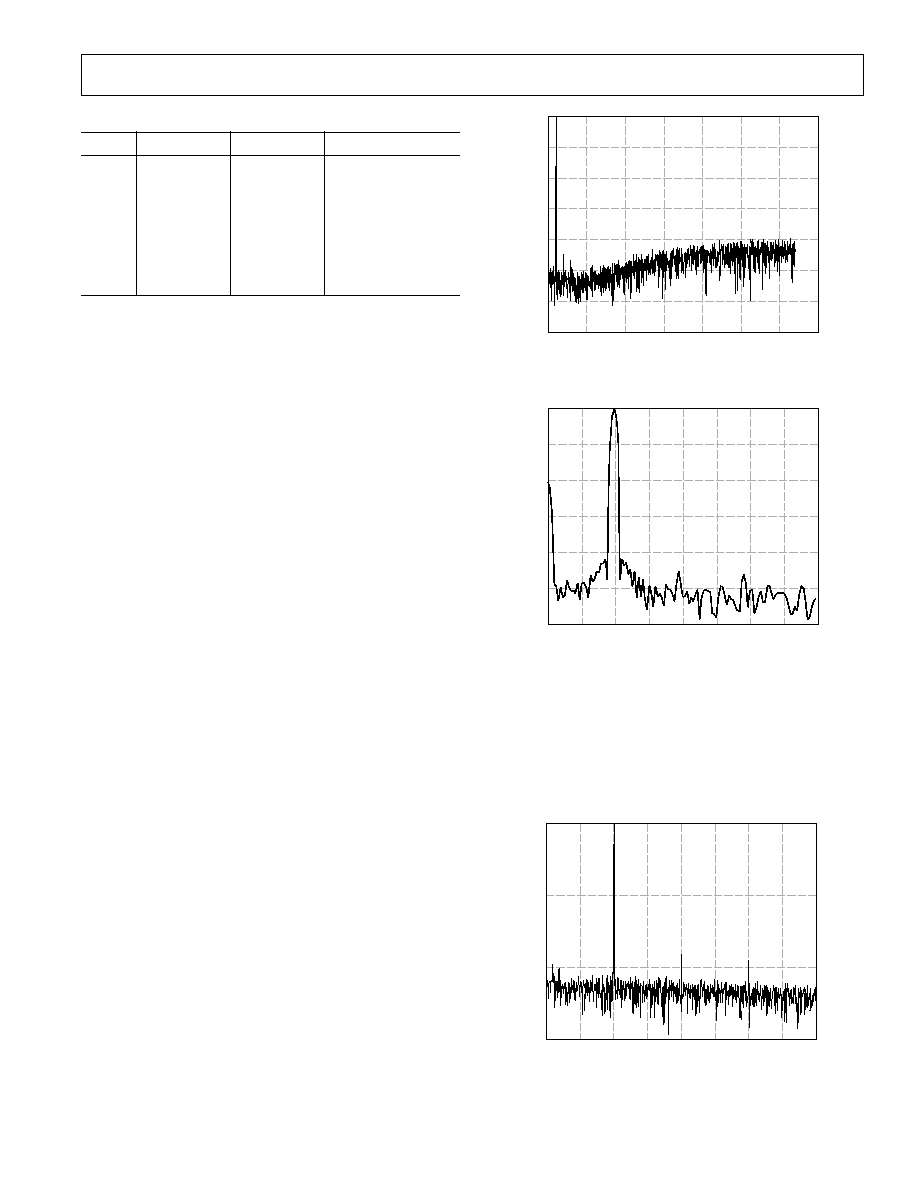
AD73322
27
REV. B
Table XXII. Device Count Settings
DC2
DC1
DC0
Cascade Length
0
0
0
1
0
0
1
2
0
1
0
3
0
1
1
4
1
0
0
5
1
0
1
6
1
1
0
7
1
1
1
8
PERFORMANCE
As the AD73322 is designed to provide high performance, low
cost conversion, it is important to understand the means by
which this high performance can be achieved in a typical appli-
cation. This section will, by means of spectral graphs, outline
the typical performance of the device and highlight some of the
options available to users in achieving their desired sample rate,
either directly in the device or by doing some post-processing in
the DSP, while also showing the advantages and disadvantages
of the different approaches.
Encoder Section
The AD73322 offers a variable sampling rate from a fixed
MCLK frequency--with 64 kHz, 32 kHz, 16 kHz and 8 kHz
being available with a 16.384 MHz external clock. Each of these
sampling rates preserves the same sampling rate in the ADC's
sigma-delta modulator, which ensures that the noise perfor-
mance is optimized in each case. The examples below will show
the performance of a 1 kHz sine wave when converted at the
various sample rates.
The range of sampling rates is aimed to offer the user a degree
of flexibility in deciding how their analog front end is to be
implemented. The high sample rates of 64 kHz and 32 kHz are
suited to those applications, such as active control, where low
conversion group delay is essential. On the other hand, the
lower sample rates of 16 kHz and 8 kHz are better suited for
applications such as telephony, where the lower sample rates
result in lower DSP overhead.
Figure 20 shows the spectrum of the 1 kHz test tone sampled at
64 kHz. The plot shows the characteristic shaped noise floor of
a sigma-delta converter, which is initially flat in the band of
interest but then rises with increasing frequency. If a suitable
digital filter is applied to this spectrum, it is possible to eliminate
the noise floor in the higher frequencies. This signal can then be
used in DSP algorithms or can be further processed in a deci-
mation algorithm to reduce the effective sample rate. Figure 21
shows the resulting spectrum following the filtering and decima-
tion of the spectrum of Figure 20 from 64 kHz to an 8 kHz rate.
FREQUENCY
Hz
0
0.5
0
dB
20
1.0
1.5
2.0
2.5
3.0
3.5
100
140
120
40
60
80
10
4
Figure 20. FFT (ADC 64 kHz Sampling)
FREQUENCY Hz
0
500
0
20
dB
40
60
80
100
120
1000
1500
2000
2500
3000
3500
4000
Figure 21. FFT (ADC 8 kHz Filtered and Decimated from
64 kHz)
The AD73322 also features direct sampling at the lower rate of
8 kHz. This is achieved by the use of extended decimation regis-
ters within the decimator block, which allows for the increased
word growth associated with the higher effective oversampling
ratio. Figure 22 details the spectrum of a 1 kHz test tone con-
verted at an 8 kHz rate.
FREQUENCY Hz
0
500
0
dB
50
100
1000
1500
2000
2500
3000
3500
4000
150
Figure 22. FFT (ADC 8 kHz Direct Sampling)
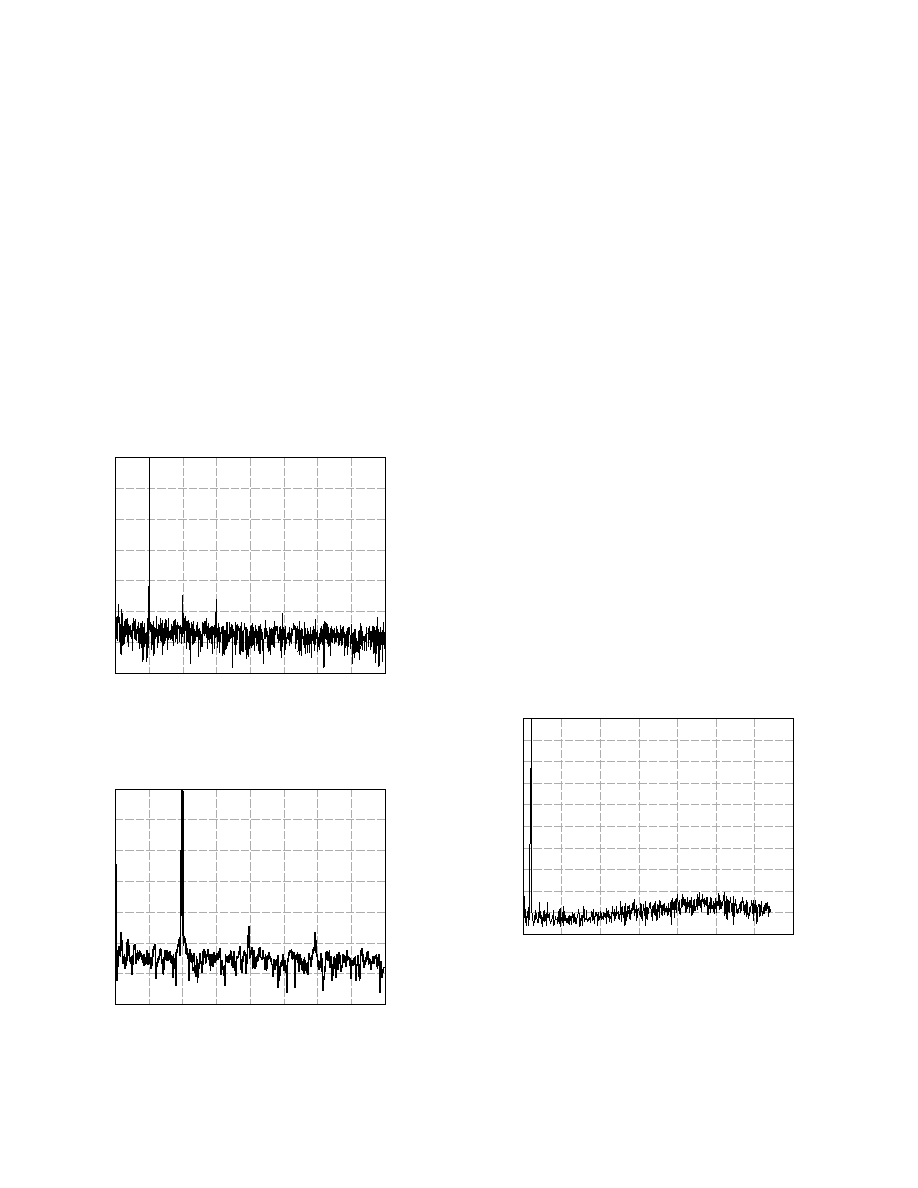
AD73322
28
REV. B
The device features an on-chip master clock divider circuit that
allows the sample rate to be reduced as the sampling rate of the
sigma-delta converter is proportional to the output of the MCLK
Divider (whose default state is divide by 1).
The decimator's frequency response (Sinc3) gives some pass-
band attenuation (up to F
S
/2) which continues to roll off above
the Nyquist frequency. If it is required to implement a digital
filter to create a sharper cutoff characteristic, it may be prudent
to use an initial sample rate of greater than twice the Nyquist
rate in order to avoid aliasing due to the smooth roll-off of the
Sinc3 filter response.
In the case of voiceband processing where 4 kHz represents the
Nyquist frequency, if the signal to be measured were externally
bandlimited then an 8 kHz sampling rate would suffice. How-
ever if it is required to limit the bandwidth using a digital filter,
then it may be more appropriate to use an initial sampling rate
of 16 kHz and to process this sample stream with a filtering and
decimating algorithm to achieve a 4 kHz bandlimited signal at
an 8 kHz rate. Figure 23 details the initial 16 kHz sampled tone.
FREQUENCY Hz
0
1000
0
20
dB
40
60
80
100
120
2000
3000
4000
5000
6000
7000
8000
140
Figure 23. FFT (ADC 16 kHz Direct Sampling)
Figure 24 details the spectrum of the final 8 kHz sampled fil-
tered tone.
FREQUENCY Hz
0
500
0
20
dB
40
60
80
100
120
1000
1500
2000
2500
3000
3500
4000
140
Figure 24. FFT (ADC 8 kHz Filtered and Decimated from
16 kHz)
Encoder Group Delay
When programmed for high sampling rates, the AD73322 offers
a very low level of group delay, which is given by the following
relationship:
Group Delay (Decimator) = Order
×
((M 1)/2)
×
T
DEC
where:
Order is the order of the decimator (= 3),
M is the decimation factor (= 32 @ 64 kHz, = 64 @ 32 kHz,
= 128 @ 16 kHz , = 256 @ 8 kHz) and
T
DEC
is the decimation sample interval (= 1/2.048e6) (based
on DMCLK = 16.384 MHz) => Group Delay (Decimator @
64 kHz) = 3
×
(32 1)/2
×
(1/2.048e6) = 22.7
µ
s
If final filtering is implemented in the DSP, the final filter's
group delay must be taken into account when calculating overall
group delay.
Decoder Section
The decoder section updates (samples) at the same rate as the
encoder section. This rate is programmable as 64 kHz, 32 kHz,
16 kHz or 8 kHz (from a 16.384 MHz MCLK). The decoder
section represents a reverse of the process that was described in
the encoder section. In the case of the decoder section, signals
are applied in the form of samples at an initial low rate. This
sample rate is then increased to the final digital sigma-delta
modulator rate of DMCLK/8 by interpolating new samples
between the original samples. The interpolating filter also has the
action of canceling images due to the interpolation process using
spectral nulls that exist at integer multiples of the initial sam-
pling rate. Figure 25 shows the spectral response of the decoder
section sampling at 64 kHz. Again, its sigma-delta modulator
shapes the noise so it is reduced in the voice bandwidth dc
4 kHz. For improved voiceband SNR, the user can implement
an initial anti-imaging filter, preceded by 8 kHz to 64 kHz inter-
polation, in the DSP.
FREQUENCY
Hz
0
0.5
0
dB
20
1.0
1.5
2.0
2.5
3.0
3.5
100
10
30
40
50
60
70
80
90
10
4
Figure 25. FFT (DAC 64 kHz Sampling)
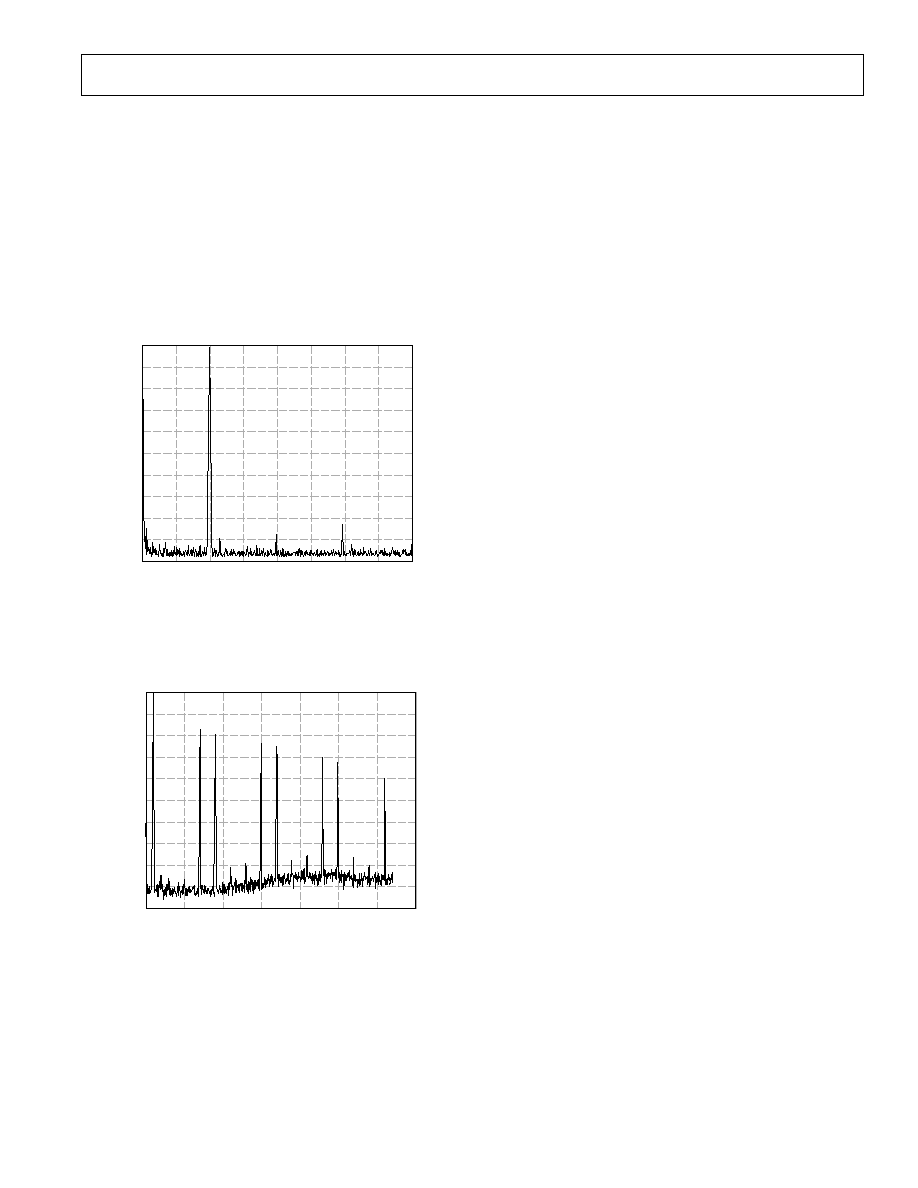
AD73322
29
REV. B
As the AD73322 can be operated at 8 kHz (see Figure 26) or
16 kHz sampling rates, which make it particularly suited for
voiceband processing, it is important to understand the action of
the interpolator's Sinc3 response. As was the case with the en-
coder section, if the output signal's frequency response is not
bounded by the Nyquist frequency it may be necessary to perform
some initial digital filtering to eliminate signal energy above
Nyquist to ensure that it is not imaged at the integer multiples
of the sampling frequency. If the user chooses to bypass the
interpolator, perhaps to reduce group delay, images of the origi-
nal signal will be generated at integer intervals of the sampling
frequency. In this case these images must be removed by exter-
nal analog filtering.
FREQUENCY Hz
0
500
0
10
dB
20
30
40
50
60
1000
1500
2000
2500
3000
3500
4000
70
80
90
100
Figure 26. FFT (DAC 8 kHz Sampling)
Figure 27 shows the output spectrum of a 1 kHz tone being
generated at an 8 kHz sampling rate with the interpolator
bypassed.
FREQUENCY
Hz
0
0.5
0
dB
20
1.0
1.5
2.0
2.5
3.0
3.5
100
10
30
40
50
60
70
80
90
10
4
Figure 27. FFT (DAC 8 kHz Sampling--Interpolator
Bypassed)
Decoder Group Delay
The interpolator roll-off is mainly due to its sinc-cubed function
characteristic, which has an inherent group delay given by the
equation:
Group Delay (Interpolator) = Order
×
(L 1)/2)
×
T
INT
where:
Order is the interpolator order (= 3),
L is the interpolation factor (= 32 @ 64 kHz, = 64 @ 32 kHz,
= 128 @ 16 kHz, = 256 @ 8 kHz) and
T
INT
is the interpolation sample interval (= 1/2.048e6)
=> Group Delay (Interpolator @ 64 kHz)
= 3
×
(32 1)/2
×
(1/2.048e6)
= 22.7
µ
s
The analog section has a group delay of approximately 25
µ
s.
On-Chip Filtering
The primary function of the system filtering's sinc-cubed (Sinc3)
response is to eliminate aliases or images of the ADCs or DAC's
resampling, respectively. Both modulators are sampled at a
nominal rate of DMCLK/8 (which is 2.048 MHz for a DMCLK
of 16.384 MHz) and the simple, external RC antialias filter is
sufficient to provide the required stopband rejection above the
Nyquist frequency for this sample rate. In the case of the ADC
section, the decimating filter is required to both decrease sample
rate and increase sample resolution. The process of changing
sample rate (resampling) leads to aliases of the original sampled
waveform appearing at integer multiples of the new sample rate.
These aliases would get mapped into the required signal pass-
band without the application of some further antialias filtering.
In the AD73322, the sinc-cubed response of the decimating
filter creates spectral nulls at integer multiples of the new sample
rate. These nulls coincide with the aliases of the original wave-
form which were created by the down-sampling process, there-
fore reducing or eliminating the aliasing due to sample rate
reduction.
In the DAC section, increasing the sampling rate by interpola-
tion creates images of the original waveform at intervals of the
original sampling frequency. These images may be sufficiently
rejected by external circuitry but the sinc-cubed filter in the
interpolator again nulls the output spectrum at integer intervals
of the original sampling rate which corresponds with the images
due to the interpolation process.
The spectral response of a sinc-cubed filter shows the character-
istic nulls at integer intervals of the sampling frequency. Its
passband characteristic (up to Nyquist frequency) features a
roll-off that continues up to the sampling frequency, where the
first null occurs. In many applications this smooth response will
not give sufficient attenuation of frequencies outside the band of
interest therefore it may be necessary to implement a final filter
in the DSP which will equalize the passband rolloff and provide
a sharper transition band and greater stopband attenuation.
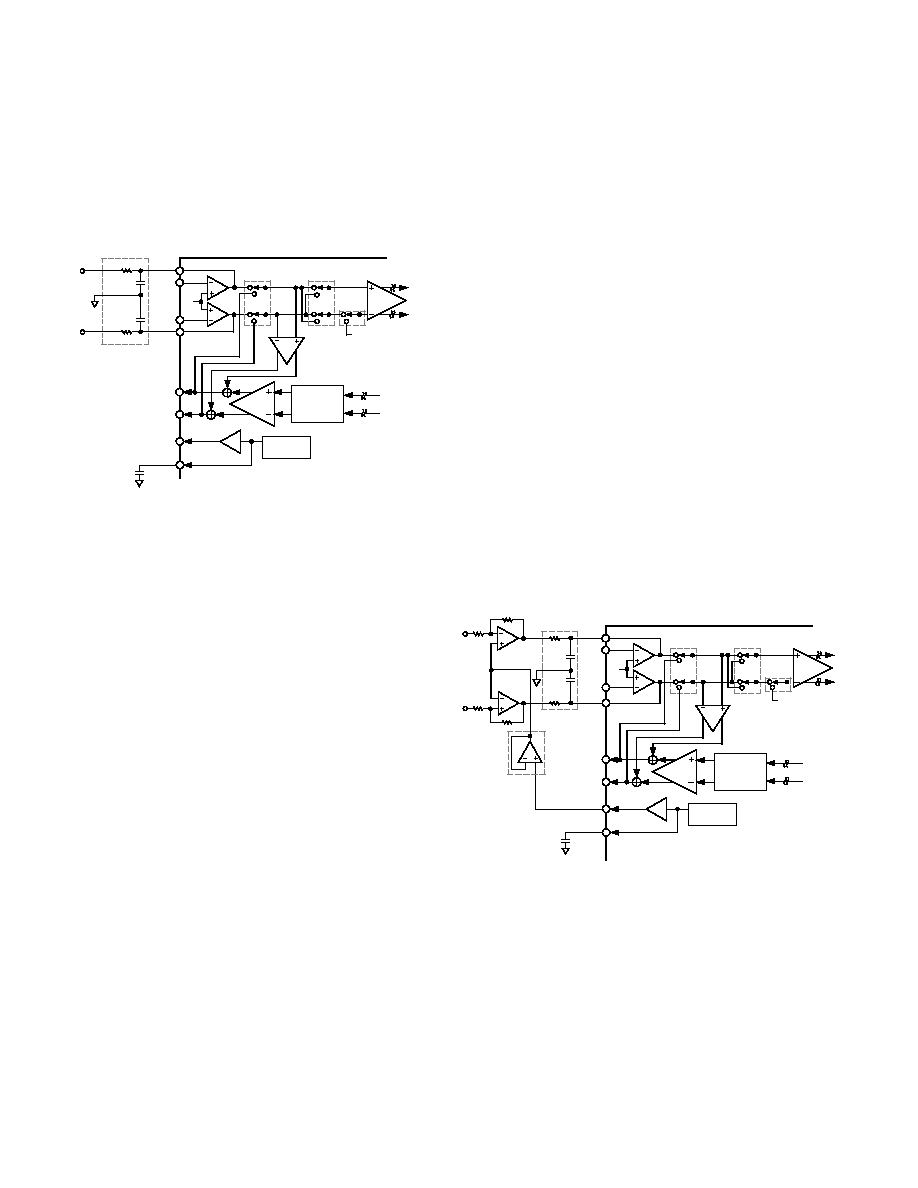
AD73322
30
REV. B
DESIGN CONSIDERATIONS
The AD73322 features both differential inputs and outputs on
each channel to provide optimal performance and avoid com-
mon mode noise. It is also possible to interface either inputs or
outputs in single-ended mode. This section details the choice of
input and output configurations and also gives some tips to-
wards successful configuration of the analog interface sections.
VFBN1
GAIN
1
+6/15dB
PGA
CONTINUOUS
TIME
LOW-PASS
FILTER
V
REF
VINN1
VINP1
VFBP1
VOUTP1
VOUTN1
REFOUT
REFERENCE
AD73322
V
REF
ANTI-ALIAS
FILTER
0.047 F
100
0.047 F
100
REFCAP
0.1 F
0/38dB
PGA
Figure 28. Analog Input (DC-Coupled)
Analog Inputs
There are several different ways in which the analog input (en-
coder) section of the AD73322 can be interfaced to external
circuitry. It provides optional input amplifiers which allows
sources with high source impedance to drive the ADC section
correctly. When the input amplifiers are enabled, the input
channel is configured as a differential pair of inverting amplifiers
referenced to the internal reference (REFCAP) level. The in-
verting terminals of the input amplifier pair are designated as
pins VINP1 and VINN1 for Channel 1 (VINP2 and VINN2 for
Channel 2) and the amplifier feedback connections are available
on pins VFBP1 and VFBN1 for Channel 1 (VFBP2 and VFBN2
for Channel 2).
For applications where external signal buffering is required,
the input amplifiers can be bypassed and the ADC driven
directly. When the input amplifiers are disabled, the sigma-
delta modulator's input section (SC PGA) is accessed di-
rectly through the VFBP1 and VFBN1 pins for Channel 1
(VFBP2 and VFBN2 for Channel 2).
It is also possible to drive the ADCs in either differential or
single-ended modes. If the single-ended mode is chosen it is
possible using software control to multiplex between two single-
ended inputs connected to the positive and negative input pins.
The primary concerns in interfacing to the ADC are firstly to
provide adequate anti-alias filtering and to ensure that the signal
source will drive the switched-capacitor input of the ADC
correctly. The sigma-delta design of the ADC and its over sam-
pling characteristics simplify the antialias requirements but it
must be remembered that the single pole RC filter is primarily
intended to eliminate aliasing of frequencies above the Nyquist
frequency of the sigma-delta modulator's sampling rate (typi-
cally 2.048 MHz). It may still require a more specific digital
filter implementation in the DSP to provide the final signal
frequency response characteristics. It is recommended that for
optimum performance that the capacitors used for the antialias-
ing filter be of high quality dielectric (NPO). The second issue
mentioned above is interfacing the signal source to the ADC's
switched capacitor input load. The SC input presents a complex
dynamic load to a signal source, therefore, it is important to
understand that the slew rate characteristic is an important
consideration when choosing external buffers for use with the
AD73322. The internal inverting op amps on the AD73322 are
specifically designed to interface to the ADC's SC input stage.
The AD73322's on-chip 38 dB preamplifier can be enabled
when there is not enough gain in the input circuit; the preampli-
fier is configured by bits IGS0-2 of CRD. The total gain must
be configured to ensure that a full-scale input signal produces a
signal level at the input to the sigma-delta modulator of the
ADC that does not exceed the maximum input range.
The dc biasing of the analog input signal is accomplished with
an on-chip voltage reference. If the input signal is not biased at
the internal reference level (via REFOUT), then it must be
ac-coupled with external coupling capacitors. C
IN
should be
0.1
µ
F or larger. The dc biasing of the input can then be accom-
plished using resistors to REFOUT as in Figures 31 and 32.
VFBN1
GAIN
1
V
REF
VINN1
VINP1
VFBP1
VOUTP1
VOUTN1
REFCAP
REFOUT
REFERENCE
0/38dB
PGA
AD73322
V
REF
OPTIONAL
BUFFER
ANTI-ALIAS
FILTER
0.1 F
100
100
0.047
F
0.047
F
+6/15dB
PGA
CONTINUOUS
TIME
LOW-PASS
FILTER
Figure 29. Analog Input (DC-Coupled) Using External
Amplifiers
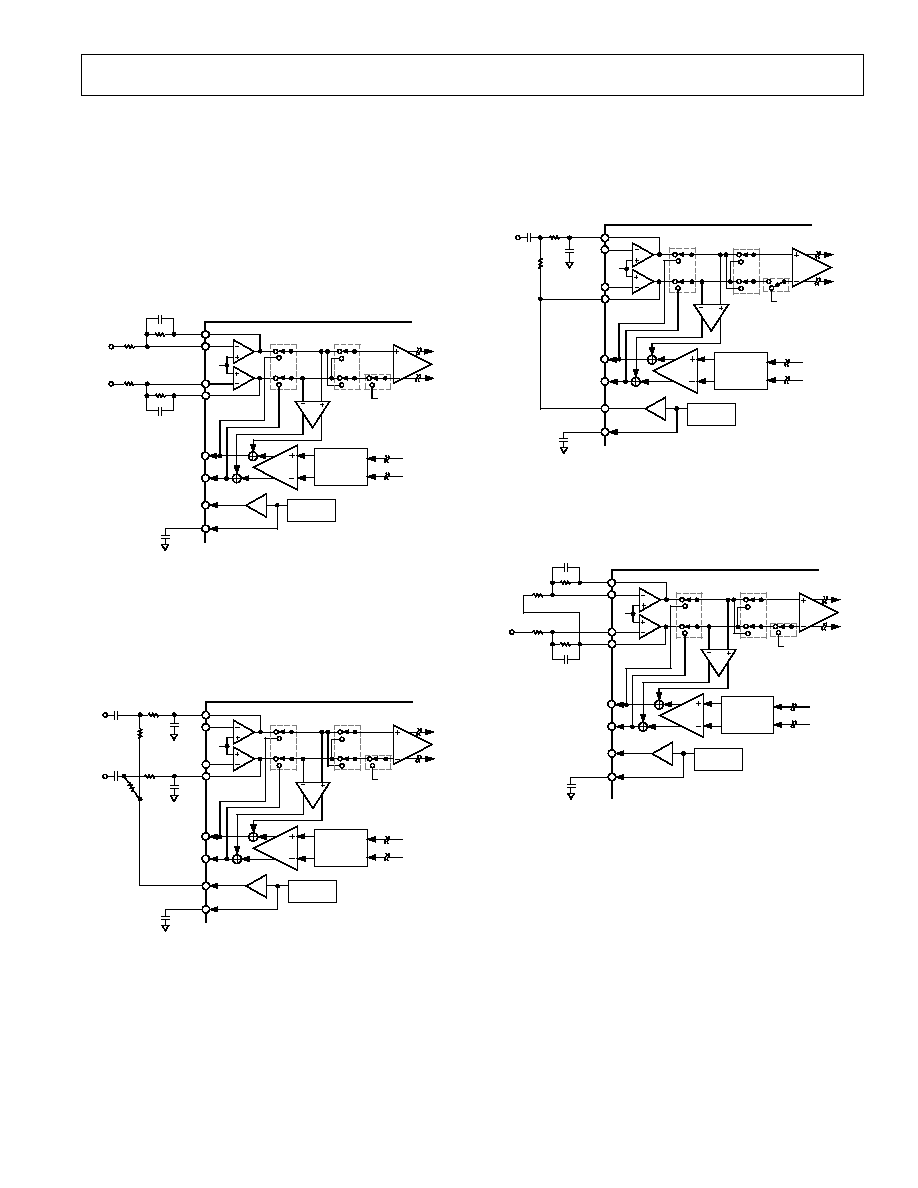
AD73322
31
REV. B
The AD73322's ADC inputs are biased about the internal refer-
ence level (REFCAP level), therefore it may be necessary to
bias external signals to this level using the buffered REFOUT
level as the reference. This is applicable in either dc- or ac-
coupled configurations. In the case of dc coupling, the signal
(biased to REFOUT) may be applied directly to the inputs
(using amplifier bypass), as shown in Figure 28, or it may be
conditioned in an external op amp where it can also be biased
to the reference level using the buffered REFOUT signal as
shown in Figure 29 or it is possible to connect inputs directly
to the AD73322's input op amps as shown in Figure 30.
VFBN1
GAIN
1
V
REF
VINN1
VINP1
VFBP1
VOUTP1
VOUTN1
REFOUT
REFERENCE
AD73322
V
REF
50k
100pF
50k
100pF
50k
50k
REFCAP
0.1 F
0/38dB
PGA
+6/15dB
PGA
CONTINUOUS
TIME
LOW-PASS
FILTER
Figure 30. Analog Input (DC-Coupled) Using Internal
Amplifiers
In the case of ac coupling, a capacitor is used to couple the
signal to the input of the ADC. The ADC input must be biased
to the internal reference (REFCAP) level which is done by
connecting the input to the REFOUT pin through a 10 k
resistor as shown in Figure 31.
VFBN1
GAIN
1
V
REF
VINN1
VINP1
VFBP1
VOUTP1
VOUTN1
REFOUT
REFERENCE
AD73322
V
REF
100
100
0.1 F
REFCAP
0.1 F
0/38dB
PGA
0.047
F
0.047
F
10k
0.1 F
10k
+6/15dB
PGA
CONTINUOUS
TIME
LOW-PASS
FILTER
Figure 31. Analog Input (AC-Coupled) Differential
If the ADC is being connected in single-ended mode, the
AD73322 should be programmed for single-ended mode using
the SEEN and INV bits of CRF and the inputs connected as
shown in Figure 32. When operated in single-ended input
mode, the AD73322 can multiplex one of the two inputs to the
ADC input.
VFBN1
GAIN
1
V
REF
VINN1
VINP1
VFBP1
VOUTP1
VOUTN1
REFOUT
REFERENCE
0/38dB
PGA
AD73322
V
REF
0.047
F
100
10k
0.1 F
REFCAP
0.1 F
+6/15dB
PGA
CONTINUOUS
TIME
LOW-PASS
FILTER
Figure 32. Analog Input (AC-Coupled) Single-Ended
If best performance is required from a single-ended source, it
is possible to configure the AD73322's input amplifiers as a
single-ended to differential converter as shown in Figure 33.
VFBN1
GAIN
1
V
REF
VINN1
VINP1
VFBP1
VOUTP1
VOUTN1
REFOUT
REFERENCE
0/38dB
PGA
AD73322
50k
100pF
50k
100pF
50k
50k
REFCAP
0.1 F
V
REF
+6/15dB
PGA
CONTINUOUS
TIME
LOW-PASS
FILTER
Figure 33. Single-Ended to Differential Conversion On
Analog Input
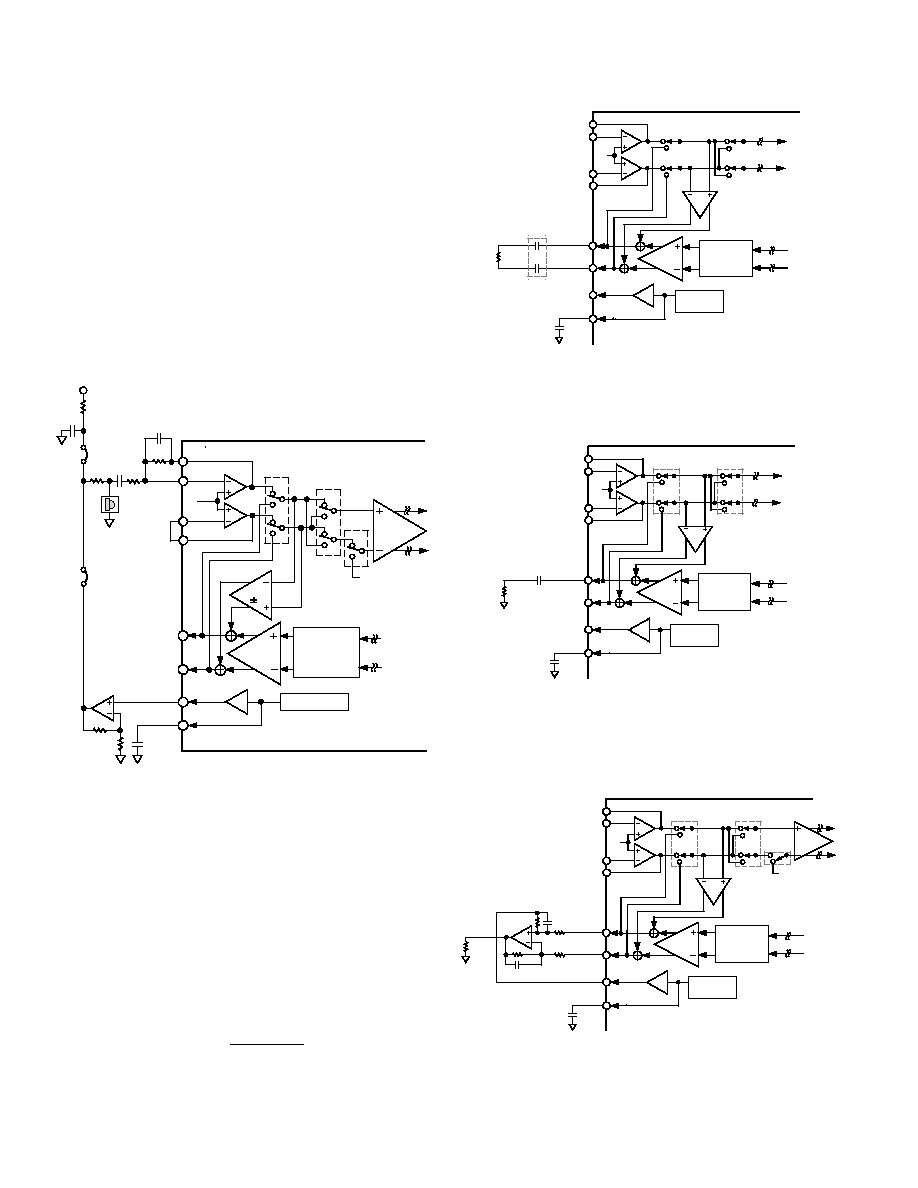
AD73322
32
REV. B
Interfacing to an Electret Microphone
Figure 34 details an interface for an electret microphone which
may be used in some voice applications. Electret microphones
typically feature a FET amplifier whose output is accessed on
the same lead which supplies power to the microphone, there-
fore this output signal must be capacitively coupled to remove
the power supply (dc) component. In this circuit the AD73322
input channel is being used in single-ended mode where the
internal inverting amplifier provides suitable gain to scale the
input signal relative to the ADC's full-scale input range. The
buffered internal reference level at REFOUT is used via an
external buffer to provide power to the electret microphone.
This provides a quiet, stable supply for the microphone. If this
is not a concern, then the microphone can be powered from the
system power supply.
CONTINUOUS
TIME
LOW-PASS
FILTER
V
REF
VFBN1
VINN1
VINP1
VFBP1
VOUTP1
VOUTN1
REFCAP
REFOUT
AD73322
V
REF
+6/15dB
PGA
REFERENCE
0/38dB
PGA
GAIN
1
C1
R2
R1
C2
R
B
R
A
+5V
ELECTRET
PROBE
10 F
C
REFCAP
Figure 34. Electret Microphone Interface Circuit
Analog Output
The AD73322's differential analog output (VOUT) is produced
by an on-chip differential amplifier. The differential output can
be ac-coupled or dc-coupled directly to a load which can be a
headset or the input of an external amplifier (the specified mini-
mum resistive load on the output section is 150
.) It is possible
to connect the outputs in either a differential or a single-ended
configuration but please note that the effective maximum output
voltage swing (peak to peak) is halved in the case of single-
ended connection. Figure 35 shows a simple circuit providing a
differential output with ac coupling. The capacitors in this cir-
cuit (C
OUT
) are optional; if used, their value can be chosen as
follows:
C
f R
OUT
C
LOAD
=
1
2
where f
C
= desired cutoff frequency.
VFBN1
GAIN
1
V
REF
VINN1
VINP1
VFBP1
VOUTP1
VOUTN1
REFCAP
REFOUT
REFERENCE
AD73322
C
REFCAP
R
LOAD
C
OUT
C
OUT
+6/15dB
PGA
CONTINUOUS
TIME
LOW-PASS
FILTER
Figure 35. Example Circuit for Differential Output
Figure 36 shows an example circuit for providing a single-ended
output with ac coupling. The capacitor of this circuit (C
OUT
) is
not optional if dc current drain is to be avoided.
VFBN1
GAIN
1
V
REF
VINN1
VINP1
VFBP1
VOUTP1
VOUTN1
REFCAP
REFOUT
REFERENCE
AD73322
R
LOAD
C
OUT
0.1 F
+6/15dB
PGA
CONTINUOUS
TIME
LOW-PASS
FILTER
Figure 36. Example Circuit for Single-Ended Output
Differential to Single-Ended Output
In some applications it may be desireable to convert the full
differential output of the decoder channel to a single-ended
signal. The circuit of Figure 37 shows a scheme for doing this.
VFBN1
GAIN
1
V
REF
VINN1
VINP1
VFBP1
VOUTP1
VOUTN1
REFCAP
REFOUT
REFERENCE
AD73322
V
REF
0/38dB
PGA
R
LOAD
R
I
R
I
R
F
R
F
0.1 F
+6/15dB
PGA
CONTINUOUS
TIME
LOW-PASS
FILTER
Figure 37. Example Circuit for Differential to Single-
Ended Output Conversion
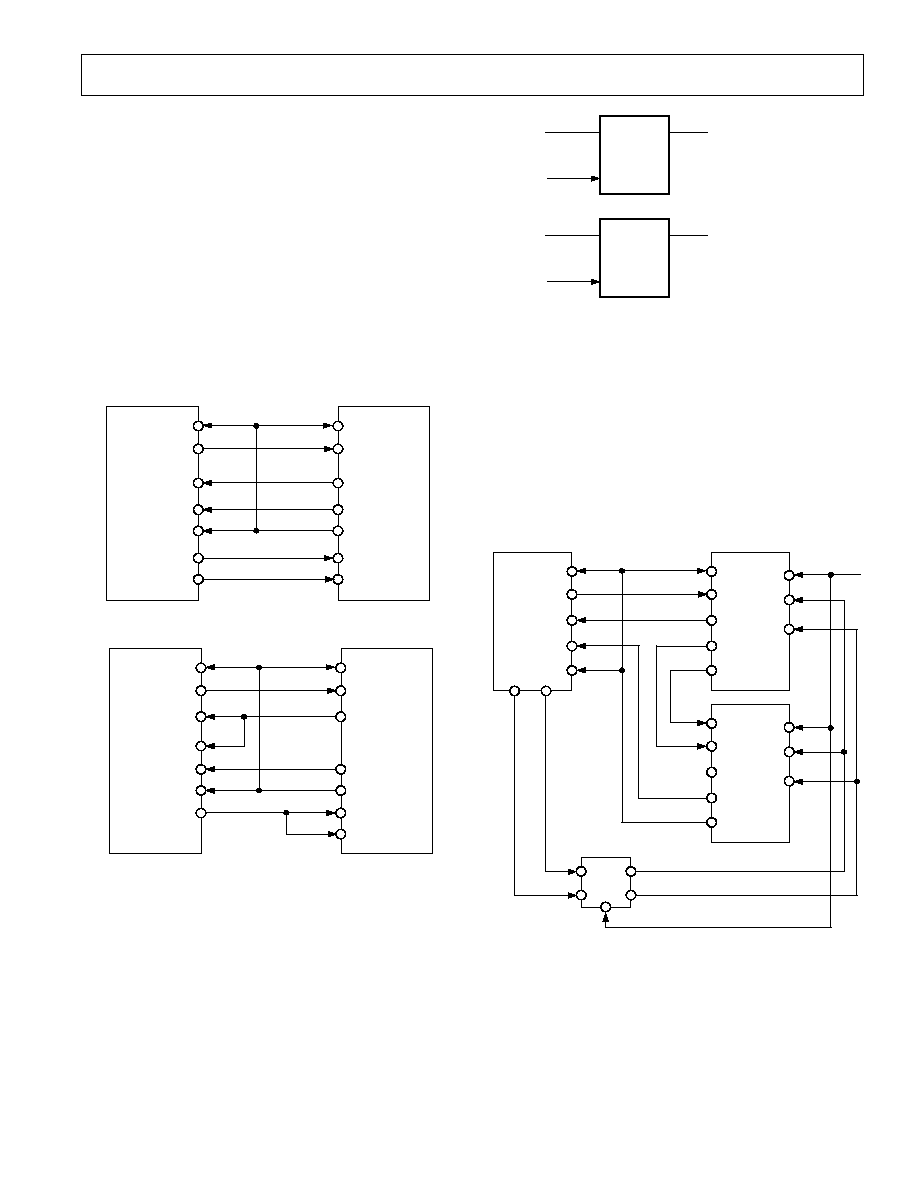
AD73322
33
REV. B
Digital Interfacing
The AD73322 is designed to easily interface to most common
DSPs. The SCLK, SDO, SDOFS, SDI and SDIFS must be
connected to the DSP's Serial Clock, Receive Data, Receive
Data Frame Sync, Transmit Data and Transmit Data Frame
Sync pins respectively. The SE pin may be controlled from a
parallel output pin or flag pin such as FL0-2 on the ADSP-21xx
(or XF on the TMS320C5x) or, where SPORT powerdown is
not required, it can be permanently strapped high using a suit-
able pull-up resistor. The RESET pin may be connected to the
system hardware reset structure or it may also be controlled
using a dedicated control line. In the event of tying it to the
global system reset, it is advisable to operate the device in mixed
mode, which allows a software reset, otherwise there is no
convenient way of resetting the device. Figures 38 and 39
show typical connections to an ADSP-218x and TMS320C5x
respectively.
TFS
DT
SCLK
DR
RFS
ADSP-218x
DSP
AD73322
CODEC
SDIFS
SDI
SCLK
SDO
SDOFS
FL0
FL1
RESET
SE
Figure 38. AD73322 Connected to ADSP-218x
FSX
DT
CLKX
DR
FSR
TMS320C5x
DSP
AD73322
CODEC
SDIFS
SDI
SCLK
SDO
SDOFS
XF
RESET
SE
CLKR
Figure 39. AD73322 Connected to TMS320C5x
Cascade Operation
Where it is required to configure a cascade of up to eight codecs
(4 AD73322 dual codecs), it is necessary to ensure that the
timing of the SE and RESET signals is synchronized at each
device in the cascade. A simple D type flip flop is sufficient to
sync each signal to the master clock MCLK, as in Figure 40.
1/2
74HC74
CLK
D
Q
DSP CONTROL
TO SE
MCLK
SE SIGNAL SYNCHRONIZED
TO MCLK
1/2
74HC74
CLK
D
Q
DSP CONTROL
TO
RESET
MCLK
RESET
SIGNAL SYNCHRONIZED
TO MCLK
Figure 40. SE and RESET Sync Circuit for Cascaded
Operation
Connection of a cascade of devices to a DSP, as shown in Fig-
ure 41, is no more complicated than connecting a single device.
Instead of connecting the SDO and SDOFS to the DSP's Rx
port, these are now daisy-chained to the SDI and SDIFS of the
next device in the cascade. The SDO and SDOFS of the final
device in the cascade are connected to the DSP's Rx port to
complete the cascade. SE and RESET on all devices are fed
from the signals that were synchronized with the MCLK using
the circuit as described above. The SCLK from only one device
need be connected to the DSP's SCLK input(s) as all devices
will be running at the same SCLK frequency and phase.
TFS
DT
DR
RFS
AD73322
CODEC
SDIFS
SDI
SCLK
SDO
SDOFS
SCLK
DEVICE 1
MCLK
SE
RESET
AD73322
CODEC
SDIFS
SDI
SCLK
SDO
SDOFS
DEVICE 2
MCLK
SE
RESET
74HC74
Q1
Q2
D1
D2
FL0
FL1
ADSP-218x
DSP
Figure 41. Connection of Two AD73322s Cascaded to
ADSP-218x
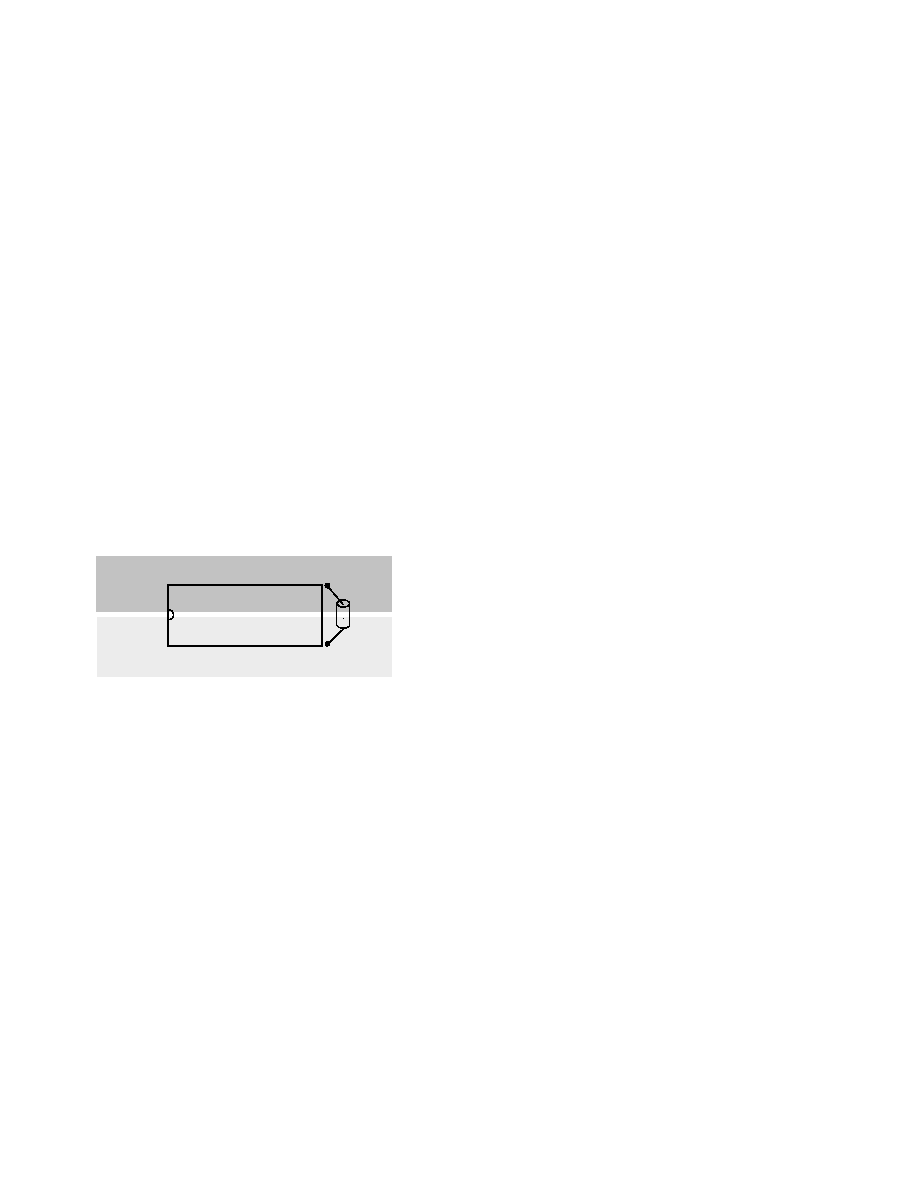
AD73322
34
REV. B
Grounding and Layout
Since the analog inputs to the AD73322 are differential, most of
the voltages in the analog modulator are common-mode volt-
ages. The excellent common-mode rejection of the part will
remove common-mode noise on these inputs. The analog and
digital supplies of the AD73322 are independent and separately
pinned out to minimize coupling between analog and digital
sections of the device. The digital filters on the encoder section
will provide rejection of broadband noise on the power supplies,
except at integer multiples of the modulator sampling frequency.
The digital filters also remove noise from the analog inputs
provided the noise source does not saturate the analog modula-
tor. However, because the resolution of the AD73322's ADC is
high, and the noise levels from the AD73322 are so low, care
must be taken with regard to grounding and layout.
The printed circuit board that houses the AD73322 should be
designed so the analog and digital sections are separated and
confined to certain sections of the board. The AD73322 pin
configuration offers a major advantage in that its analog and
digital interfaces are connected on opposite sides of the package.
This facilitates the use of ground planes that can be easily sepa-
rated, as shown in Figure 42. A minimum etch technique is
generally best for ground planes as it gives the best shielding.
Digital and analog ground planes should be joined in only one
place. If this connection is close to the device, it is recommended
to use a ferrite bead inductor as shown in Figure 42.
DIGITAL GROUND
ANALOG GROUND
Figure 42. Ground Plane Layout
Avoid running digital lines under the device for they will couple
noise onto the die. The analog ground plane should be allowed
to run under the AD73322 to avoid noise coupling. The power
supply lines to the AD73322 should use as large a trace as pos-
sible to provide low impedance paths and reduce the effects of
glitches on the power supply lines. Fast switching signals such as
clocks should be shielded with digital ground to avoid radiating
noise to other sections of the board, and clock signals should
never be run near the analog inputs. Traces on opposite sides of
the board should run at right angles to each other. This will
reduce the effects of feedthrough through the board. A microstrip
technique is by far the best but is not always possible with a
double-sided board. In this technique, the component side of
the board is dedicated to ground planes while signals are placed
on the other side.
Good decoupling is important when using high speed devices.
On the AD73322 both the reference (REFCAP) and supplies
need to be decoupled. It is recommended that the decoupling
capacitors used on both REFCAP and the supplies, be placed as
close as possible to their respective pins to ensure high perfor-
mance from the device. All analog and digital supplies should be
decoupled to AGND and DGND respectively, with 0.1
µ
F
ceramic capacitors in parallel with 10
µ
F tantalum capacitors.
In systems where a common supply voltage is used to drive both
the AVDD and DVDD of the AD73322, it is recommended that
the system's AVDD supply be used. This supply should have the
recommended analog supply decoupling between the AVDD
pins of the AD73322 and AGND and the recommended digital
supply decoupling capacitors between the DVDD pin and DGND.
DSP PROGRAMMING CONSIDERATIONS
This section discusses some aspects of how the serial port of the
DSP should be configured and the implications of whether Rx
and Tx interrupts should be enabled.
DSP SPORT Configuration
Following are the key settings of the DSP SPORT required for
the successful operation with the AD73322:
· Configure for External SCLK.
· Serial Word Length = 16 bits.
· Transmit and Receive Frame Syncs required with every word.
· Receive Frame Sync is an input to the DSP.
· Transmit Frame Sync is an:
Input--in Frame Sync Loop-Back Mode
Output--in Nonframe Sync Loop-Back Mode.
· Frame Syncs occur one SCLK cycle before the MSB of the
serial word.
· Frame Syncs are active high.
DSP SPORT Interrupts
If SPORT interrupts are enabled, it is important to note that the
active signals on the frame sync pins do not necessarily corre-
spond with the positions in time of where SPORT interrupts are
generated.
On ADSP-21xx processors, it is necessary to enable SPORT
interrupts and use Interrupt Service Routines (ISRs) to handle
Tx/Rx activity, while on the TMS320CSx processors it is pos-
sible to poll the status of the Rx and Tx registers, which means
that Rx/Tx activity can be monitored using a single ISR that
would ideally be the Tx ISR as the Tx interrupt will typically
occur before the Rx ISR.
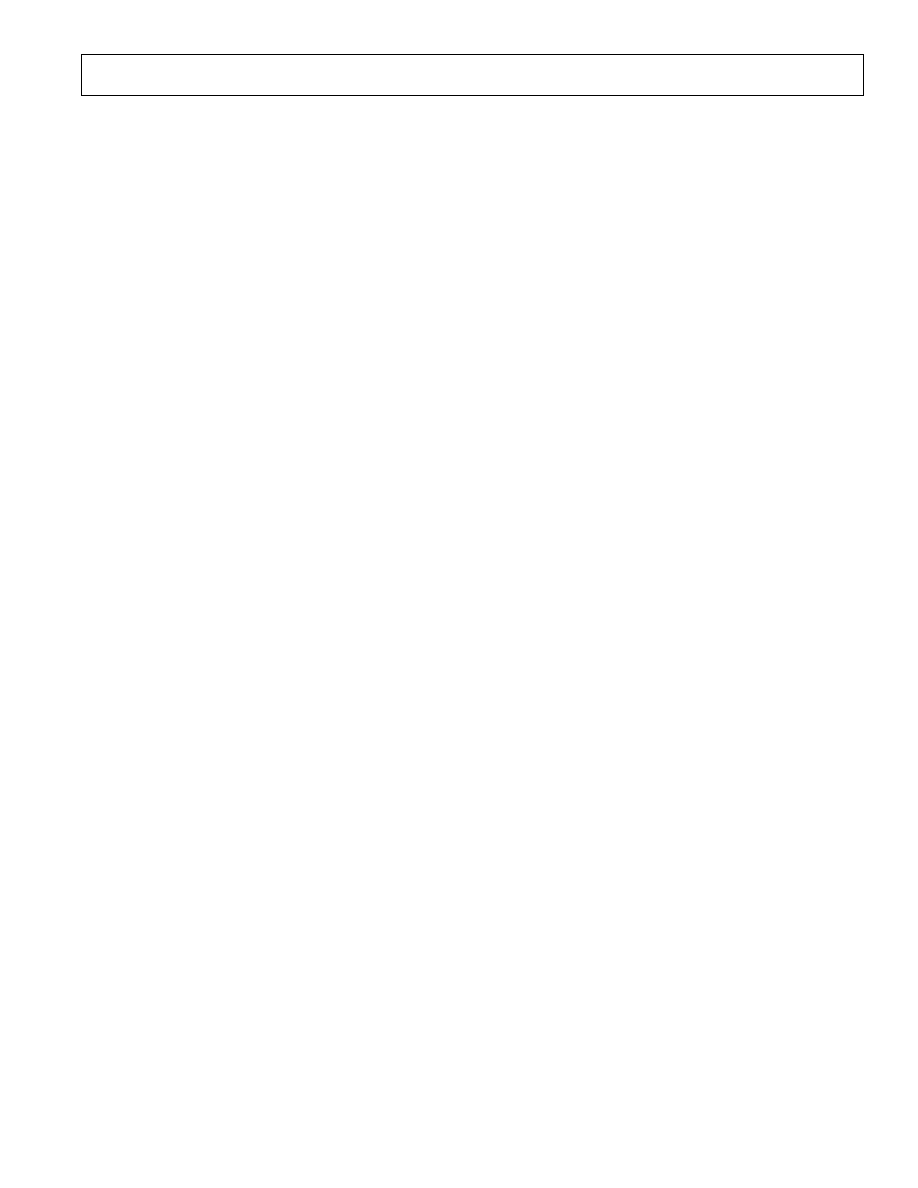
AD73322
35
REV. B
DSP SOFTWARE CONSIDERATIONS WHEN
INTERFACING TO THE AD73322
It is important when choosing the operating mode and hardware
configuration of the AD73322 to be aware of their implications
for DSP software operation. The user has the flexibility of
choosing from either FSLB or nonFSLB when deciding on DSP
to AFE connectivity. There is also a choice to be made between
using autobuffering of input and output samples or simply
choosing to accept them as individual interrupts. As most mod-
ern DSP engines support these modes, this appendix will at-
tempt to discuss these topics in a generic DSP sense.
Operating Mode
The AD73322 supports two basic operating modes: Frame Sync
Loop Back (FSLB) and nonFSLB (See Interfacing section). As
described previously, FSLB has some limitations when used in
Mixed Mode but is very suitable for use with the autobuffering
feature that is offered on many modern DSPs. Autobuffering
allows the user to specify the number of input or output words
(samples) that are transferred before a specific Tx or Rx SPORT
interrupt is generated. Given that the AD73322 outputs two
sample words per sample period, it is possible using autobuffer-
ing to have the DSP's SPORT generate a single interrupt on
receipt of the second of the two sample words. Additionally,
both samples could be stored in a data buffer within the data
memory store. This technique has the advantage of reducing the
number of both Tx and Rx SPORT interrupts to a single one at
each sample interval. The user also knows where each sample is
stored. The alternative is to handle a larger number of SPORT
interrupts (twice as many in the case of a single AD73322) while
also having some status flags to indicate where each new sample
comes from (or is destined for).
Mixed-Mode Operation
To take full advantage of mixed-mode operation, it is necessary
to configure the DSP/Codec interface in nonFSLB and to dis-
able autobuffering. This allows a variable numbers of words to
be sent to the AD73322 in each sample period--the extra words
being control words which are typically used to update gain
settings in adaptive control applications. The recommended
sequence for updating control registers in mixed-mode is to
send the control word(s) first before the DAC update word.
It is possible to use mixed-mode operation when configured in
FSLB, but it is necessary to replace the DAC update with a
control word write in each sample period which may cause some
discontinuity in the output signal due to a sample point being
missed and the previous sample being repeated. This however
may be acceptable in some cases as the effect may be masked by
gain changes, etc.
Interrupts
The AD73322 transfers and receives information over the serial
connection from the DSP's SPORT. This occurs following reset
--during the initialization phase--and in both data-mode and
mixed-mode. Each transfer of data to or from the DSP can
cause a SPORT interrupt to occur. However even in FSLB
configuration where serial transfers in and out of the DSP are
synchronous, it is important to note that Tx and Rx interrupts
do not occur at the same time due to the way that Tx and Rx
interrupts are generated internally within the DSP's SPORT.
This is especially important in time critical control loop applica-
tions where it may be necessary to use Rx interrupts only, as the
relative positioning of the Tx interrupts relative to the Rx inter-
rupts in a single sample interval are not suitable for quick up-
date of new DAC positions.
Initialization
Following reset, the AD73322 is in its default condition which
ensures that the device is in Control Mode and must be pro-
grammed or initialized from the DSP to start conversions. As
communications between AD73322 and the DSP are interrupt
driven, it is usually not practical to embed the initialization
codes into the body of the initialization routine. It is more prac-
tical to put the sequence of initialization codes in a data (or
program) memory buffer and to access this buffer with a pointer
that is updated on each interrupt. If a circular buffer is used, it
allows the interrupt routine to check when the circular buffer
pointer has wrapped around--at which point the initialization
sequence is complete.
In FSLB configurations, a single control word per codec per
sample period is sent to the AD73322 whereas in nonFSLB, it is
possible to initialize the device in a single sample period provide
the SCLK rate is programmed to a high rate. It is also possible
to use autobuffering in which case an interrupt is generated
when the entire initialization sequence has been sent to the
AD73322.
Running the AD73322 with ADCs or DACs in Power-Down
The programmability of the AD73322 allows the user flexibility
in choosing what sections of the AD73322 need be powered up.
This allows better matching of the power consumption to the
application requirements as the AD73322 offers two ADCs and
two DACs in any combination. The AD73322 always interfaces
to the DSP in a standard way regardless of what ADC or DAC
sections are enabled or disabled. Therefore the DSP will expect
to receive two ADC samples per sample period and to transmit
two DAC samples per sample period. If a particular ADC is
disabled (in power-down) then its sample value will be invalid.
Likewise a sample sent to a DAC which is disabled will have no
effect.
There are two distinct phases of operation of the AD73322:
initialization of the device via each codec section's control regis-
ters, and operation of the converter sections of each codec. The
initialization phase involves programming the control registers
of the AD73322 to ensure the required operating characteristics
such as sampling rate, serial clock rate, I/O gain, etc. There are
several ways in which the DSP can be programmed to initialize
the AD73322. These range from hard-coding a sequence of
DSP SPORT Tx register writes with constants used for the
initialization words, to putting the initialization sequence in a
circular data buffer and using an autobuffered transmit sequence.
Hard-coding involves creating a sequence of writes to the DSP's
SPORT Tx buffer which are separated by loops or instructions
that idle and wait for the next Tx interrupt to occur as shown in
the code below.
ax0
= b#1000100100000100;
tx0
= ax0;
idle; {wait for tx register to send current word}

AD73322
36
REV. B
The circular buffer approach can be useful if a long initialization
sequence is required. The list of initialization words is put into
the buffer in the required order.
.VAR/DM/RAM/CIRC
init_cmds[16];
{Codec init sequence}
.VAR/DM/RAM stat_flag;
.INIT
init_cmds:
b # 1 0 0 0 1 0 0 1 0 0 0 0 0 1 0 0 ,
b # 1 0 0 0 0 0 0 1 0 0 0 0 0 1 0 0 ,
b # 1 0 0 0 1 0 1 0 1 1 1 1 1 0 0 1 ,
b # 1 0 0 0 0 0 1 0 1 1 1 1 1 0 0 1 ,
b # 1 0 0 0 1 0 1 1 0 0 0 0 0 0 0 0 ,
b # 1 0 0 0 0 0 1 1 0 0 0 0 0 0 0 0 ,
b # 1 0 0 0 1 1 0 0 0 0 0 0 0 0 0 0 ,
b # 1 0 0 0 0 1 0 0 0 0 0 0 0 0 0 0 ,
b # 1 0 0 0 1 1 0 1 0 0 0 0 0 0 0 0 ,
b # 1 0 0 0 0 1 0 1 0 0 0 0 0 0 0 0 ,
b # 1 0 0 0 1 1 1 0 0 0 0 0 0 0 0 0 ,
b # 1 0 0 0 0 1 1 0 0 0 0 0 0 0 0 0 ,
b # 1 0 0 0 1 1 1 1 0 0 0 0 0 0 0 0 ,
b # 1 0 0 0 0 1 1 1 0 0 0 0 0 0 0 0 ,
b # 1 0 0 0 1 0 0 0 0 0 0 1 0 0 0 1 ,
b # 1 0 0 0 0 0 0 0 0 0 0 1 0 0 0 1 ;
and the DSP program initializes pointers to the top of the buffer
i3 = ^init_cmds; l3 = %init_cmds;
and puts the first entry in the DSP's transmit buffer so that it is
available at the first SDOFS pulse.
ax0 = dm(i3,m1);
tx0 = ax0;
The DSP's transmit interrupt is enabled.
imask = b#0001000000;
At each occurrence of an SDOFS pulse, the DSP's transmit
buffer contents are sent to the SDI pin of the AD73322. This
also causes a subsequent DSP Tx interrupt which transfers the
initialization word, pointed to by the circular buffer pointer, to
the Tx buffer. The buffer pointer is updated to point to the next
unsent initialization word. When the circular buffer pointer
wraps around which happens after the last word has been ac-
cessed, it indicates that the initialization phase is complete. This
can be done "manually" in the DSP using a simple address
check or autobuffered mode can be used to the complete trans-
fer automatically.
txcdat: ar = dm(stat_flag);
ar = pass ar;
if eq rti;
ena sec_reg;
ax0 = dm (i3, m1);
tx0 = ax0;
ax0 = i3;
ay0 = ^init_cmds;
ar = ax0 - ay0;
if gt rti;
ax0 = 0x00;
dm (stat_flag) = ax0;
rti;
In the main body of the program, the code loops waiting for the
initialization sequence to be completed.
check_init:
ax0 = dm (stat_flag);
af = pass ax0;
if ne jump check_init;
As the AD73322 is effectively a cascade of two codec units, it is
important to observe some restrictions in the sequence of send-
ing initialization words to the two codecs. It is preferable to send
pairs of control words for the corresponding control registers in
each codec and it is essential to send the control word for codec
2 before that for codec 1. Control Registers A and B contain
settings, such as sampling rate, serial clock rate etc., which
critically require synchronous update in both codecs.
Once the device has been initialized, Control Register A on both
codecs is written with a control word which changes the operat-
ing mode from Program Mode to either data mode or Mixed
Control Data Mode. The device count field which defaults to
000b will have to be programmed to 001b for a single AD73322
device. In data mode or mixed mode, the main function of the
device is to return ADC samples from both codecs and to accept
DAC words for both codecs. During each sample interval two
ADC samples will be returned from the device while in the same
interval two DAC update samples will be sent to the device. In
order to reduce the number of interrupts and to reduce com-
plexity, autobuffering can be used to ensure that only one inter-
rupt is generated during each sampling interval.
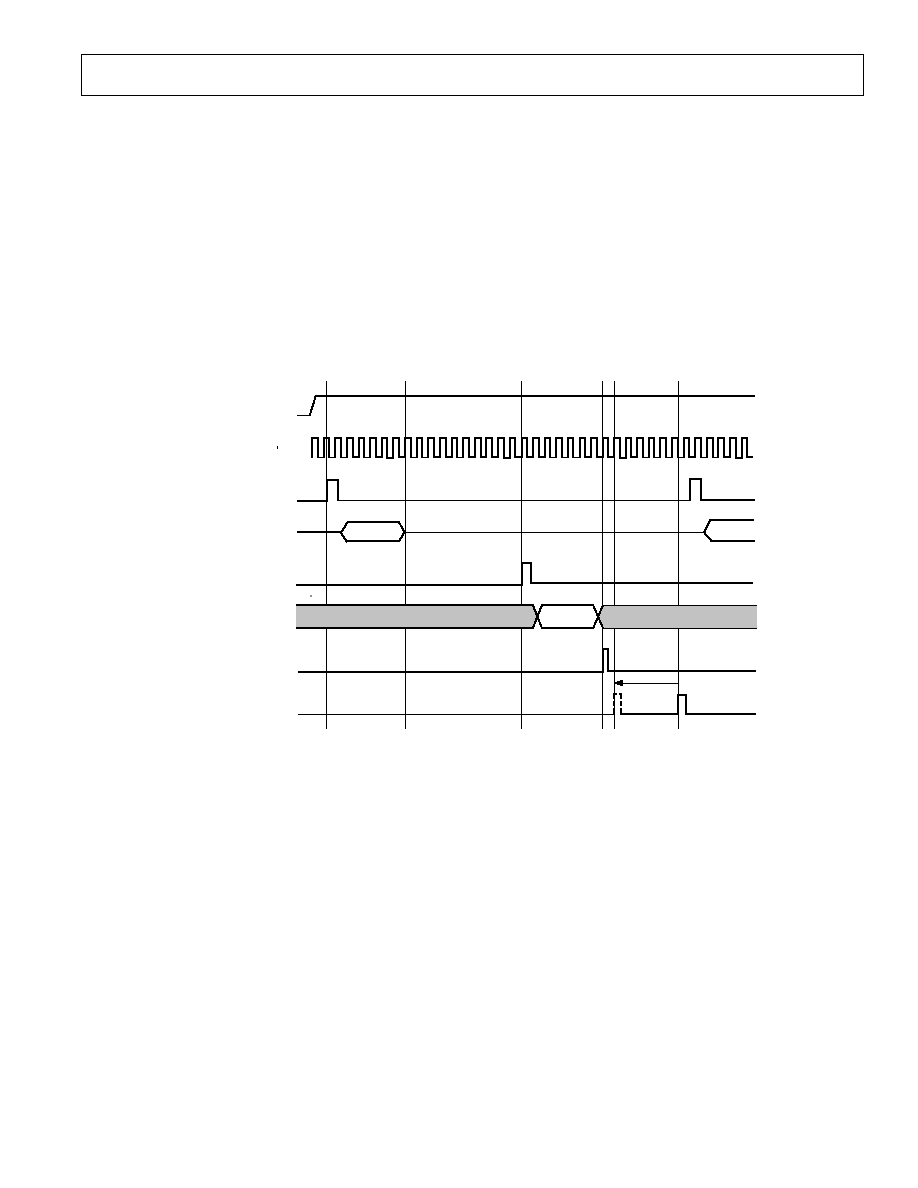
AD73322
37
REV. B
APPENDIX A
DAC Timing Control Example
The AD73322's DAC is loaded from the DAC register contents
just before the ADC register contents are loaded to the serial
register (SDOFS going high). This default DAC load position
can be advanced in time to occur earlier with respect to the
SDOFS going high. Figure 45 shows an example of the ADC
unload and DAC load sequence. At time t
1
the SDOFS is raised
to indicate that a new ADC word is ready. Following the SDOFS
pulse, 16 bits of ADC data are clocked out on SDO in the sub-
sequent 16 SCLK cycles finishing at time t
2
where the DSP's
SPORT will have received the 16-bit word. The DSP may
process this information and generate a DAC word to be sent to
SE
SCLK
SDOFS
SDO
SDIFS
DATA REGISTER
UPDATE
DAC LOAD
FROM DAC REGISTER
t
1
t
2
t
3
t
4
t
6
t
5
ADC WORD
SDI
DAC WORD
Figure 43. DAC Timing Control
the AD73322. Time t
3
marks the beginning of the sequence of
sending the DAC word to the AD73322. This sequence ends at
time t
4
where the DAC register will be updated from the 16 bits
in the AD73322's serial register. However, the DAC will not be
updated from the DAC register until time t
5
, which may not be
acceptable in certain applications. In order to reduce this delay
and load the DAC at time t
6
, the DAC advance register can be
programmed with a suitable setting corresponding to the
required time advance (refer to Table XI for details of DAC
Timing Control settings).

AD73322
38
REV. B
APPENDIX B
Configuring an AD73322 to Operate in Data Mode
1
This section describes the typical sequence of control words
that are required to be sent to an AD73322 to set it up for data
mode operation. In this sequence Registers B, C and A are
programmed before the device enters data mode. This descrip-
tion panel refers to Table XXIII.
At each sampling event, a pair of SDOFS pulses will be ob-
served which will cause a pair of control (programming) words
to be sent to the device from the DSP. It is advisable that each
pair of control words should program a single register in each
Channel. The sequence to be followed is Channel 2 followed by
Channel 1.
In Step 1, we have the first output sample event following de-
vice reset. The SDOFS signal is raised on both channels
2
simul-
taneously, which prepares the DSP Rx register to accept the
ADC word from Channel 2, while SDOFS from Channel 1
becomes an SDIFS to Channel 2. As the SDOFS of Channel 2
is coupled to the DSP's TFS and RFS, and to the SDIFS of
Channel 1, this event also forces a new control word to be out-
put from the DSP Tx register to Channel 1
3
.
In Step 2, we observe the status of the channels following the
transmission of the first control word. The DSP has received
the output word from Channel 2, while Channel 2 has received
the output word from Channel 1. Channel 1 has received the
Control word destined for Channel 2. At this stage, the SDOFS
of both channels are again raised because Channel 2 has received
Channel 1's output word, and as it is not a valid control word
addressed to Channel 2, it is passed on to the DSP. Likewise,
Channel 1 has received a control word destined for Channel
2--address field is not zero--and it decrements the address field
of the control word and passes it on.
Step 3 shows completion of the first series of control word
writes. The DSP has now received both output words and each
channel has received a control word that addresses control
register B and sets the internal MCLK divider ratio to 1, SCLK
rate to DMCLK/2 and sampling rate to DMCLK/256. Note
that both channels are updated simultaneously as both receive
the addressed control word at the same time. This is an impor-
tant factor in cascaded operation as any latency between updat-
ing the SCLK or DMCLK of channels can result in corrupted
operation. This will not happen in the case of an FSLB configu-
ration as shown here, but must be taken into account in a non-
FSLB configuration. One other important observation of this
sequence is that the data words are received and transmitted in
reverse order, i.e., the ADC words are received by the DSP,
Channel 2 first, then Channel 1 and, similarly, the transmit
words from the DSP are sent to Channel 2 first, then to Chan-
nel 1. This ensures that all channels are updated at the same time.
Steps 46 are similar to Steps 13 but, instead, program Control
Register C to power-up the analog sections of the device (ADCs,
DACs and reference).
Steps 79 are similar to Steps 13 but, instead, program Control
Register A, with a device count field equal to two channels in
cascade and sets the PGM/DATA bit to one to put the channel
in data mode.
In Step 10, the programming phase is complete and we now
begin actual channel data read and write. The words loaded into
the serial registers of the two channels at the ADC sampling
event now contain valid ADC data and the words written to the
channels from the DSP's Tx register will now be interpreted as
DAC words. The DSP Tx register contains the DAC word for
Channel 2.
In Step 11, the first DAC word has been transmitted into the
cascade and the ADC word from Channel 2 has been read from
the cascade. The DSP Tx register now contains the DAC word
for Channel 1. As the words being sent to the cascade are now
being interpreted as 16-bit DAC words, the addressing scheme
now changes from one where the address was embedded in the
transmitted word, to one where the serial port now counts the
SDIFS pulses. When the number of SDIFS pulses received
equals the value in the channel count field of Control Register
A, the length of the cascade--each channel updates its DAC
register with the present word in its serial register. In Step 11
each channel has received only one SDIFS pulse; Channel 2
received one SDIFS from the SDOFS of Channel 1 when it sent
its ADC word, and Channel 1 received one SDIFS pulse when
it received the DAC word for Channel 2 from the DSP's Tx regis-
ter. Therefore, each channel raises its SDOFS line to pass on the
current word in its serial register, and each channel now receives
another SDIFS pulse.
Step 12 shows the completion of an ADC read and DAC write
cycle. Following Step 11, each channel has received two SDIFS
pulses that equal the setting of the channel count field in Con-
trol Register A. The DAC register in each channel is now up-
dated with the contents of the word that accompanied the SDIFS
pulse that satisfied the channel count requirement. The internal
frame sync counter is now reset to zero and will begin counting
for the next DAC update cycle.
Steps 1012 are repeated on each sampling event.
NOTES
1
Channel 1 and Channel 2 of the description refer to the two AFE sections of
the AD73322 device.
2
The AD73322 is configured as two channels in cascade. The internal cascade
connections between Channels 1 and 2 are detailed in Figure 14. The connec-
tions SDI/SDIFS are inputs to Channel 1 while SDO/SDOFS are outputs from
Channel 2.
3
This sequence assumes that the DSP SPORT's Rx and Tx interrupts are
enabled. It is important to ensure that there is no latency (separation) between
control words in a cascade configuration. This is especially the case when
programming Control Registers A and B as they must be updated synchro-
nously in each channel.
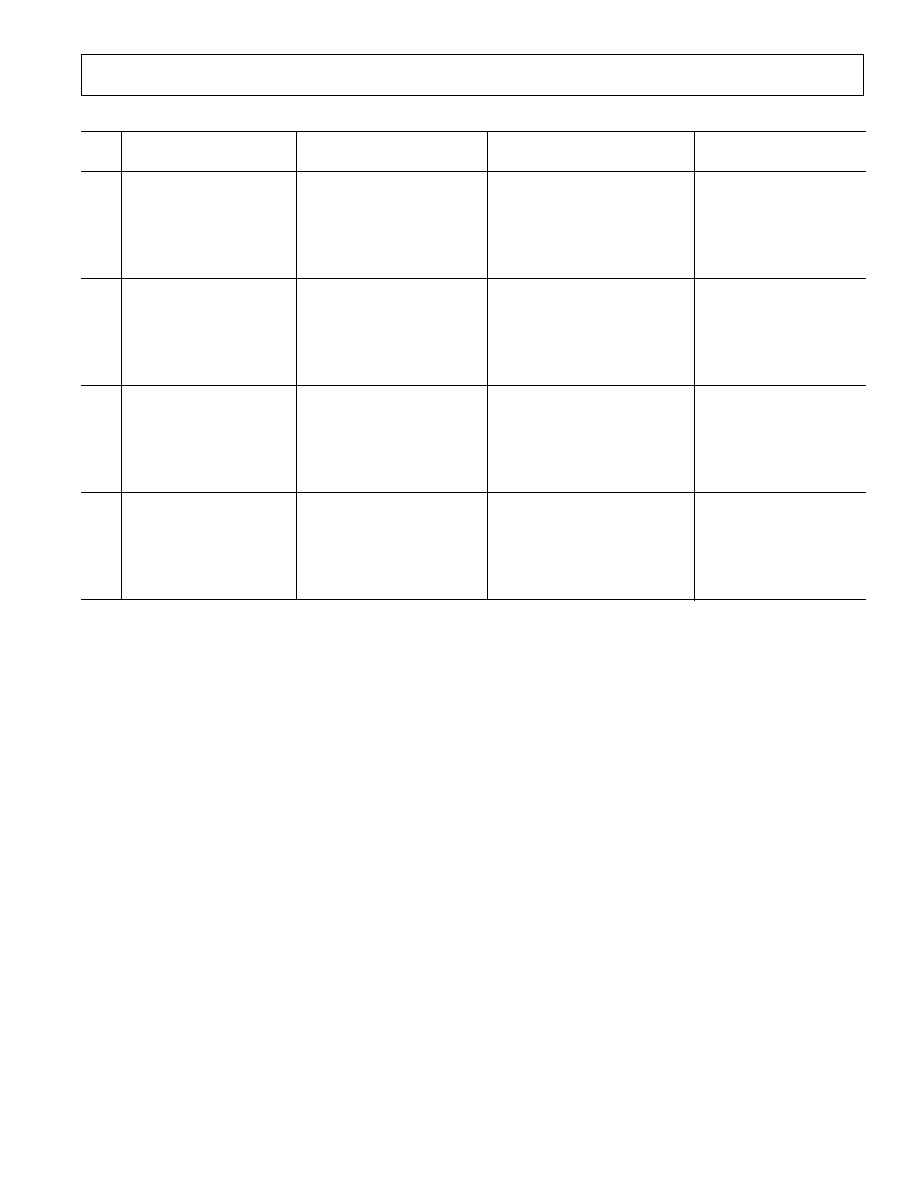
AD73322
39
REV. B
Table XXIII. Data Mode Operation
DSP
AD73322
AD73322
DSP
Step
Tx
Channel 1
Channel 2
Rx
1
CRBCH2
OUTPUT CH1
OUTPUT CH2
DON'T CARE
1000100100001011
0000000000000000
0000000000000000
xxxxxxxxxxxxxxxx
2
CRBCH1
CRBCH2
OUTPUT CH1
OUTPUT CH2
1000000100001011
1000100100001011
0000000000000000
0000000000000000
3
CRCCH2
CRBCH1
CRBCH2
OUTPUT CH1
1000101011111001
1000000100001011
1000000100001011
0000000000000000
4
CRCCH2
OUTPUT CH1
OUTPUT CH2
DON'T CARE
1000101011111001
1000000100001011
1000000100001011
xxxxxxxxxxxxxxxx
5
CRCCH1
CRCCH2
OUTPUT CH2
OUTPUT CH2
1000001011111001
1000101011111001
1011100100001011
1011100100001011
6
CRACH2
CRC-CH1
CRCCH2
OUTPUT CH1
1000100000010001
1000001011111001
1000001011111001
1011000100001011
7
CRACH2
OUTPUT CH1
OUTPUT CH2
DON'T CARE
1000100000010001
1000001011111001
1000001011111001
xxxxxxxxxxxxxxxx
8
CRACH1
CRA-CH2
OUTPUT CH2
OUTPUT CH2
1000000000010001
1000100000010001
1011101011111001
1011101011111001
9
CRB-CH2
CRA-CH1
CRACH2
OUTPUT CH1
0111111111111111
1000000000010001
1000000000010001
1011001011111001
10
DAC WORD CH 2
ADC RESULT CH1
ADC RESULT CH2
DON'T CARE
0111111111111111
????????????????
????????????????
xxxxxxxxxxxxxxxx
11
DAC WORD CH 1
DAC WORD CH 2
ADC RESULT CH1
ADC RESULT CH2
1000000000000000
0111111111111111
????????????????
????????????????
12
DON'T CARE
DAC WORD CH 1
DAC WORD CH 2
ADC RESULT CH1
xxxxxxxxxxxxxxxx
1000000000000000
0111111111111111
????????????????

AD73322
40
REV. B
APPENDIX C
Configuring an AD73322 to Operate in Mixed Mode
1
This section describes a typical sequence of control words that
would be sent to an AD73322 to configure it for operation in
mixed mode. It is not intended to be a definitive initialization
sequence, but will show users the typical input/output events
that occur in the programming and operation phases
2
. This
description panel refers to Table XXIV.
Steps 15 detail the transfer of the control words to Control
Register A, which programs the device for Mixed-Mode opera-
tion. In Step 1, we have the first output sample event following
device reset. The SDOFS signal is simultaneously raised on
both channels, which prepares the DSP Rx register to accept the
ADC word from Channel 2 while SDOFS from Channel 1
becomes an SDIFS to Channel 2. The cascade is configured
as nonFSLB, which means that the DSP has control over
what is transmitted to the cascade
3
and in this case we will not
transmit to the devices until both output words have been re-
ceived from the AD73322.
In Step 2, we observe the status of the channels following the
reception of the Channel 2 output word. The DSP has received
the ADC word from Channel 2, while Channel 2 has received
the output word from Channel 1. At this stage, the SDOFS of
Channel 2 is again raised because Channel 2 has received Chan-
nel 1's output word and, as it is not addressed to Channel 2, it
is passed on to the DSP.
In Step 3 the DSP has now received both ADC words. Typi-
cally, an interrupt will be generated following reception of the
two output words by the DSP (this involves programming the
DSP to use autobuffered transfers of two words). The transmit
register of the DSP is loaded with the control word destined for
Channel 2. This generates a transmit frame-sync (TFS) that is
input to the SDIFS input of the AD73322 to indicate the start
of transmission.
In Step 4, Channel 1 now contains the Control Word destined
for Channel 2. The address field is decremented, SDOFS1 is
raised (internally) and the Control word is passed on to Chan-
nel 2. The Tx register of the DSP has now been updated with
the Control Word destined for Channel 1 (this can be done
using autobuffering of transmit or by handling transmit inter-
rupts following each word sent).
In Step 5 each channel has received a control word that ad-
dresses Control Register A and sets the device count field equal
to two channels and programs the channels into Mixed Mode--
MM and PGM/DATA set to one.
Following Step 5, the device has been programmed into mixed-
mode although none of the analog sections have been powered
up (controlled by Control Register C). Steps 610 detail update
of Control register B in mixed-mode. In Steps 68, the ADC
samples, which are invalid as the ADC section is not yet powered
up, are transferred to the DSP's Rx section. In the subsequent
interrupt service routine the Tx register is loaded with the con-
trol word for Channel 2. In Steps 910, Channels 1 and 2 are
loaded with a control word setting for Control Register B which
programs DMCLK = MCLK, the sampling rate to
DMCLK/256, SCLK = DMCLK/2.
Steps 1117 are similar to Steps 612 except that Control Reg-
ister C is programmed to power up all analog sections (ADC,
DAC, Reference = 2.4 V, REFOUT). In Steps 1617, DAC
words are sent to the device--both DAC words are necessary as
each channel will only update its DAC when the device has
counted a number of SDIFS pulses, accompanied by DAC
words (in mixed-mode, the MSB = 0), that is equal to the de-
vice count field of Control Register A
4
. As the channels are in
mixed mode, the serial port interrogates the MSB of the 16-bit
word sent to determine whether it contains DAC data or control
information. DAC words should be sent in the sequence Chan-
nel 2 followed by Channel 1.
Steps 1117 illustrate the implementation of Control Register
update and DAC update in a single sample period. Note that
this combination is not possible in the FSLB configuration
3
.
Steps 1825 illustrate a Control Register readback cycle. In Step
22, both channels have received a Control Word that addresses
Control Register C for readback (Bit 14 of the Control Word =
1). When the channels receive the readback request, the register
contents are loaded to the serial registers as shown in Step 23.
SDOFS is raised in both channels, which causes these readback
words to be shifted out toward the DSP. In Step 24, the DSP
has received the Channel 2 readback word while Channel 2 has
received the Channel 1 readback word (note that the address
field in both words has been decremented to 111b). In Step 25,
the DSP has received the Channel 1 readback word (its ad-
dress field has been further decremented to 110b).
Steps 2630 detail an ADC and DAC update cycle using the
nonFSLB configuration. In this case no Control Register update
is required.
NOTES
1
Channel 1 and Channel 2 of the description refer to the two AFE sections of
the AD73322 device.
2
This sequence assumes that the DSP SPORT's Rx and Tx interrupts are
enabled. It is important to ensure there is no latency (separation) between
control words in a cascade configuration. This is especially the case when
programming Control Registers A and B.
3
Mixed mode operation with the FSLB configuration is more restricted in that
the number of words sent to the cascade equals the number of channels in the
cascade, which means that DAC updates may need to be substituted with a
register write or read. Using the FSLB configuration introduces a corruption of
the ADC samples in the sample period following a Control Register write. This
corruption is predictable and can be corrected in the DSP. The ADC word is
treated as a Control Word and the Device Address field is decremented in each
channel that it passes through before being returned to the DSP.
4
In mixed mode, DAC update is done using the same SDIFS counting scheme
as in normal data mode with the exception that only DAC words (MSB set to
zero) are recognized as being able to increment the frame sync counters.
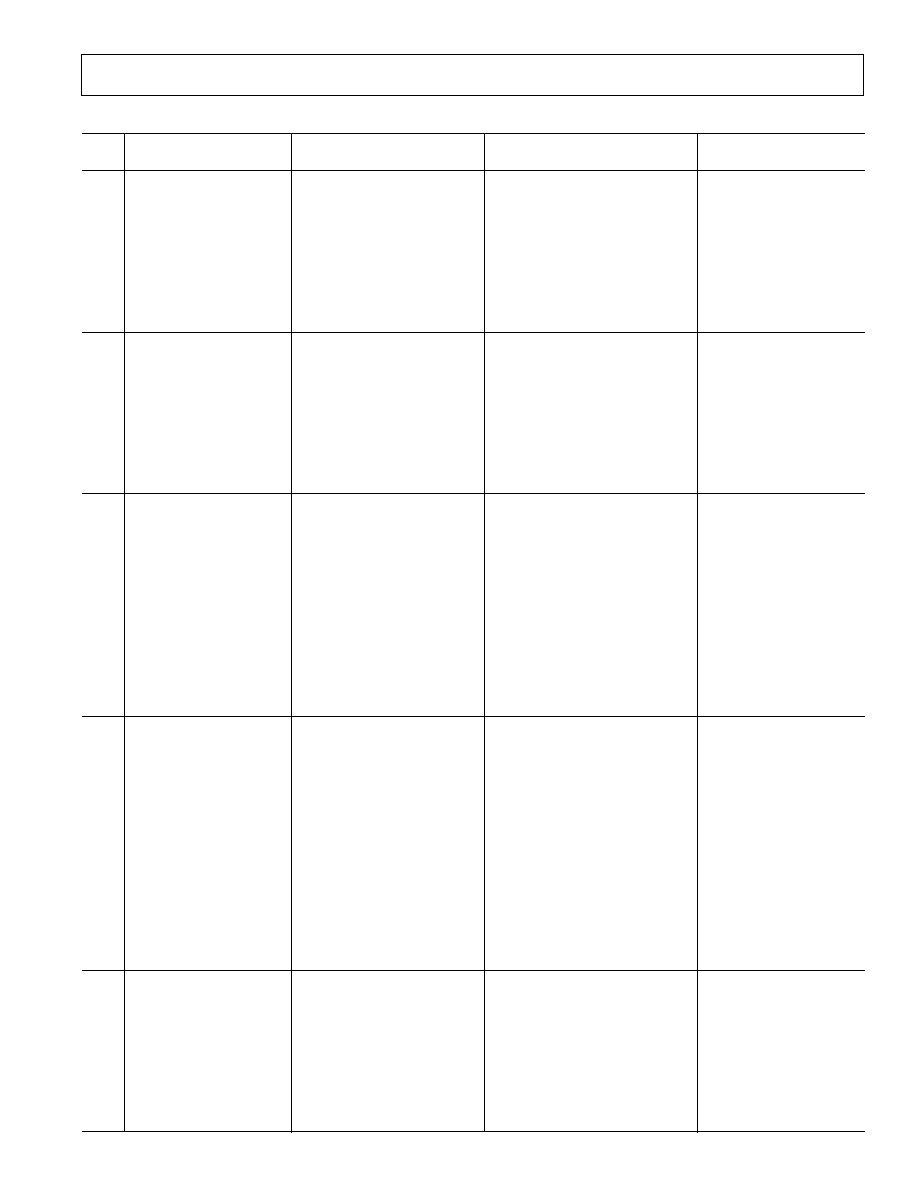
AD73322
41
REV. B
Table XXIV. Mixed Mode Operation
DSP
AD73322
AD73322
DSP
Step
Tx
Channel 1
Channel 2
Rx
DON'T CARE
OUTPUT CH1
OUTPUT CH2
DON'T CARE
1
xxxxxxxxxxxxxxxx
0000000000000000
0000000000000000
xxxxxxxxxxxxxxxx
DON'T CARE
DON'T CARE
OUTPUT CH1
OUTPUT CH2
2
xxxxxxxxxxxxxxxx
xxxxxxxxxxxxxxxx
0000000000000000
0000000000000000
CRA-CH2
DON'T CARE
DON'T CARE
OUTPUT CH1
3
1000101011111001
xxxxxxxxxxxxxxxx
xxxxxxxxxxxxxxxx
0000000000000000
CRA-CH1
CRA-CH2
DON'T CARE
DON'T CARE
4
1000000000010011
1000100000010011
xxxxxxxxxxxxxxxx
xxxxxxxxxxxxxxxx
DON'T CARE
CRA-CH1
CRA-CH2
DON'T CARE
5
xxxxxxxxxxxxxxxx
1000000000010011
1000000000010011
xxxxxxxxxxxxxxxx
DON'T CARE
ADC RESULT CH1
ADC RESULT CH2
DON'T CARE
6
xxxxxxxxxxxxxxxx
0000000000000000
0000000000000000
xxxxxxxxxxxxxxxx
DON'T CARE
DON'T CARE
ADC RESULT CH1
ADC RESULT CH2
7
xxxxxxxxxxxxxxxx
xxxxxxxxxxxxxxxx
0000000000000000
0000000000000000
CRB-CH2
DON'T CARE
DON'T CARE
ADC RESULT CH1
8
1000100100001011
xxxxxxxxxxxxxxxx
xxxxxxxxxxxxxxxx
0000000000000000
CRB-CH1
CRB-CH2
DON'T CARE
DON'T CARE
9
1000000100001011
1000100100001011
xxxxxxxxxxxxxxxx
xxxxxxxxxxxxxxxx
DON'T CARE
CRB-CH1
CRB-CH2
DON'T CARE
10
xxxxxxxxxxxxxxxx
1000000100001011
1000000100001011
xxxxxxxxxxxxxxxx
DON'T CARE
ADC RESULT CH1
ADC RESULT CH2
DON'T CARE
11
xxxxxxxxxxxxxxxx
0000000000000000
0000000000000000
xxxxxxxxxxxxxxxx
DON'T CARE
DON'T CARE
ADC RESULT CH1
ADC RESULT CH2
12
xxxxxxxxxxxxxxxx
xxxxxxxxxxxxxxxx
0000000000000000
0000000000000000
CRC-CH2
DON'T CARE
DON'T CARE
ADC RESULT CH1
13
1000101011111001
xxxxxxxxxxxxxxxx
xxxxxxxxxxxxxxxx
0000000000000000
CRC-CH1
CRC-CH2
DON'T CARE
DON'T CARE
14
1000001011111001
1000101011111001
xxxxxxxxxxxxxxxx
xxxxxxxxxxxxxxxx
DAC WORD CH 2
CRC-CH1
CRC-CH2
DON'T CARE
15
0111111111111111
1000001011111001
1000001011111001
xxxxxxxxxxxxxxxx
DAC WORD CH 1
DAC WORD CH 2
DON'T CARE
DON'T CARE
16
1000000000000000
0111111111111111
xxxxxxxxxxxxxxxx
xxxxxxxxxxxxxxxx
DON'T CARE
DAC WORD CH 1
DAC WORD CH 2
DON'T CARE
17
xxxxxxxxxxxxxxxx
1000000000000000
0111111111111111
xxxxxxxxxxxxxxxx
DON'T CARE
ADC RESULT CH1
ADC RESULT CH2
DON'T CARE
18
xxxxxxxxxxxxxxxx
0000000000000000
0000000000000000
xxxxxxxxxxxxxxxx
DON'T CARE
DON'T CARE
ADC RESULT CH1
ADC RESULT CH2
19
xxxxxxxxxxxxxxxx
xxxxxxxxxxxxxxxx
0000000000000000
0000000000000000
CRC-CH2
DON'T CARE
DON'T CARE
ADC RESULT CH1
20
11001010xxxxxxxx
xxxxxxxxxxxxxxxx
xxxxxxxxxxxxxxxx
0000000000000000
CRC-CH1
CRC-CH2
DON'T CARE
DON'T CARE
21
10000010xxxxxxxx
11001010xxxxxxxx
xxxxxxxxxxxxxxxx
xxxxxxxxxxxxxxxx
DON'T CARE
CRC-CH1
CRC-CH2
DON'T CARE
22
xxxxxxxxxxxxxxxx
10000010xxxxxxxx
10000010xxxxxxxx
xxxxxxxxxxxxxxxx
DON'T CARE
READBACK CH 1
READBACK CH 2
DON'T CARE
23
xxxxxxxxxxxxxxxx
1100001011111001
1100001011111001
xxxxxxxxxxxxxxxx
DON'T CARE
DON'T CARE
READBACK CH 1
READBACK CH 2
24
xxxxxxxxxxxxxxxx
xxxxxxxxxxxxxxxx
1111101011111001
1111101011111001
DON'T CARE
DON'T CARE
DON'T CARE
READBACK CH 1
25
xxxxxxxxxxxxxxxx
xxxxxxxxxxxxxxxx
xxxxxxxxxxxxxxxx
1111001011111001
DON'T CARE
ADC RESULT CH1
ADC RESULT CH2
DON'T CARE
26
xxxxxxxxxxxxxxxx
????????????????
????????????????
xxxxxxxxxxxxxxxx
DON'T CARE
DON'T CARE
ADC RESULT CH1
ADC RESULT CH2
27
xxxxxxxxxxxxxxxx
xxxxxxxxxxxxxxxx
????????????????
????????????????
DAC WORD CH 2
DON'T CARE
DON'T CARE
ADC RESULT CH1
28
0111111111111111
xxxxxxxxxxxxxxxx
xxxxxxxxxxxxxxxx
????????????????
DAC WORD CH 1
DAC WORD CH 2
DON'T CARE
DON'T CARE
29
1000000000000000
0111111111111111
xxxxxxxxxxxxxxxx
xxxxxxxxxxxxxxxx
DON'T CARE
DAC WORD CH 1
DAC WORD CH 2
DON'T CARE
30
xxxxxxxxxxxxxxxx
1000000000000000
0111111111111111
xxxxxxxxxxxxxxxx

AD73322
42
REV. B
Topic
Page
FEATURES . . . . . . . . . . . . . . . . . . . . . . . . . . . . . . . . . . . . . 1
FUNCTIONAL BLOCK DIAGRAM . . . . . . . . . . . . . . . . . 1
GENERAL DESCRIPTION . . . . . . . . . . . . . . . . . . . . . . . . . 1
SPECIFICATIONS (3 V) . . . . . . . . . . . . . . . . . . . . . . . . . . . 2
SPECIFICATIONS (5 V) . . . . . . . . . . . . . . . . . . . . . . . . . . . 5
TIMING CHARACTERISTICS (3 V) . . . . . . . . . . . . . . . . . 8
TIMING CHARACTERISTICS (5 V) . . . . . . . . . . . . . . . . . 9
Timing Diagrams . . . . . . . . . . . . . . . . . . . . . . . . . . . . . . . . 9
ABSOLUTE MAXIMUM RATINGS . . . . . . . . . . . . . . . . 10
ORDERING GUIDE . . . . . . . . . . . . . . . . . . . . . . . . . . . . . 10
PIN CONFIGURATIONS . . . . . . . . . . . . . . . . . . . . . . . . . 10
PIN FUNCTION DESCRIPTIONS . . . . . . . . . . . . . . . . . 11
TERMINOLOGY . . . . . . . . . . . . . . . . . . . . . . . . . . . . . . . . 12
ABBREVIATIONS . . . . . . . . . . . . . . . . . . . . . . . . . . . . . . . 12
TYPICAL PERFORMANCE CHARACTERISTICS . . . . 13
FUNCTIONAL DESCRIPTION . . . . . . . . . . . . . . . . . . . . 14
Encoder Channels . . . . . . . . . . . . . . . . . . . . . . . . . . . . . . 14
Programmable Gain Amplifier . . . . . . . . . . . . . . . . . . . . . 14
ADC . . . . . . . . . . . . . . . . . . . . . . . . . . . . . . . . . . . . . . . . 15
Analog Sigma-Delta Modulator . . . . . . . . . . . . . . . . . . . . 15
Decimation Filter . . . . . . . . . . . . . . . . . . . . . . . . . . . . . . . 16
ADC Coding . . . . . . . . . . . . . . . . . . . . . . . . . . . . . . . . . . 16
Decoder Channel . . . . . . . . . . . . . . . . . . . . . . . . . . . . . . . 16
DAC Coding . . . . . . . . . . . . . . . . . . . . . . . . . . . . . . . . . . 16
Interpolation Filter . . . . . . . . . . . . . . . . . . . . . . . . . . . . . . 16
Analog Smoothing Filter and PGA . . . . . . . . . . . . . . . . . 16
Differential Output Amplifiers . . . . . . . . . . . . . . . . . . . . . 17
Voltage Reference . . . . . . . . . . . . . . . . . . . . . . . . . . . . . . 17
Analog and Digital Gain Taps . . . . . . . . . . . . . . . . . . . . . 17
Analog Gain Tap . . . . . . . . . . . . . . . . . . . . . . . . . . . . . . . 17
Digital Gain Tap . . . . . . . . . . . . . . . . . . . . . . . . . . . . . . . 18
Serial Port (SPORT) . . . . . . . . . . . . . . . . . . . . . . . . . . . . 18
SPORT Overview . . . . . . . . . . . . . . . . . . . . . . . . . . . . . . . 18
SPORT Register Maps . . . . . . . . . . . . . . . . . . . . . . . . . . . 19
Master Clock Divider . . . . . . . . . . . . . . . . . . . . . . . . . . . . 19
Serial Clock Rate Divider . . . . . . . . . . . . . . . . . . . . . . . . . 19
Sample Rate Divider . . . . . . . . . . . . . . . . . . . . . . . . . . . . 19
DAC Advance Register . . . . . . . . . . . . . . . . . . . . . . . . . . 19
Topic
Page
OPERATION . . . . . . . . . . . . . . . . . . . . . . . . . . . . . . . . . . . 24
Resetting the AD73322 . . . . . . . . . . . . . . . . . . . . . . . . . . 24
Power Management . . . . . . . . . . . . . . . . . . . . . . . . . . . . . 24
Operating Modes . . . . . . . . . . . . . . . . . . . . . . . . . . . . . . . 24
Program (Control) Mode . . . . . . . . . . . . . . . . . . . . . . . . . 24
Data Mode . . . . . . . . . . . . . . . . . . . . . . . . . . . . . . . . . . . . 24
Mixed Program/Data Mode . . . . . . . . . . . . . . . . . . . . . . . 25
Digital Loop-Back . . . . . . . . . . . . . . . . . . . . . . . . . . . . . . 25
SPORT Loop-Back . . . . . . . . . . . . . . . . . . . . . . . . . . . . . 25
Analog Loop-Back . . . . . . . . . . . . . . . . . . . . . . . . . . . . . . 25
INTERFACING . . . . . . . . . . . . . . . . . . . . . . . . . . . . . . . . . 26
Cascade Operation . . . . . . . . . . . . . . . . . . . . . . . . . . . . . . 26
PERFORMANCE . . . . . . . . . . . . . . . . . . . . . . . . . . . . . . . . 27
Encoder Section . . . . . . . . . . . . . . . . . . . . . . . . . . . . . . . . 27
Encoder Group Delay . . . . . . . . . . . . . . . . . . . . . . . . . . . 28
Decoder Section . . . . . . . . . . . . . . . . . . . . . . . . . . . . . . . . 28
Decoder Group Delay . . . . . . . . . . . . . . . . . . . . . . . . . . . 29
On-Chip Filtering . . . . . . . . . . . . . . . . . . . . . . . . . . . . . . 29
DESIGN CONSIDERATIONS . . . . . . . . . . . . . . . . . . . . . 30
Analog Inputs . . . . . . . . . . . . . . . . . . . . . . . . . . . . . . . . . . 30
Interfacing to an Electret Microphone . . . . . . . . . . . . . . . 32
Analog Output . . . . . . . . . . . . . . . . . . . . . . . . . . . . . . . . . 32
Differential to Single-Ended Output . . . . . . . . . . . . . . . . 32
Digital Interfacing . . . . . . . . . . . . . . . . . . . . . . . . . . . . . . 33
Cascade Operation . . . . . . . . . . . . . . . . . . . . . . . . . . . . . . 33
Grounding and Layout . . . . . . . . . . . . . . . . . . . . . . . . . . . 34
DSP PROGRAMMING CONSIDERATIONS . . . . . . . . . 34
DSP SPORT Configuration . . . . . . . . . . . . . . . . . . . . . . . 34
DSP SPORT Interrupts . . . . . . . . . . . . . . . . . . . . . . . . . . 34
DSP SOFTWARE CONSIDERATIONS WHEN
INTERFACING TO THE AD73322 . . . . . . . . . . . . . . . 35
Operating Mode . . . . . . . . . . . . . . . . . . . . . . . . . . . . . . . 35
Mixed-Mode Operation . . . . . . . . . . . . . . . . . . . . . . . . . . 35
Interrupts . . . . . . . . . . . . . . . . . . . . . . . . . . . . . . . . . . . . . 35
Initialization . . . . . . . . . . . . . . . . . . . . . . . . . . . . . . . . . . . 35
Running the AD73322 with ADCs
or DACs in Power-Down . . . . . . . . . . . . . . . . . . . . . . . 35
APPENDIX A . . . . . . . . . . . . . . . . . . . . . . . . . . . . . . . . . . . 37
(DAC Timing Control Example) . . . . . . . . . . . . . . . . . . . . 37
APPENDIX B . . . . . . . . . . . . . . . . . . . . . . . . . . . . . . . . . . . 38
Configuring an AD73322 to Operate in Data Mode . . . . 38
APPENDIX C . . . . . . . . . . . . . . . . . . . . . . . . . . . . . . . . . . 40
Configuring an AD73322 to Operate in Mixed Mode . . . . 40
OUTLINE DIMENSIONS . . . . . . . . . . . . . . . . . . . . . . . . 43
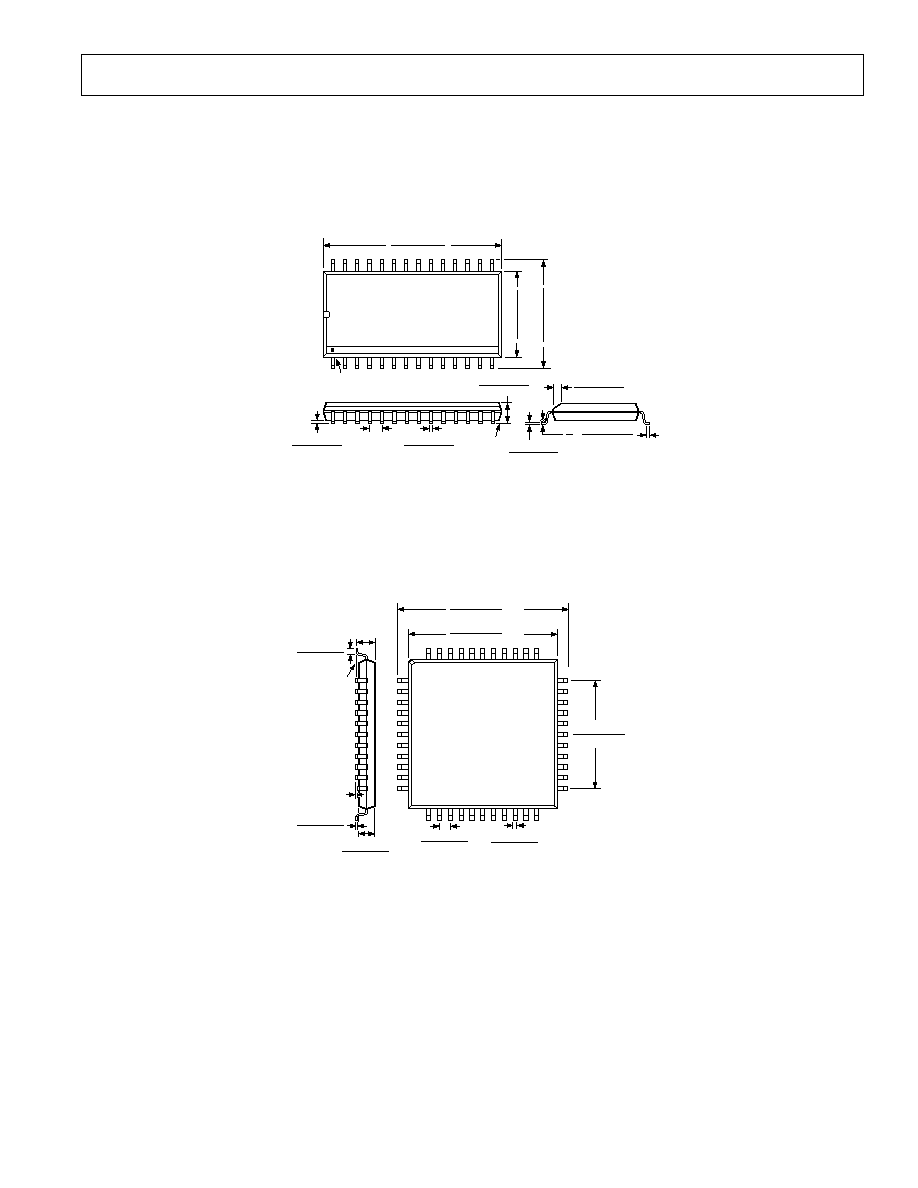
AD73322
43
REV. B
28-Lead Wide Body SOIC
(R-28)
SEATING
PLANE
0.0118 (0.30)
0.0040 (0.10)
0.0192 (0.49)
0.0138 (0.35)
0.1043 (2.65)
0.0926 (2.35)
0.0500
(1.27)
BSC
0.0125 (0.32)
0.0091 (0.23)
0.0500 (1.27)
0.0157 (0.40)
8
0
0.0291 (0.74)
0.0098 (0.25)
45
0.7125 (18.10)
0.6969 (17.70)
0.4193 (10.65)
0.3937 (10.00)
0.2992 (7.60)
0.2914 (7.40)
PIN 1
28
15
14
1
44-Lead Plastic Thin Quad Flatpack (LQFP)
(ST-44A)
TOP VIEW
(PINS DOWN)
1
11
12
23
22
33
34
44
0.640 (16.25)
0.620 (15.75)
SQ
0.553 (14.05)
0.549 (13.95)
SQ
0.016 (0.40)
0.012 (0.30)
0.042 (1.07)
0.037 (0.93)
0.397 (10.07)
0.391 (9.93)
SQ
0.063 (1.60)
MAX
0.030 (0.75)
0.019 (0.50)
SEATING
PLANE
0.006 (0.15)
0.002 (0.05)
0.004 (0.10)
MAX
0.057 (1.45)
0.053 (1.35)
OUTLINE DIMENSIONS
Dimensions shown in inches and (mm).
C3320a02/00 (rev. B)
PRINTED IN U.S.A.










































